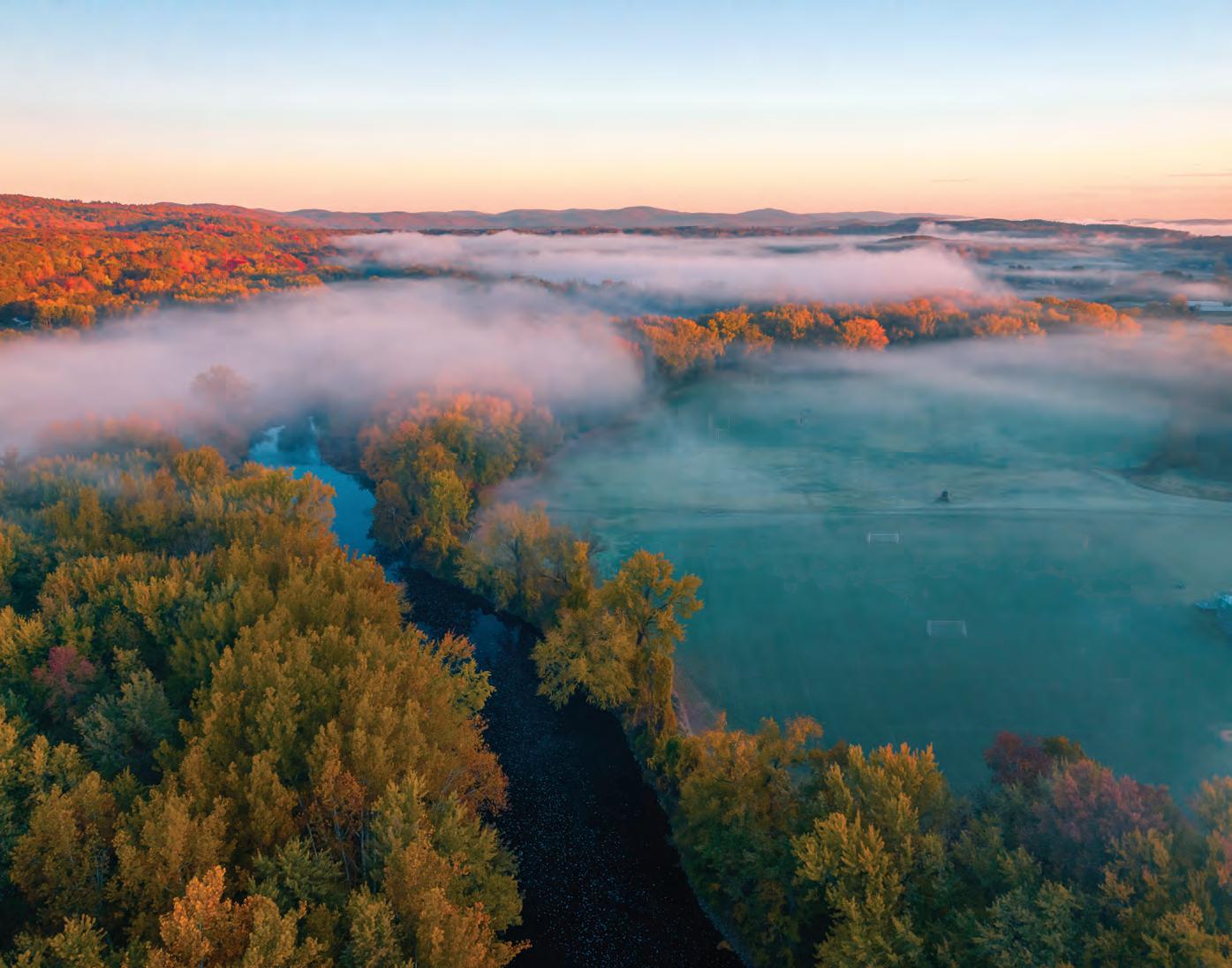DEERFIELD



As the kids say, it’s been a minute. So much has changed in the world since we last published Deerfield Magazine—right around this time in 2019—and none of us in the Communications Office ever imagined that three years would pass before we sent out another issue. The passage of time itself became a funny thing during the pandemic; often there were not enough hours in the day to accomplish everything that needed doing, even as the weeks and months dragged on—typical routines abandoned and uncertainty everywhere. We relied upon the speed and capability of digital communications—leaning into their quick and far-reaching capabilities—even as we anchored ourselves in the solid, time-tested fundamental purpose and mission of the Academy, its goodness, and in the determination of the people who care so deeply about our school. But, as a firm believer in the value of a printed publication, I am thrilled to welcome you back to Deerfield Magazine!
In the following pages, you’re invited to revisit—one last time—how Deerfield Academy managed to not only survive a pandemic but to adapt and to continue to grow. In addition to telling Deerfield’s “pandemic story,” which begins on page 48, Head of School Dr. John Austin’s remarks from this fall’s Family Weekend begin on page 2, and they highlight the importance of innovation beyond short-lived fads, and the intrinsic value of a liberal arts education. In the “From Albany Road” section, we recognize and celebrate some milestones and outstanding moments from the past school year, while providing the means to view similar moments from this fall, thanks to the “QR codes” we’ve incorporated. And beginning on page 42, Dean of College Advising Mark Spencer offers an overview of the dramatically changed landscape of college admissions since 2020. Finally, please don’t worry: Class Notes will be published again beginning with our Winter issue in 2023. In the meantime, they are available online at Deerfield. edu/alumni, and we have included three “teaser” alumni spotlights; there are many more waiting in the wings! If you know of someone in the alumni community (or beyond) who should be highlighted in a future issue, please let us know. I am excited to extend and share conversations about current Deerfield students, our program, our alumni, and our broader community, as we resume our thrice-yearly publication schedule.
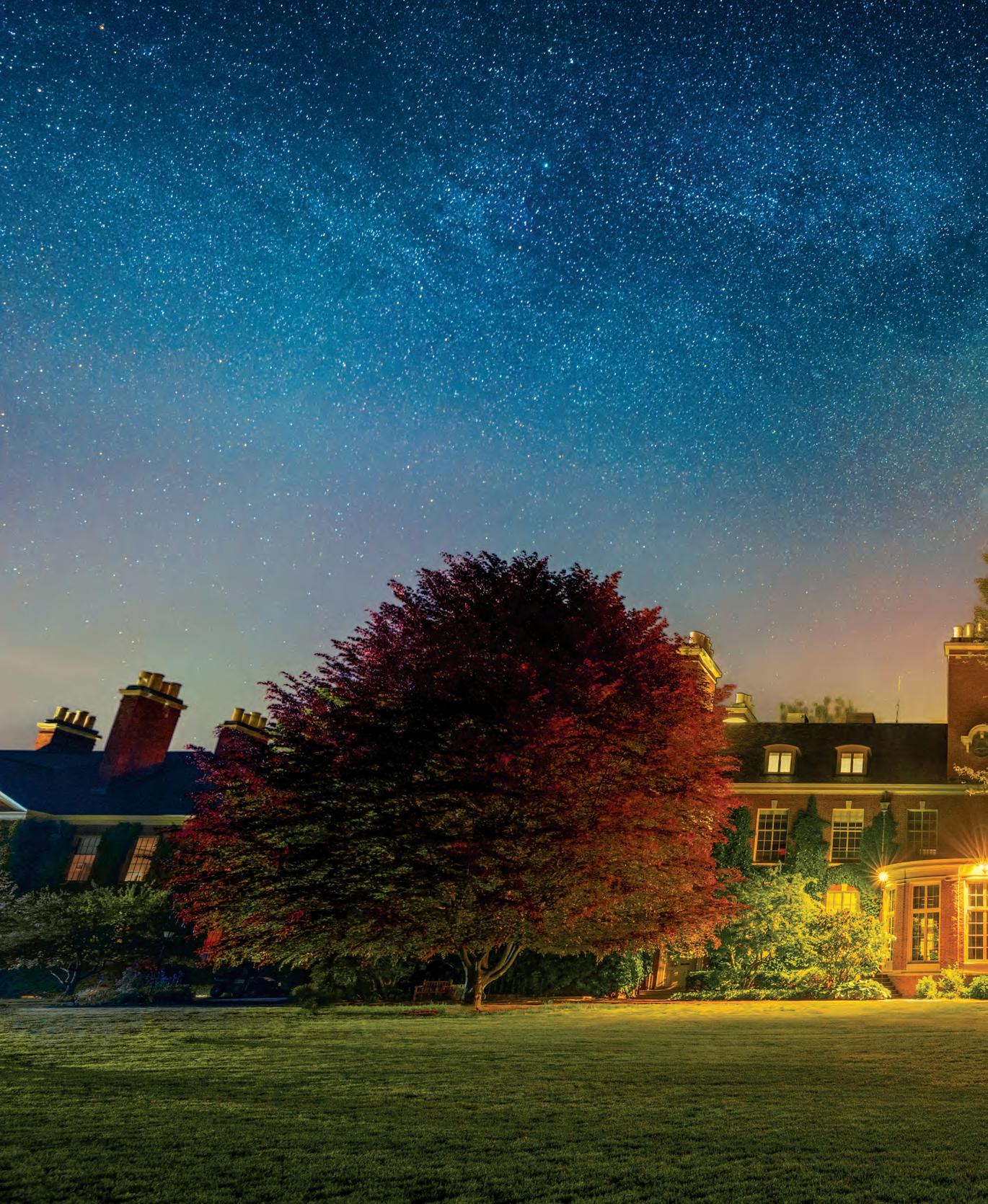 Director of Communications/ Editor-in-Chief
Jessica Day
Assistant Director of Communications/ Managing Editor Carly Nartowicz
Production Manager Steve Berman
Design & Art Director Brent M. Hale
Social Media & Email Manager Meghan Hoagland
Academy Archivist Anne Lozier
Director of Communications/ Editor-in-Chief
Jessica Day
Assistant Director of Communications/ Managing Editor Carly Nartowicz
Production Manager Steve Berman
Design & Art Director Brent M. Hale
Social Media & Email Manager Meghan Hoagland
Academy Archivist Anne Lozier
On the cover of this issue, you may have noticed a new treatment of our masthead— paired with a photo of John Williams House and featuring the iconic Deerfield Door with the Milky Way overhead. The photo was taken this past May—shortly before the Class of 2022 graduated—by local photographer Jamie Malcolm-Brown. (His work is also on the back cover.) A timelapse photo, Jamie began shooting it at 10:00 pm and finished up around 3:30 am the next morning. He used a Sony A74 camera and a 14mm lens set to f / 2.8, ISO 640, at 15-second intervals. He commented, “The biggest obstacle was the building lights. While they provide great light for safely walking at night, they cause glare and strange shadows. Luckily, the security officer on duty worked very hard at turning off as many lights as possible. In the end, we never found one switch and put a black trash bag over one light as it was shining directly on the John Williams House. The only other issue was the fog that rolled in as it got closer to 3:00 am, and I had to keep wiping the condensation off the lens.”
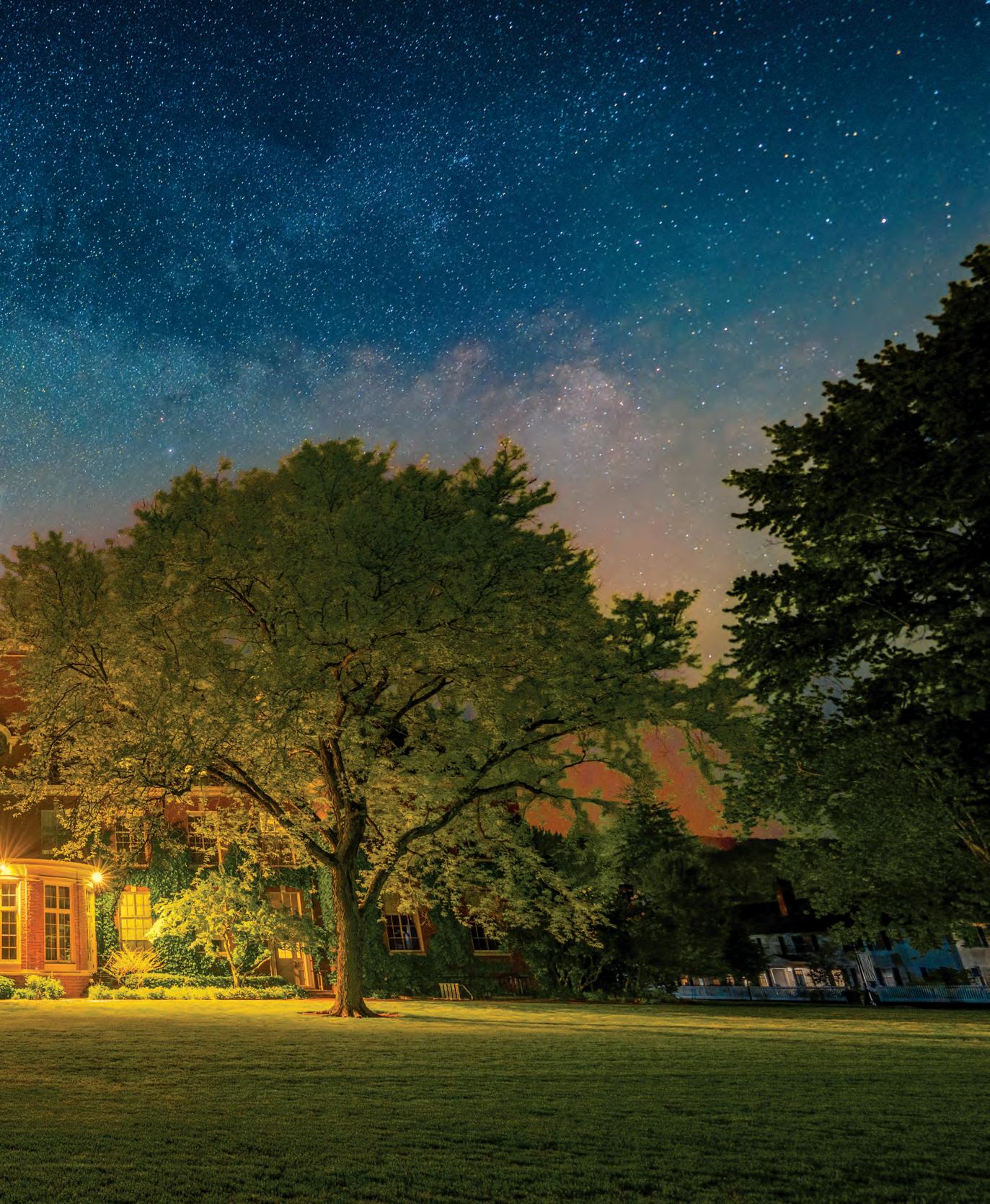
As you may agree, there’s nothing new under the sun—or stars—but there are elements and icons that anchor us as the world changes. Thanks to Jamie, that’s our cover shot: the stalwart Door and the spring sky, just as they were the last time you received Deerfield Magazine. Thank you for your patience and continued support. //
Jessica Day Director of Communications/ Editor-in-ChiefPublication Office: Cummings Printing, Hooksett, NH. Third class postage paid at Deerfield, Massachusetts, and additional mailing office.
Deerfield Magazine is published three times a year.
Deerfield Academy does not discriminate against any individual on the basis of race, color, religion, sex, sexual orientation, transgender status, marital status, national origin, ancestry, genetic information, age, disability, status as a veteran or being a member of the Reserves or National Guard, or any other classification protected under state or federal law. Copyright ©2022 The Trustees of Deerfield Academy (all rights reserved)
Produced by the Deerfield Academy Communications Office: Deerfield Academy, Deerfield, MA 01342. Telephone: 413-774-1860 communications@deerfield.edu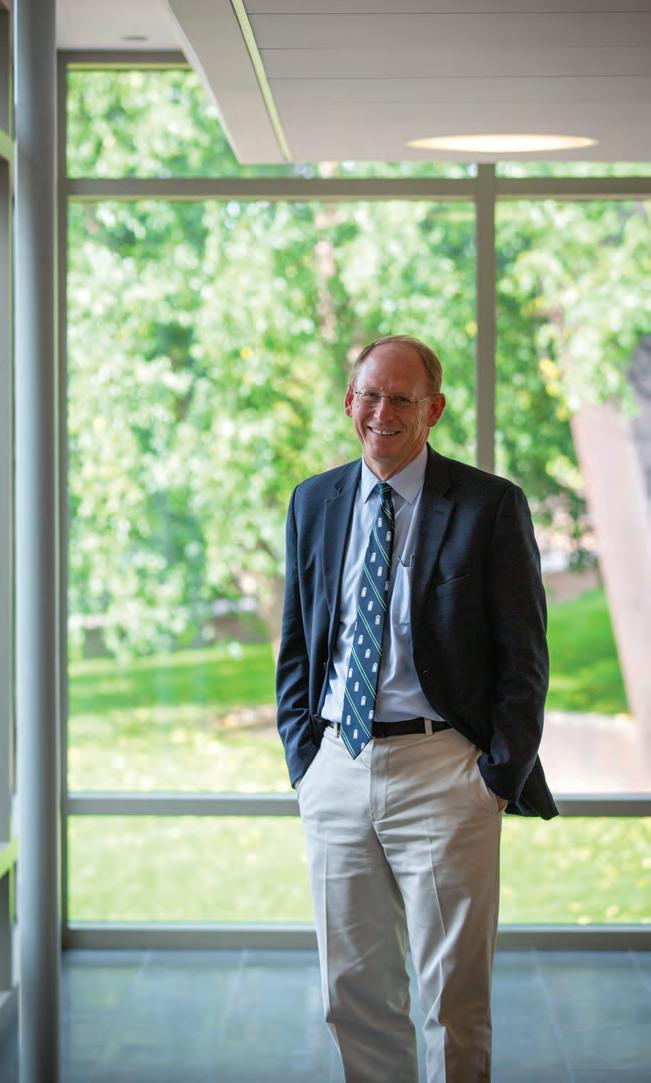
Good afternoon, everyone. I hope you’ve had a great day of classes. I speak on behalf of the entire faculty and staff when I say how glad we are that you were able to join us for Fall Family Weekend. The first thing I want to do is thank you.
Thank you for your continued support, partnership, and trust. Thank you for sharing the lives of your children with us. And thank you, as well, for the questions you submitted. We received a grand total of: eight. Not a lot, admittedly, which is perhaps a good thing.
We plan on getting back to each and every one of you who asked a question. As I have often said, your questions make us better and help us to become more intentional, so I am grateful to those of you who took the time to write.
Your feedback also helps us to do something which is very, very im portant for schools: and that is, to sharpen and deepen our existing strengths—even as we look to the future—and that is my theme for this afternoon, the relationship between what we might think of as “legacy strengths” and future aspirations.
A few years ago, I read a short op-ed by the Canadian journalist David Sax. The title brilliantly captures his argument: “End the Innovation Obsession: some of our best ideas are in the rearview mirror.”
“True innovation,” he writes, “isn’t just some magic carnival of invention . . . It is a continuing process of gradual improvement and assessment that every institution and business experiences in some way.”
“Often,” he goes on to say, “that actually means adopting ideas and tools that already exist but make sense in a new context, or even return ing to methods that worked in the past.” This idea of what he calls “rearview innovation” resonated with me, especially as we emerge from the disruptions of the past few years, take stock, and chart a path into the future.
Don’t get me wrong. Schools—great schools, like Deerfield—are never complacent; they evolve and they change; they are attentive to future opportunities; they are alive to new ideas; and they strive, always, for continual improvement, and we made a number of great adjustments over the last few years. But I was struck by Sax’s distinction between fads and trends, on the one hand, and authentic innovation, on the other; innovation that in his words “reflects where we’ve been, what we’ve learned, and how we actually want to live.”
I was also struck by his comment that “this type of reflective innova tion requires courage, because it calls into question the assumption that newer is necessarily better.” Schools sometimes seem particularly vulnerable to this mistake. Too often what looks like innovation turns out to be a short-lived fad.
I want to mention four “innovations” from the past, tested by time and made all the more relevant by the lessons learned during the past few years, that I hope will endure in Deerfield. Along the way, I hope to answer a couple of the questions that I received from you, and finally, give you a sense of the opening weeks of school.
The first is perhaps the oldest—it’s ancient, in fact. It is the idea of the liberal arts.
At Deerfield we have taken steps to rededicate ourselves to the idea of the liberal arts. As I said at this time last year when I spoke to you, our challenge is to reinvent them to meet the challenges of the historical moment in which we are living.
The liberal arts—a well-rounded education in the major disciplines of arts, science, and social science that exposes students to diverse modes of thought and tradition that resists early over-specialization—have proved to be remarkably durable, but they have never been static; they have continually evolved over two and a half millennia—rediscovered, reinvented, renewed by new scholarship and discovery and, as importantly, rescued from neglect.
Over recent decades, and under pressure from a range of forces, the number of students pursuing a liberal arts education has declined precipitously (interesting enough, even as they are being embraced across the globe).
The liberal arts are truly a global accom plishment, and they have been enriched by many different cultural traditions. Yet despite differences across history and geography, certain core commitments of the liberal arts have endured and stood the test of time.
Here are a few ideas at the core of the liberal arts that shape our work here and will continue to shape it into the future. I am confident you saw them in action today across our classrooms.
Since the invention of the classical trivium— grammar, logic, and rhetoric—the liberal arts have embraced as central an emphasis on com munication—on speech and writing and particularly the discursive arts: discussion, dialogue, disputation, argument, and debate.
It’s not accidental that the Greeks pioneered both democracy and the philosophical dialogue; those go hand-in-hand. There is a deep connec tion between citizenship and the attendant skills of listening, discussing, and debating— all essential preparation for a life of pluralistic contention and civic engagement.
Related to this, is a commitment not simply to literacy but to deep forms of reading: reading deeply, with absorption, appreciation, pleasure, and concentration; reading generously and with an open mind; and, of course, reading critically, analytically, and skeptically.
Today that skepticism includes the ability to navigate a media environment characterized by an over-abundance of information and data—much of it unreliable, questionable, doubtful. As technological change accelerates, deep reading skills, already in precipitous de cline, will become more and more important.
Last year at this time, I suggested that the liberal arts are, at their core, an education in different ways of knowing the world. That begins with an introduction to—and induction into—the core disciplines that shape scientific and humanistic investigation.
We divide the curriculum up into discrete disciplines for a reason: because they each of fer a unique set of tools for making sense of our worlds. There will always be debates about which disciplines matter and which ones schools should emphasize, and that is as it should be; the ferment and interest in STEM-related fields is one of the most import ant developments of the last few decades. Stanford University, I’m told, has recently in troduced a major in data science—a study our math department is also considering adding to the curriculum.
But what’s not up for debate—at least if you believe in the liberal arts as an enduring cur ricular structure—is the central importance of introducing high school students to a range of different ways of knowing and understanding.
With this emphasis on multiple disciplinary lenses comes a similar commitment to unfet tered curiosity, inquiry, question-asking, and a robust skepticism of received truths and orthodoxies, and, with that a deep skepticism of practices that obstruct and slow that quest.
A commitment to courageous question-asking and expressive freedom runs like a vein of iron thread through diverse learning traditions. Frederick Douglass, in an essay I assigned to my seniors earlier in the year, calls speech and dialogue “the great renovator of moral society”; they are also the great renovator of the human mind, and schools need to champion that idea of expressive freedom and inquiry. I will have more to say about this—and the role that Deerfield can play in promoting those values— later in the year.
THE
You also find in the liberal arts a deep commit ment to the past as a source of wisdom and knowledge—through works of art, literature, philosophy, and ethics, and the competing values and perspectives they offer. In 1969, the media scholar and educator Neil Postman wrote a book with the wonderful title: Teaching as a Subversive Activity. After all, it was 1969. Ten years later, in 1979, he wrote another book with the title: Teaching as a Conserving Activity. What he meant by this is that much of what we do as educators and teachers is to transmit, rescue, and reclaim traditions of learning and art that would otherwise slowly decay and disappear without the active stewardship of teachers and schools.
These ideas remain vital elements of our educational philosophy and practice—they inform how we think about our curriculum, how we think about our teaching, and how we will think about the future of our faculty. Given trends in higher education, secondary schools such as Deerfield have a unique and leading role in cultivating the mindsets and habits that have long defined the liberal arts.
This has been one of the best opening of schools I can remember—the tone, the positive energy have been palpable—which brings me to my second rearview innovation. It’s the most difficult to put a finger on. Let’s just call it school spirit.
We have lots of that. We see it at every week’s School Meeting. We see it at theatrical and musical performances when students show up in droves to support their friends—as you will see tonight. We saw it a couple weekends of ago when all of our teams were playing St. Paul’s, and we will see it a couple of weeks from now when we all go to Choate and cele brate, with one of our historic rivals, 100 years of interscholastic competition. It’s easy to dis miss or to trivialize school spirit, but it’s much more than cheerleaders and bonfires and natty letter sweaters, though all of those are important.
At its best, school spirit is students celebrating one another; students cheering for one another; students inspiring one another. Taking pride in one another, challenging and pulling for one another. Lifting one another up in search of their best performance and their best self. It also offers young people a common identity, a sense of shared purpose. The social psychologist Jonathan Haidt, who is an insightful student of schools and their cultures, often invokes the
great civil rights leader Pauli Murray, who spoke of expanding circles of connection, inclusion, and care. These centripetal energies, pulling students together into community and promoting shared experiences, are powerful and formative.
And for many students experiencing that sense of shared purpose and excitement is their first lesson in meaningful citizenship—of what it means to have responsibilities and duties to other members of the community. So school spirit is really the idea that each of us is a member of this specific community, and that students have unique obligations to one another: to support and care for one another.
This summer, in announcing the adjustment to our new approach to smart phones, I men tioned Mr. Boyden’s insistence that there be no signs on campus as a way of encouraging students to actively help greet and guide lost guests. And that stands as a symbol of “innovation” number three: our commitment to a heads-up, friendly, welcoming culture with face-to-face interaction.
Not surprisingly, a few of your questions addressed the adjustment we made to our smart phone policy. Is it working? What has been its impact on students? Has the adjust ment met our hopes and expectations? Does it apply to parents?
My sense from talking with students and closely observing their interactions is that it has been an overwhelming success. I can say without qualification that students have em braced the policy, and our worry that faculty might have to work overtime to enforce it has not come to pass.
Thus far this year, I’ve only had to remind one student of our expectations. (I think he was truly mortified!) Students appear to be using their phones less and connecting more. And some have told me it has reduced time on social media. If you walk around during community time—into the Dining Hall, the Hess lobby, the library, the café in the Koch— you see students studying, reading, and inter acting with one another. And I like to think that this hiatus from cell phones during the academic day has helped our students redis cover what everyday life can be like when un tethered from their phones.
At the height of the pandemic, I came across an article in the Washington Post about what has been called the “humane technology”
movement among former Silicon Valley insiders. The article profiled a small Amish community in Michigan wrestling with new kinds of tech nology. The idea that the Amish reflexively shun modern technology, it turns out appears to be greatly exaggerated. The article mentions an Amish-owned factory in Ohio featuring so phisticated design software, laser technology, and advanced robotics. They have some latitude in whether or not they adopt new technologies, and they are quite intentional about these deci sions. When a church member asks permission to use a new technology, the Amish ask a simple question: Will the adoption of the device strengthen or weaken relationships within the community?
In one case, they voted down the purchase of a hay baler. Yes, it might increase productivity, but they concluded that their connections among one another would be adversely affected if they began haying without the help of others.
I can honestly say I have no view on hay balers, so expect no policy change on those anytime soon. But I do love the question. I love the fact that they’re carefully considering the impact of certain practices on their community life, because I believe that schools have a unique opportunity to create conditions where young people can thrive and flourish.
Number four is closely connected to two and three—and it’s probably not surprising to any one in this room. It also happens to be one of my favorite times of the day: sit-down meals.
A parent recently sent me an article with the title: “Family dinners are key to children’s health. So why don’t we eat together more?” It cites research demonstrating a strong correlation between dinners spent with friends and family and the well-being of young people. The article also noted how difficult it is for many families to do this: working families, busy professional families, single parent families. The author describes one young woman, a student at a day school with a long commute, and her mother, who eat dinner together in the car so she can participate in her robotics club. And I should say that the effort that we make—that faculty and dining staff make—to pull this off seven times a week (even as other schools have all but abandoned this practice) is considerable, but it goes directly to who we are as a school, and it has a powerful impact on our students and their experience here. Our Dining Hall at sit-down is really a kind of classroom, where
important lessons are imparted.
What do you see at sit-down meals? You see a certain degree of formality. A simple grace of thanksgiving. You see students serving one another and cleaning up after one another. You see students working with—and beside— staff: setting tables, refilling the water, retrieving seconds, filling in for absent waiters and second waiters, friends helping friends. And that, really, is the point: You can’t have a sit-down meal unless everyone is contributing.
You also see all manner of goofy announce ments: Classics Club announcements in Latin, organizational meetings for the Drone Club and the Meat Club. You see students singing happy birthday to one another, and on Sunday, the entire school singing the Evensong.
At our opening meeting, I said to faculty that our goal as teachers and advisors and coaches is not simply student well-being. Our goal—our aspiration—is human flourishing: to create a school that celebrates and pro motes connection, inclusion, community— what sociologists and political scientists call “thick” or layered relationships. The kind of learning that we value at Deerfield is impossible without first creating the conditions where these kinds of relationships can seed and root, and they are one of the most important things we can do to ensure that young people will thrive.
I recently tried to sketch out for myself the qualities I most admire in our faculty: they are great collaborators and supportive, flexible, selfless colleagues. They are dedicated mentors committed to working closely with young people across multiple dimensions of school life. They bring joy, generosity, and a sense of humor to all of their interactions.
You might have noticed some things missing from that list. I should say that I take it as an absolute given that a teacher should have dis ciplinary expertise, wide-ranging knowledge, a passion for learning, and skill in communi cating that passion to young people; they have to be great facilitators, coaches of learning.
But I was not surprised that I found myself focusing on the very intangible qualities of character that help us create thick relationships. One of the best pieces of advice I was given when I became head of school was this: surround your yourself with energy producers, not energy consumers. A great community actively creates that kind of joyful, positive energy, and that, in turn, provides a founda
tion from which we can challenge our students, stretch our students, and ask more of them. I believe that Deerfield has a unique opportunity, and can do that in a way that colleges and day schools simply can’t. And by doing it we give our students—your children—an extraordinary gift: providing them with the kind of environ ment they need to thrive, meet challenges, and reach for excellence.
You, too, are a part of this—everything we do here is a team effort. So I do have a simple request: (I hope!)—and I know many of you are already doing this—but I hope you will take a moment to share a quick word of thanks to a member of our staff or faculty when you have the opportunity, especially now that you have, after a gap of three years, the chance to visit classes. It would mean a lot to them, I know.
One of our greatest hopes is that our gradu ates will leave here with the bridge-building and community-building skills of creating and caring that will enrich their lives and make the world and their communities—wherever they are—a better place. What they learn here will travel with them throughout their lives.
I ran into a prospective parent the other day in the Main School Building, a graduate of one of our peer schools. He was first introduced to Deerfield his sophomore year of college during a two-week stay in the hospital. Every day a classmate—a graduate of Deerfield—and someone he barely knew, regularly and with out prompting but out of generosity, brought him his Greek homework, sharing notes, and ensuring that he did not fall behind. One little act. But remembered for a lifetime. I like to think that the culture we create here will engender a lifetime of thoughtfulness and care.
Each of these innovations from the past that I have described will find further expression at Deerfield in the months and years ahead.
We continue to think a great deal about Deerfield’s future: how we can deepen our commitment to the liberal arts, ensuring that our academic program is attentive to future possibilities; how we can secure the resources to support great teaching and ensure that our faculty remains a learning faculty—always striving for improvement to remain the very best in the country—both as mentors and

teachers; how we can continue to build a community of connection, joy, optimism, and challenge. And how these aspirations find expression in our physical campus.
At the center of our Master Plan is the refur bishment and reinvention of the Dining Hall— the heart and soul of our community and a campus landmark. Built 75 years ago, it is in need of expansion and modernization. It’s a bold, exciting, and necessary project that will create new common spaces for students, a new servery, and a necessary expansion of our seating capacity so we can comfortably seat our entire community while also maintaining the existing footprint—preserving the classical feel of a building that has connected generations of Deerfield students while keeping school size at approximately 650 students—a number we believe allows us to provide a broad and expansive program and also a powerful sense of community.
I am thrilled about what this project will mean for us, and I can’t wait to share with you our most current ideas and plans as soon as possible. //
Commencement for the Class of 2022 was celebrated on Sunday, May 29. The day brought clear blue skies, smiling faces, inspirational speakers, and proud families back to campus. This year’s student-elected speakers, Camryn Howe ’22 and Dominic Sessa ’22, spoke eloquently and fondly of their time at the Academy, and The Honorable Victor Wright ’84 P ’20 shared his incredible Deerfield story. You can find the full recording of the event at Deerfield.edu/parents/events/commencement-2022. //
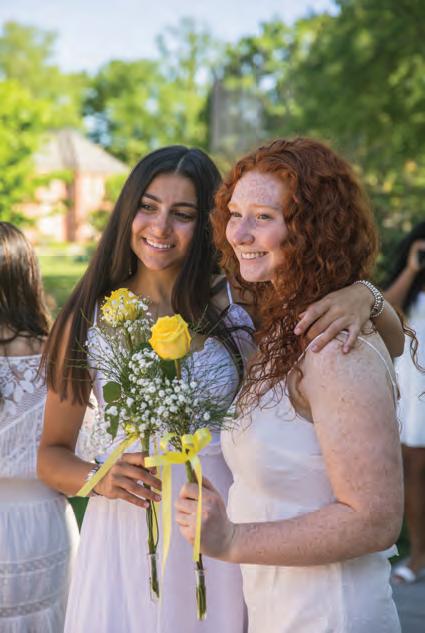
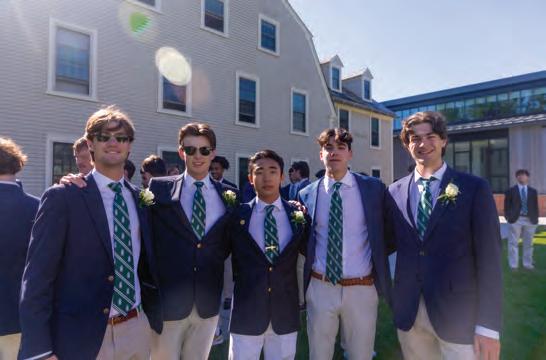
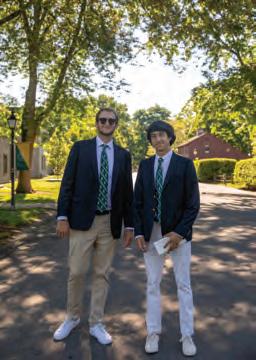
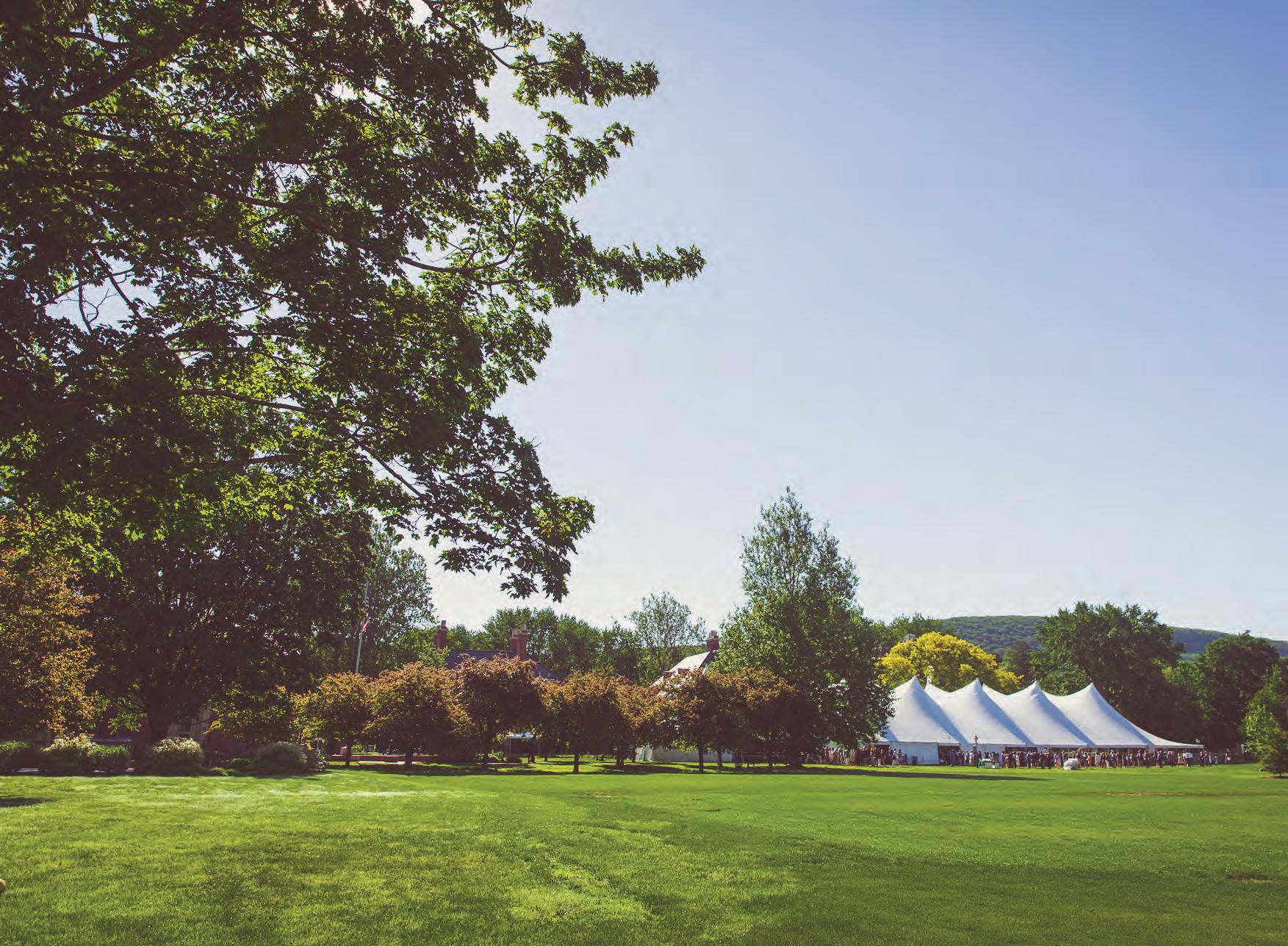

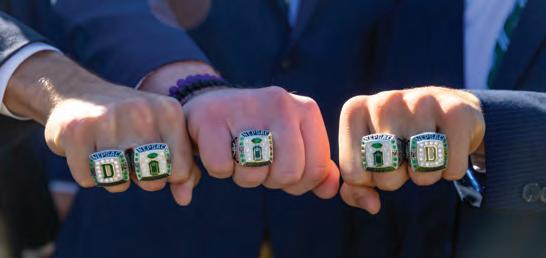
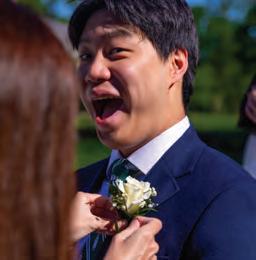
1.
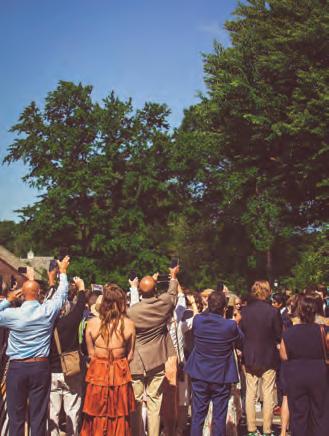
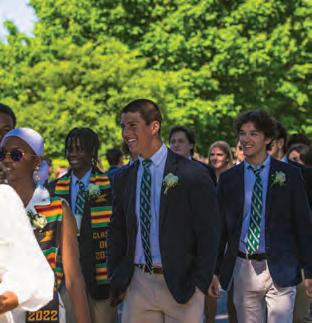
2.


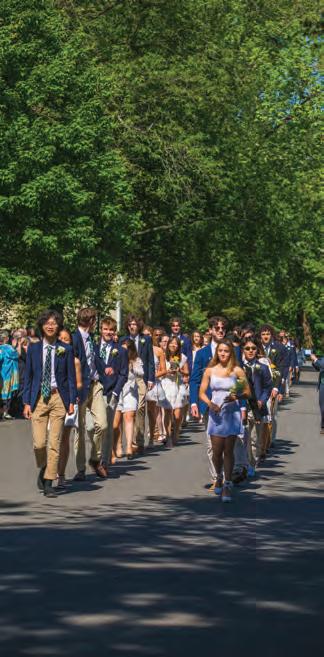
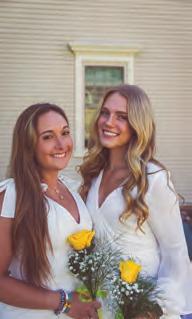
3.
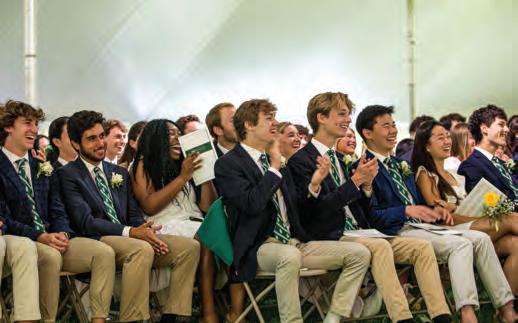
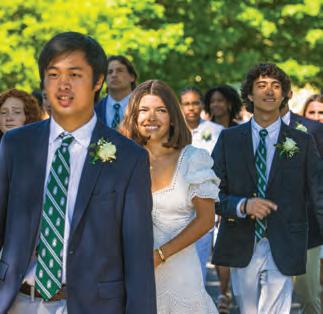
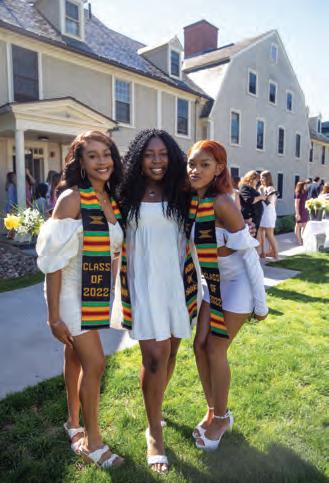
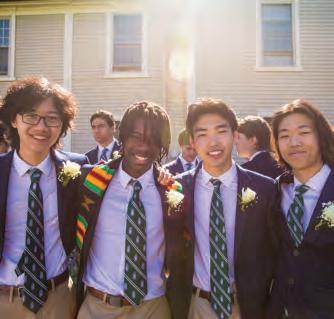

Kristin Drouin ’08 was presented the Ashley Award at School Meeting on April 27. This award is given to an individual who demonstrates Tom Ashley’s exemplary character and tireless devotion to a people, cause, or place through unwavering volunteer service or philanthropic activity.
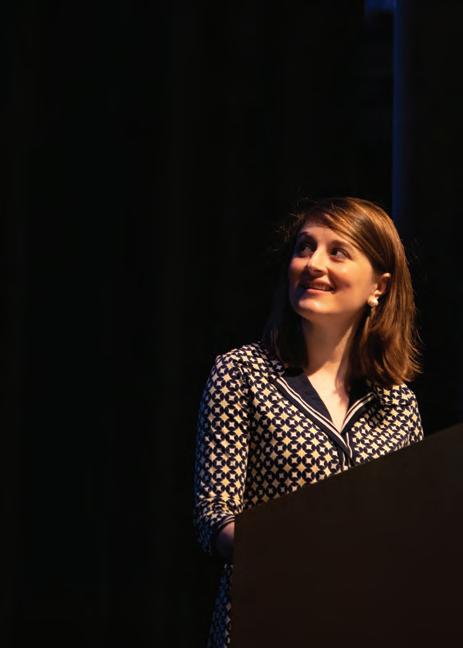
Over the past twelve years, Kristin has supported hundreds of adult and pediatric patients with chronic or life-limiting illnesses and their families. In her current role at Boston Children’s Hospital, Kristin works with patients undergoing bone marrow transplant and their families. She also is passionate about suicide prevention and currently serves on the Board of Directors of TheLuvUProject, a national organization addressing mental health in the workplace. //
Acclaimed filmmaker Ken Burns joined the Deerfield community at School Meeting on April 13. He spoke about his career, his signature style, and went on to share clips from his latest documentary, Benjamin Franklin. The conversation was moderated by Brian Hamilton, Chair of the Academy’s History and Social Science Department, and Anne Duong ’22, winner of Deerfield’s 2021 Bates Prize in History. //
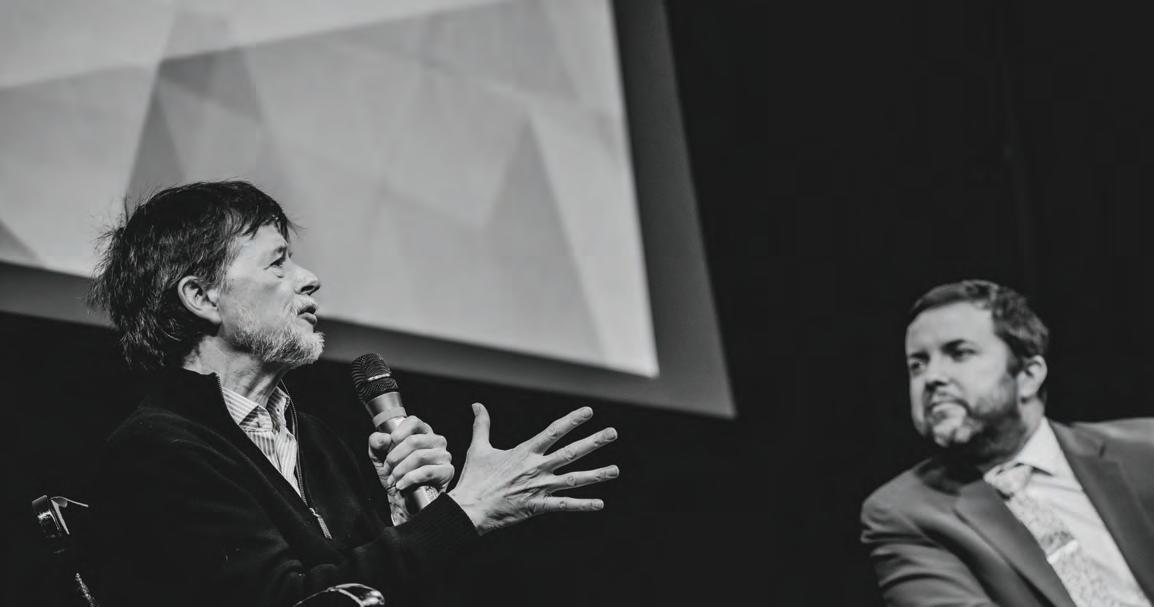
Been There, Done That Ken Burns and Ben Franklin
Each year, the Agry Cup is traditionally presented to the Reunion class with the highest attendance (the award does exclude the 5th and 50th Reunion classes, because with their typically robust attendance numbers, one or the other would probably win every year). The cup was last awarded to the Class of 1979 in 2019, when they set a new 40th Reunion attendance record of 124. Since then, the cup has been on a journey of epic proportions, as it was passed from classmate to classmate across the US and around the globe! In the three years since ’79’s Reunion, the cup has traveled 86,871 miles, visited eight countries, 26 states, and 58 cities and towns.
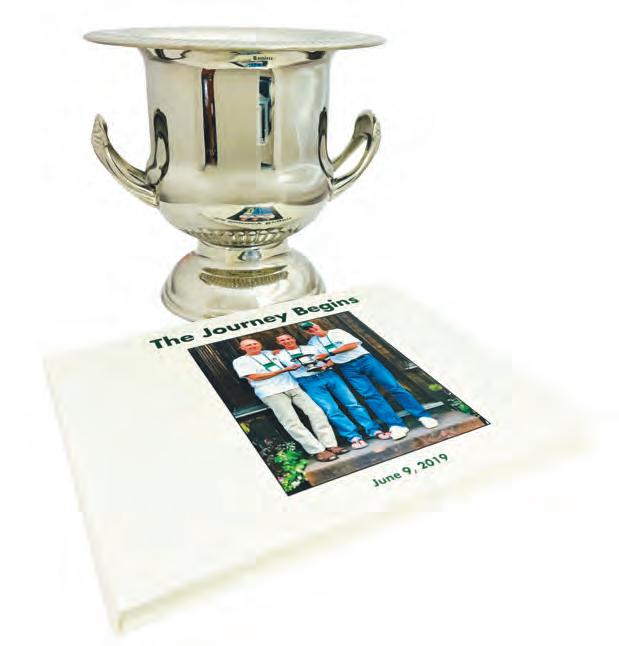
This month Brad Palmer ’79, Art Dwight ’79, Marc Dancer ’79, and John Dinneen ’79 (pictured left) returned the cup to Ephriam Williams House. They also brought a book full of photos documenting the cup’s many adventures. Congratulations to Reunion Chairs Dwight, Dinneen, and Marcus Dowd ’79 on being able to celebrate with so many classmates in 2019 and beyond! //
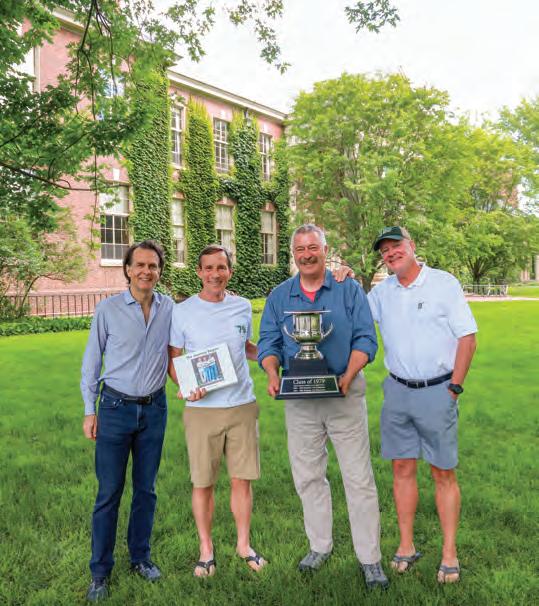
The Heritage Award was established in 1984 by the Executive Committee of the Alumni Association to recognize a Deerfield alumnus or alumna whose professional and personal achievements represent a special contribution to the betterment of society; someone whose life exemplifies the Academy’s motto: “Be Worthy of Your Heritage.”
Congratulations to Colonel Larmon, the first alumna to ever receive the Academy’s Heritage Award. Colonel Larmon, through example and action, has repeatedly demonstrated her dedication to public service. Her Heritage Award citation reads as follows:
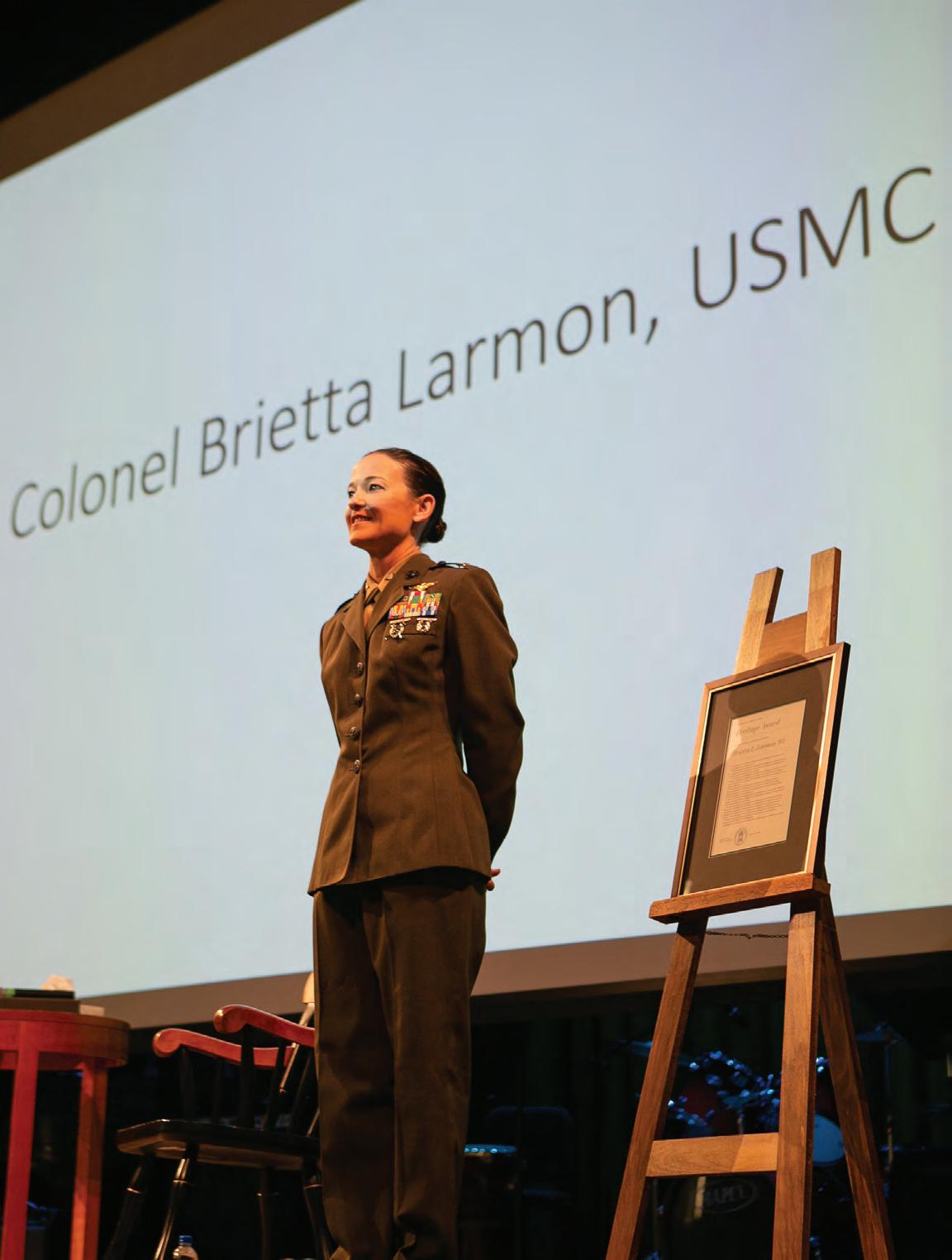
 In Recognition of Outstanding Achievement & Service
In Recognition of Outstanding Achievement & Service
At Deerfield, you were described as “diligent, focused, and thoughtful,” and known for your “perseverance, vitality, and good cheer.”
Whether playing varsity ice hockey or participating in the Big Brothers Big Sisters program, you sought ways to encourage others. As one teacher said, you showed “leadership qualities” and offered “constant support to your teammates.”
In the years since your Deerfield Days, you have embodied the Academy’s ideals of commitment and service. Following Bowdoin College, where you earned your bachelor’s degree in English, you joined the U.S. Navy. You completed officer candidate school, were commissioned as an ensign, and began flight school.
After nearly two years in the Navy, you pursued new opportunities and adventures. You requested and received an inter-service transfer to the U.S. Marine Corps, where you distinguished yourself as a leader and a skilled pilot of various aircraft, including the Sikorsky CH-53E Super Stallion, a heavy-lift helicopter.
You have risen to the rank of colonel, logged over 3,500 flight hours, and deployed to Afghanistan and Iraq, among other countries. While serving as the commanding officer of a helicopter squadron, you provided humanitarian relief in Haiti.
Throughout your career, you have eagerly shared your experience and enthusiasm with others. You once said, “You might have to train longer and work harder than the person next to you, but that shouldn’t stop you from breaking down barriers. At the end of the day, I don’t want anyone to question whether or not I can carry my load, and that is what I want to instill in these young Marines . . . this has been a journey for me, and now I want to help others get their adventure started.”
In a life distinguished by integrity, dedication, strength, and service, you exemplify the Academy’s motto, BE WORTHY OF YOUR HERITAGE.
Deerfield is proud to count you among its alumni and honored to present you with the Heritage Award.
When longtime Academy fine arts teacher David Dickinson retired in the spring of 2019, he knew he had one last assignment to complete for Deerfield: painting the portrait of Head of School Margarita O’Byrne Curtis on the occasion of her retirement that same year.
The completed portrait was unveiled last October at a special gathering for trustees, faculty, and friends of the Academy, and has been hung in the Caswell Library along with the portraits of other past heads of school. //

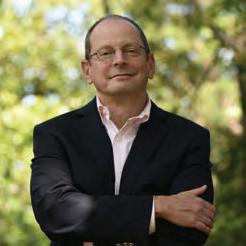

As part of ongoing and collective work as an educational institution dedicated to student thriving and a commitment to free and open inquiry and expressive freedom, Head of School John Austin and the Academic Affairs Office were pleased to present the inaugural Deerfield Forum: Facts, Falsehoods, and the Future. The 2022 Forum was held on Tuesday, April 19; panelists included Dr. Ronald Crutcher, President Emeritus of the University of Richmond; Jiayang Fan ’02, staff writer at The New Yorker and author; and author Jonathan Rauch, along with moderator Libby Leist ’97, Academy trustee and Senior Vice President for TODAY and NBC News. // SCAN TO WATCH THE FORUM
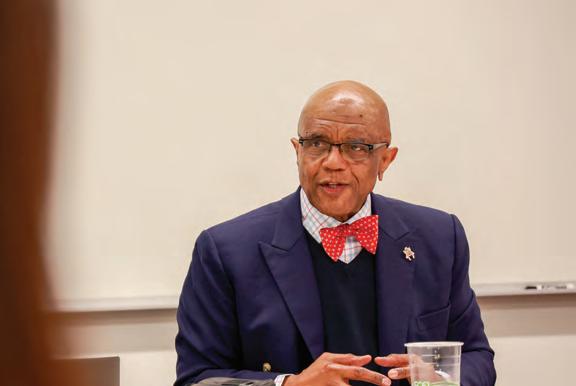
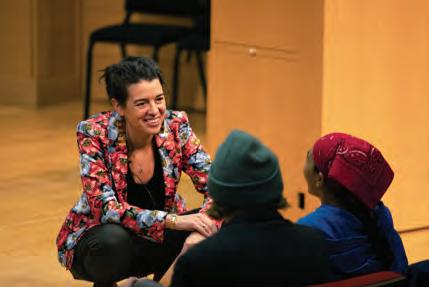

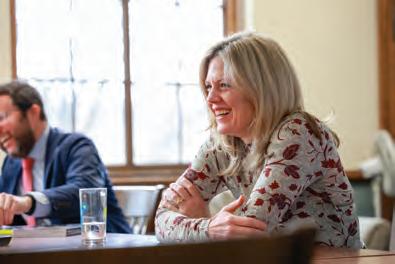
The Deerfield community welcomed Pulitzer Prize-winning playwright and essayist Quiara Alegría Hudes to campus this past spring. In preparation for her visit, Deerfield students read Ms. Hudes’ book,Water By the Spoonful, in their English classes and were able to ask Ms. Hudes questions during classroom visits. //
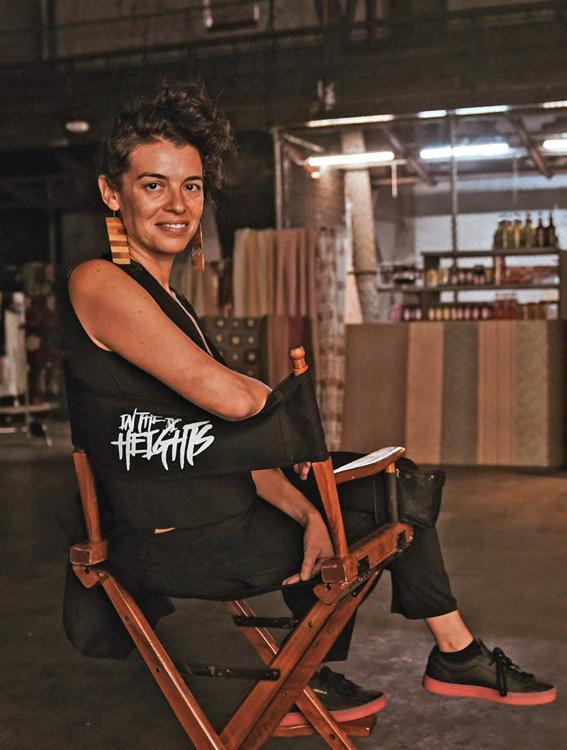
Reunion Weekend is always a happy occasion, but this year it was especially festive, as Deerfield hosted three sets of Reunions over two weekends: June 10–12 and June 17–19, 2022.
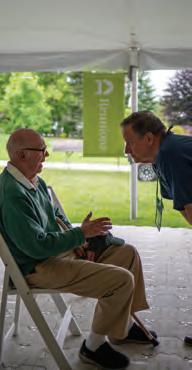
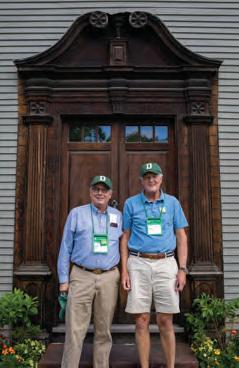
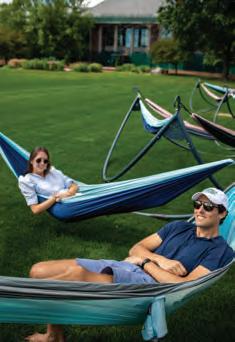
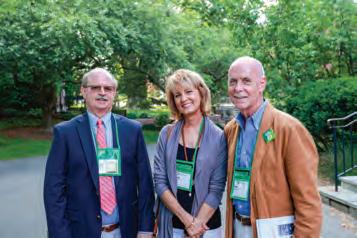

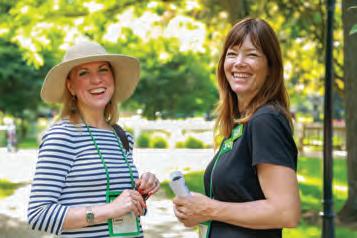
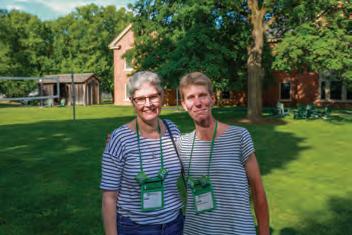
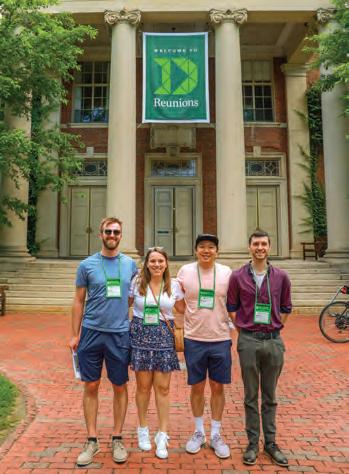
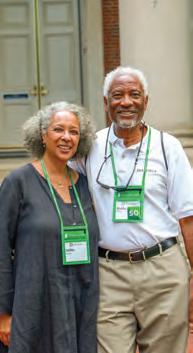
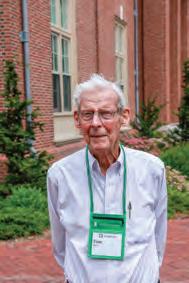
More than 1500 alumni whose class years ended in 0s, 1s, 2s, 5s, 6s, and 7s, their guests, and current and past faculty came back to campus, and it was fabulous!
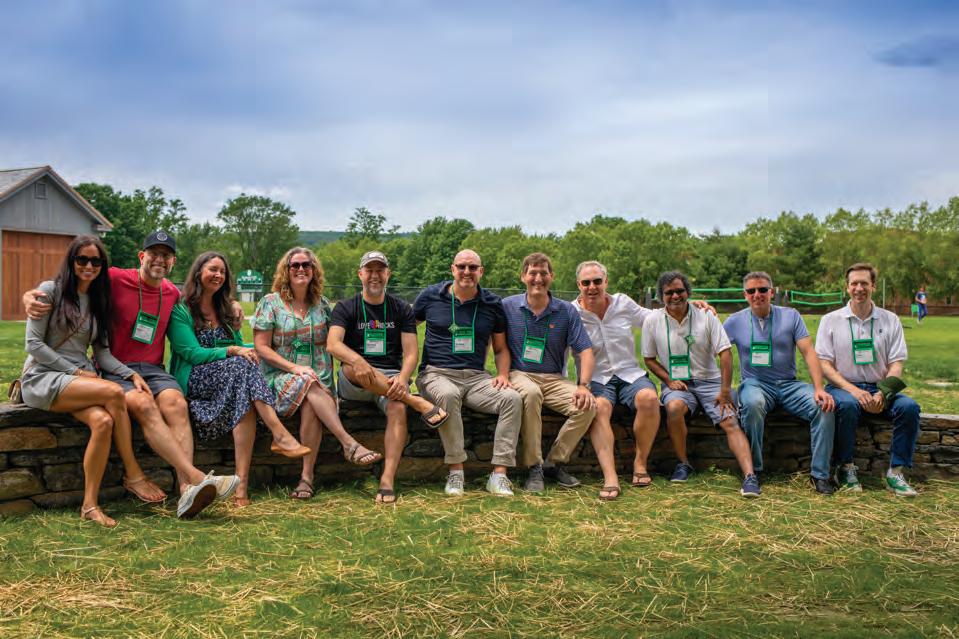
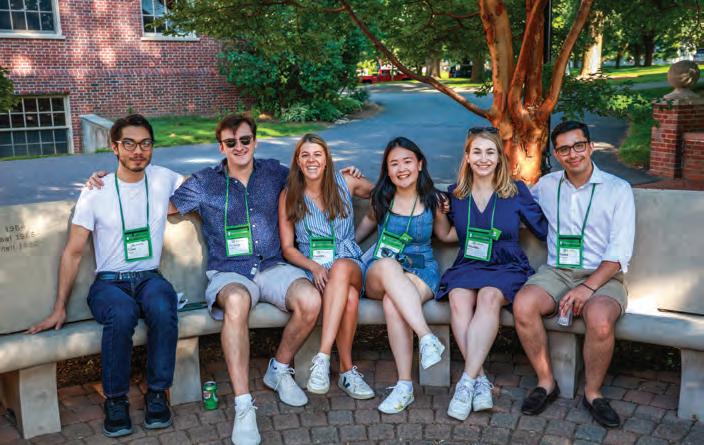
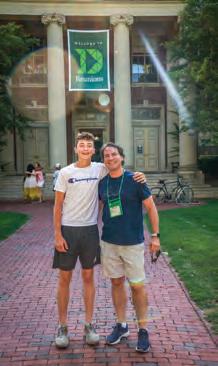

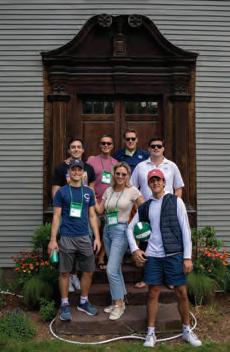
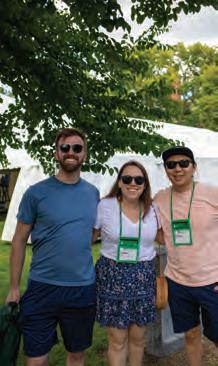

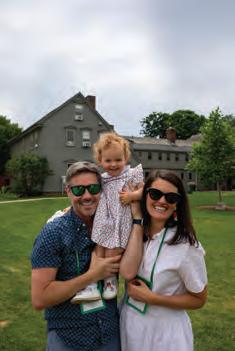
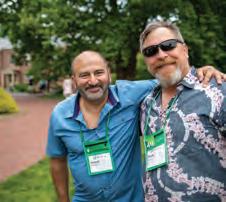


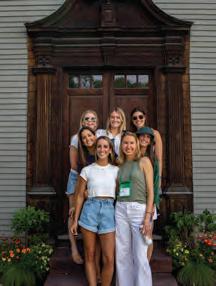
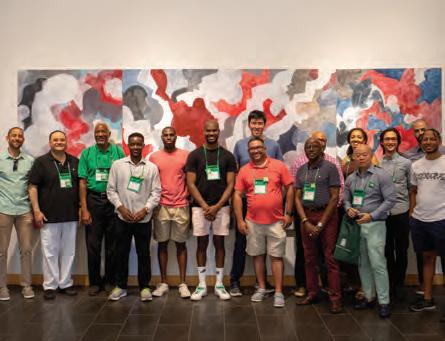
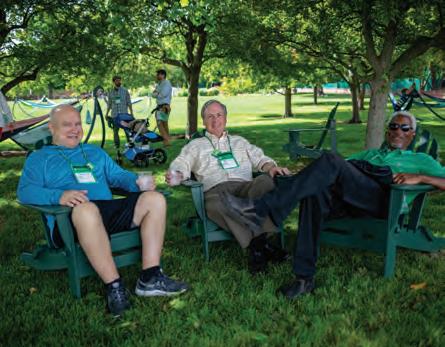



In 2018, then Head of School Margarita Curtis asked Brian Simmons P’12,’14 to become President of Deerfield’s Board of Trustees. Brian was surprised by the offer. With the exception of Ralph DeNunzio P’74,’77,’80 G’11,’12,’14 H’12, every previous president had been an alumnus. But Brian also recognized that his career in private equity, which involved working with management teams and building and serving on boards, would be useful in the most important responsibility facing Deerfield’s next board president: the search for a new Head of School—no small task, given Dr. Curtis’s monumental success. Little did he know how valuable his leadership skills would be to the Academy in the tumultuous years ahead.
Brian had been inspired to join the Board of Trustees in 2011 because of the “unbelievable experience” his children Porter and Reilly had as students at Deerfield. “As a parent, I got to see how powerful, invaluable, and inspiring the core aspect of a Deerfield education can be,” he says.
During his tenure as a trustee, Brian served as Chair of the Finance and Endowment Committees. Recently retired Chief Financial Officer Keith Finan worked closely with Simmons in both roles. “Brian is thoughtful and measured,” he says. “He wants you to succeed and
he works accordingly.” Newly retired Chief Advancement Officer Ann Romberger describes how “Brian built an unrivaled team of the most talented endowment managers in the industry, producing an endowment performance that continues to be the envy of college and university endowment committees.”
Once he accepted the role of president in 2018, Brian immediately began the search for a new Head of School. He was instrumental in asking Dr. John Austin, then Headmaster at King’s Academy in Jordan, to put his name in the hat. “It was clear that John would bring the kind of mindset, experience, and value system that characterizes Deerfield,” says Brian. “In addition, he’s brilliant. John is able to be tactical and in-the-weeds, and then he’s able to think from 100,000 feet. That’s a unique skill. And he’s fun. He can talk about world class literature but also surfing and skateboarding. What’s not to like about that?”
Dr. Curtis had been a highly visible head of school, and Brian believed that Dr. Austin would continue that role. His hunch was proven one afternoon in September 2020, when the two rode bikes to several sports practices. “It was obvious that all these kids knew Dr. Austin,” says Simmons. “He did this not because he wanted to be seen, but because he wanted to see how the kids were doing.”
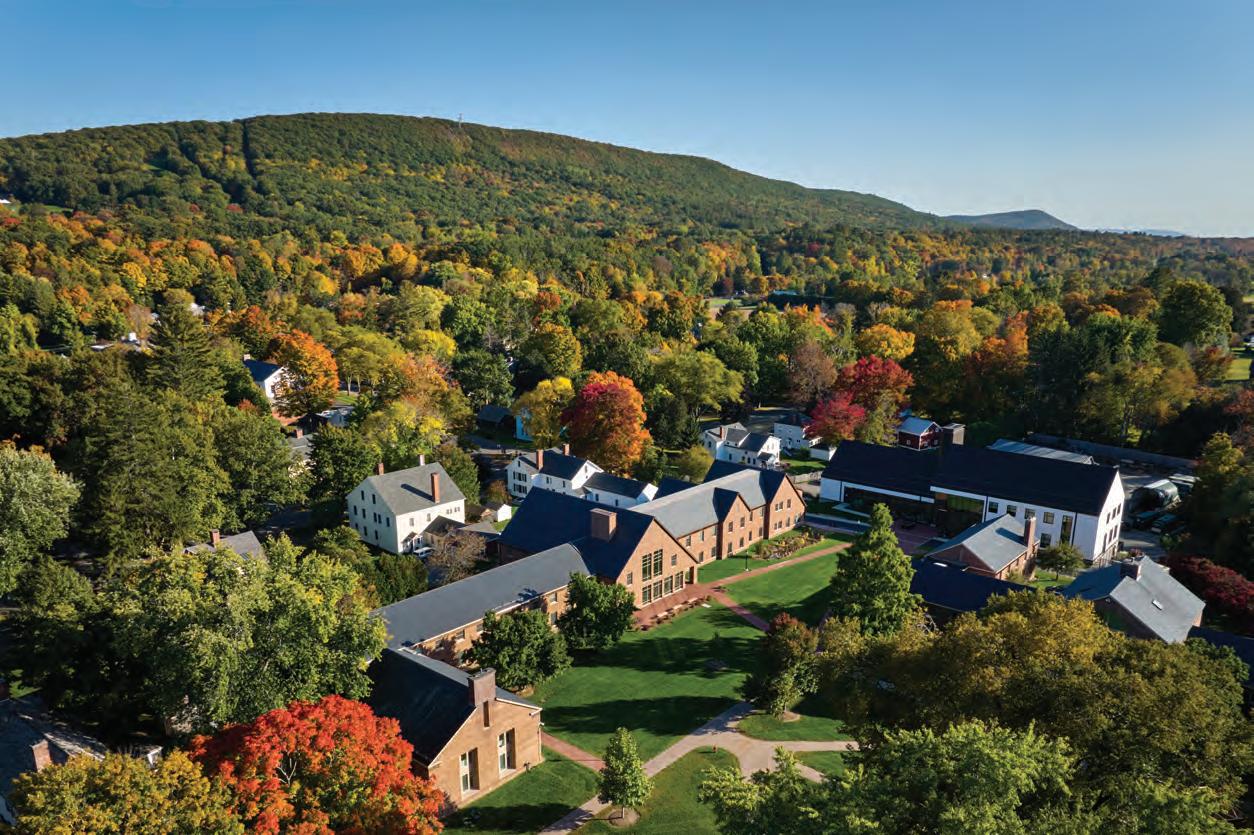
And John Austin knew from their very first phone call that Brian “was an exceptional board chair and that it would be incredible to work with him.” Their leadership was severely tested in the early spring of 2020, when the Covid-19 pandemic disrupted every aspect of life at Deerfield. From the very beginning, the two shared a commitment to reopen the school for in-person learning, and they hit the ground running to make this audacious goal possible. They spoke daily, and Simmons provided Austin with strategic advice and helped marshal Board resources. “The work was hard and consuming,” says Simmons, but together they led Deerfield to be one of the first schools to announce a reopening plan for that fall.
Simmons’s guidance and support during the pandemic was invaluable to Dr. Austin. “I could come to Brian with the really hard questions and know I would make a better decision if I talked it through with him. He has a comprehensive understanding of the school as a former parent, and his financial acumen is through the roof. He’s really a remarkable person.”
Brian also helped to steer the Academy through a time of great political and cultural upheaval. This included supporting Dr. Austin in creating the Action Plan for Inclusion and Community Life, which was developed with Board input in the wake of the murder of George Floyd in May of 2020. “Brian gave me great advice in terms of how to navigate those challenges,” says Dr. Austin. “He’s also very good in terms of Board procedure, making sure that crucial issues are moving through committees in a way that creates buy-in, allows for different perspectives, and gives people the opportunity to have difficult conversations about cultural issues.”
Brian Simmons is quick to deflect praise for his accomplishments and instead lauds his fellow trustees. “There are no individual accomplishments; everything worthwhile
that comes out of the Board is the result of collaborative group effort and shared decisionmaking,” he says. “Deerfield’s Board is an incredible organization with unbelievably capable people.” He also thanks his wife Julie, who was “gracious and understanding,” especially during the pandemic, when Brian often had to postpone family engagements to address urgent Deerfield matters. And he tips his hat to the two “incredibly capable presidents” who served before him, Phil Greer ’53 P’94 G ’13,’16,’22,’23 and Rodge Cohen ’61, both of whom were phenomenal mentors and friends. Any success he had as president, Simmons says, was bolstered by their support and input.
When he talks about his successor, Leila Govi ’93 P’26, Brian can’t hide his enthusiasm. “Leila couldn’t be better suited to be next head of Deerfield’s Board,” he says. “She’s a wonderful person: smart, engaging, and she cares deeply and thoughtfully about Deerfield. I’m thrilled that I was able to play a part in appointing the first woman as president of the Board.”
Early in his tenure, Simmons worked with a core group of trustees, senior leadership at the Academy, and Dr. Austin to plan for Deerfield’s future. They identified buildings that need updating, but more crucially, they focused on how best to educate Deerfield students of the next ten to twenty years.
“We are at an exciting jumping off point,” Simmons says, “where we can pursue a whole host of program enhancements that will provide an unbelievable experience for students. This is because Deerfield has always been great school; it’s because of the way our community came together during Covid; and it’s because we have incredible leadership in John, his team, and our new president, Leila. The future is bright for Deerfield and I’m excited.” //
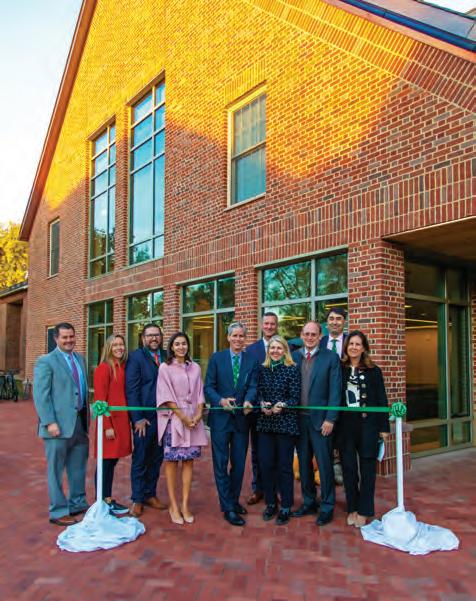
Under crisp autumn skies, Academy trustees, employees, and invited guests gathered for the dedication of Simmons Dormitory on October 28. The 33,600-square-foot building features four faculty apartments, a common room and a game room, an elevator, a student laundry room, storage for faculty and students, and enhanced green spaces outside. Simmons is a boys dorm and houses 20 students.
L TO R: Project Manager Andrew DeMado; Assistant Head of School for Student Life Amie Creagh P’22,’24; Chief Financial Officer
Matthew Sheehy, President of the Board of Trustees Leila Govi ’93 P’26, Julie and Brian Simmons P’12,’14 H’22; Head of School
Dr. John Austin and Monica Matouk; BACK: Director of Operations Jeff Galli P’25,’26; Trustee Ben Clark ’96
THERE ARE NO INDIVIDUAL ACCOMPLISHMENTS; EVERYTHING WORTHWHILE THAT COMES OUT OF THE BOARD IS THE RESULT OF COLLABORATIVE GROUP EFFORT AND SHARED DECISION MAKING. DEERFIELD’S BOARD IS AN INCREDIBLE ORGANIZATION WITH UNBELIEVABLY CAPABLE PEOPLE. —Brian Simmons
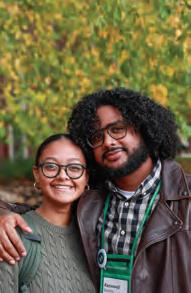
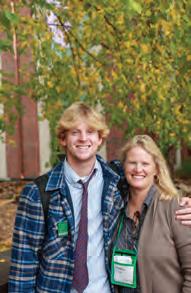
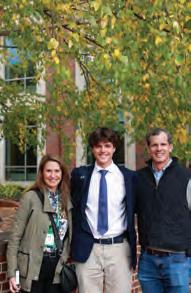
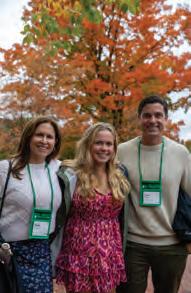
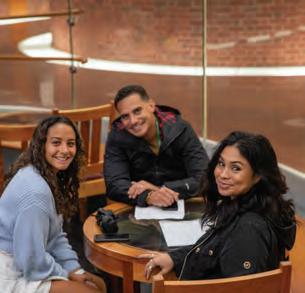
Nearly 1000 family members joined their students on campus October 14 - 16 for the 2022 Fall Family Weekend. They attended their children’s classes on Friday and a welcome from Head of School Dr. John Austin (see page 2 for his remarks), cheered at Saturday’s athletic events, and enjoyed receptions and meals prepared by the Dining Hall staff throughout. //
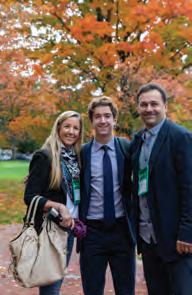

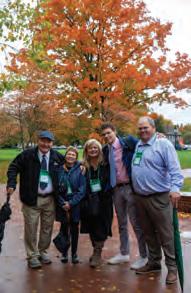
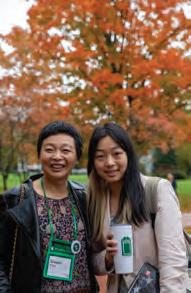
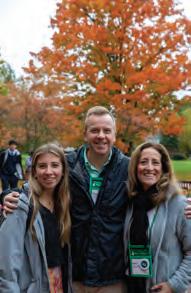
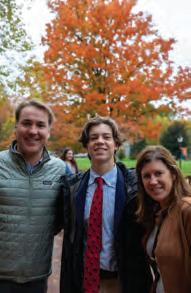
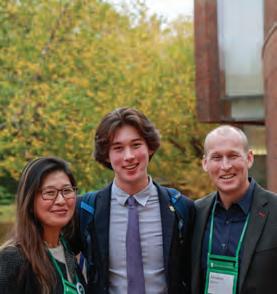
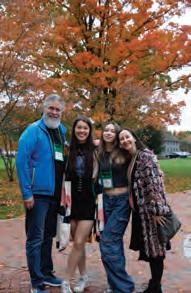

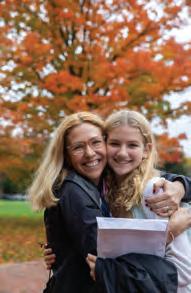
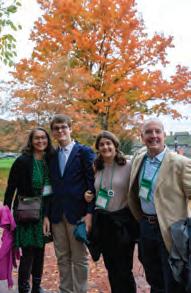
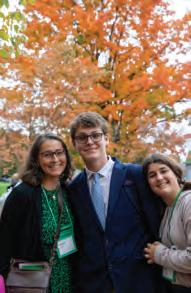
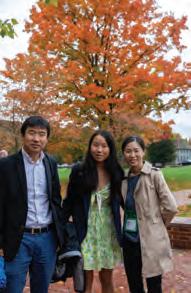
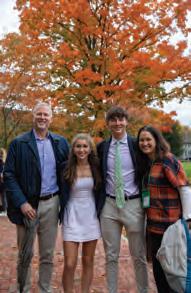
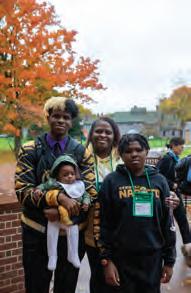
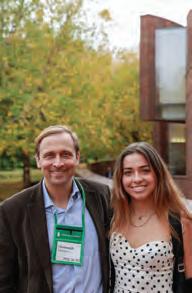



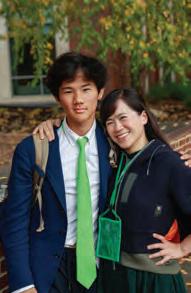
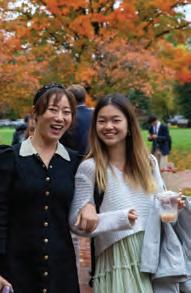
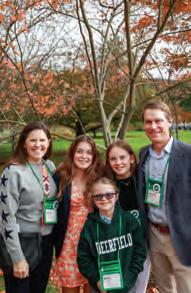
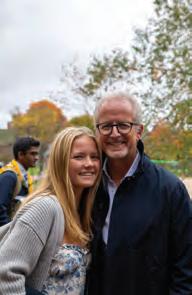
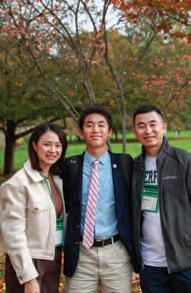
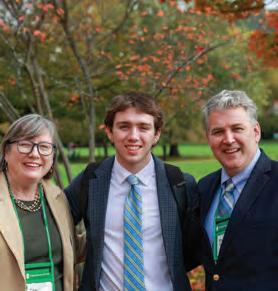
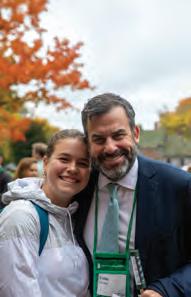
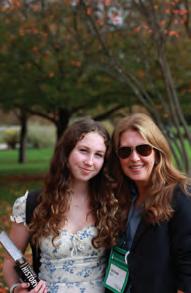
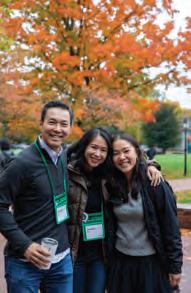
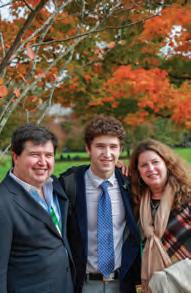
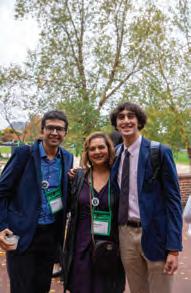
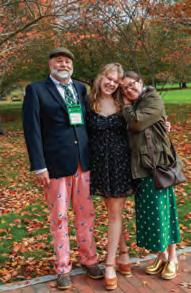


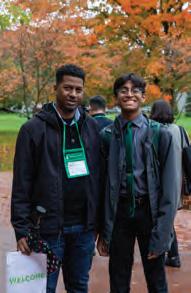
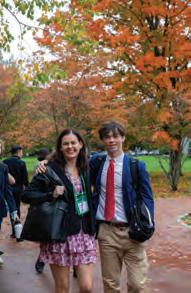

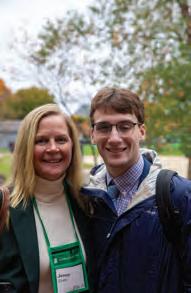
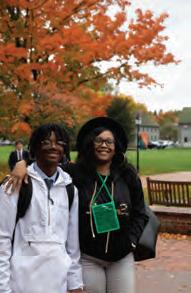
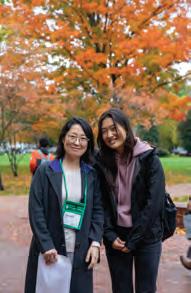
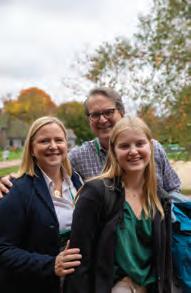
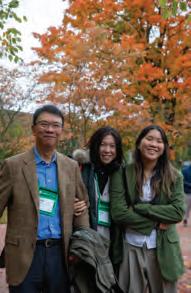
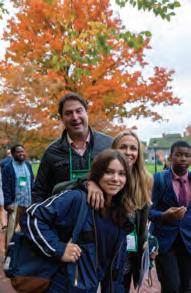
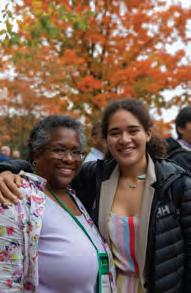
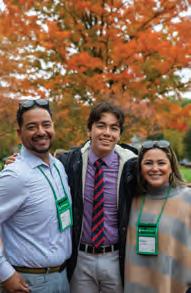
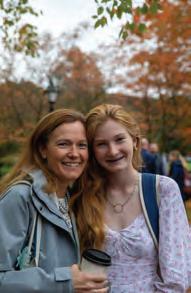
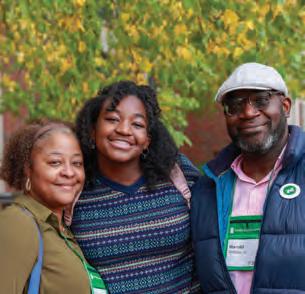
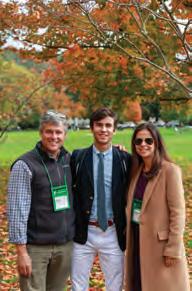
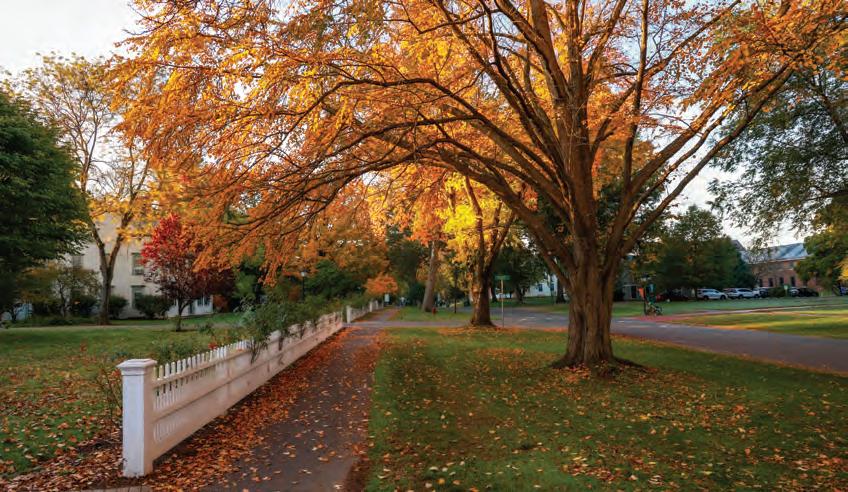
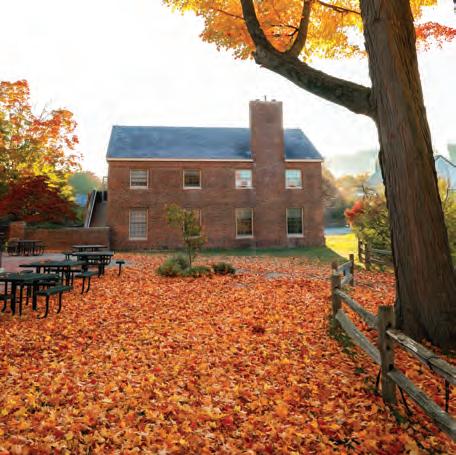
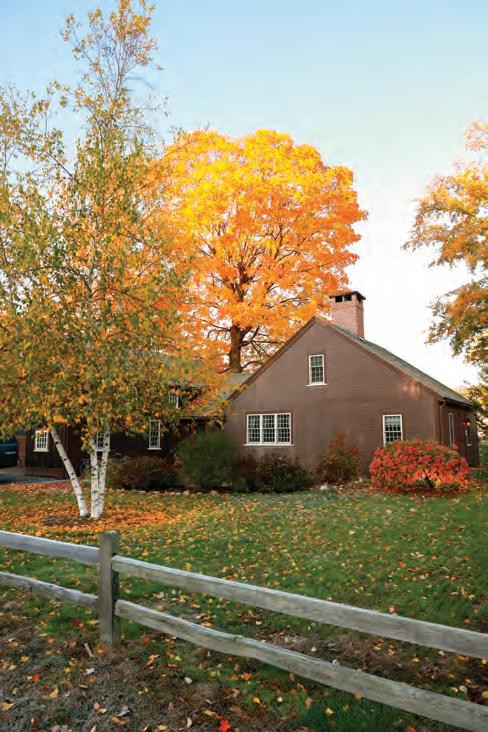
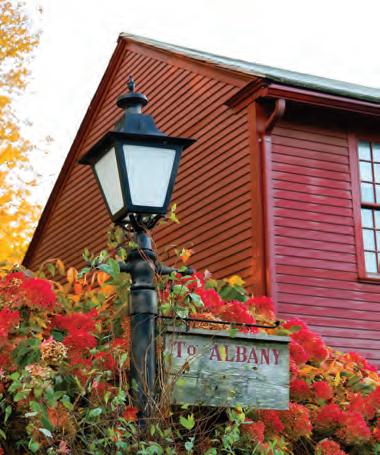

 D -AP PLE D CA MP US
MEGHAN HOAGLAND
D -AP PLE D CA MP US
MEGHAN HOAGLAND

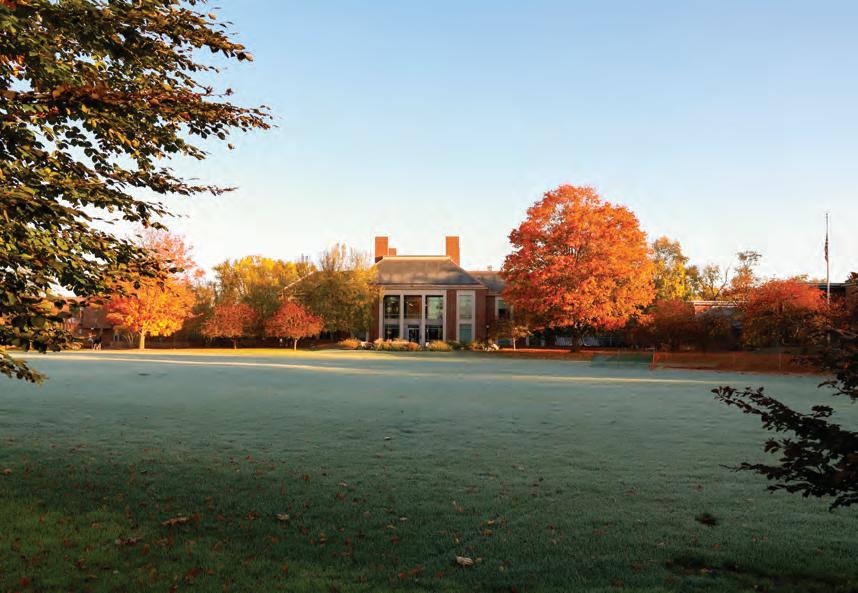

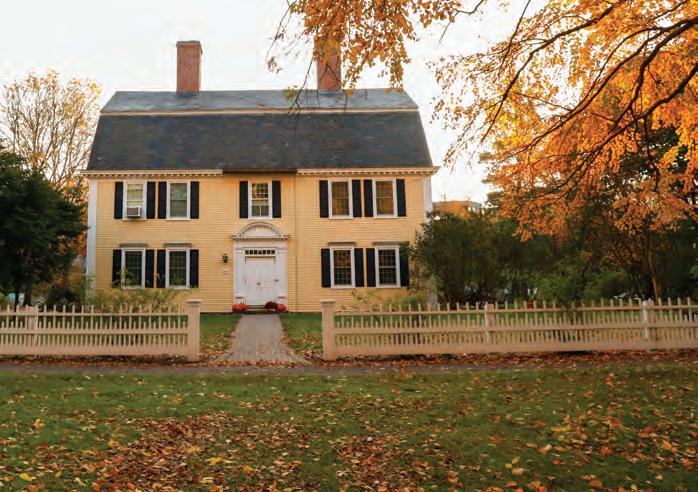


Six longtime Academy employees recently retired—their service totaling a remarkable 155 years. From the Finance Office to the classroom to the Boyden Library, these are Deerfield people at their best, and they have had an indelible impact on the community in so many ways. On behalf of the Academy, thank you!
By LORI FERGUSON ///
Asked if he remembers his first days at Deerfield, former Chief Financial Officer Keith Finan laughs wryly. “I started in August of 2011,” he recalls, “and my second week there, an earthquake that originated in Virginia shook the entire Eastern seaboard, rattling objects in my office. Then the Sunday before Labor Day, Hurricane Irene tore up the coast, flooding Deerfield’s playing fields and dumping copious amounts of topsoil across the campus. And the day of my first Board meeting, we were hit with a foot of snow. I began to wonder what I had signed up for.”
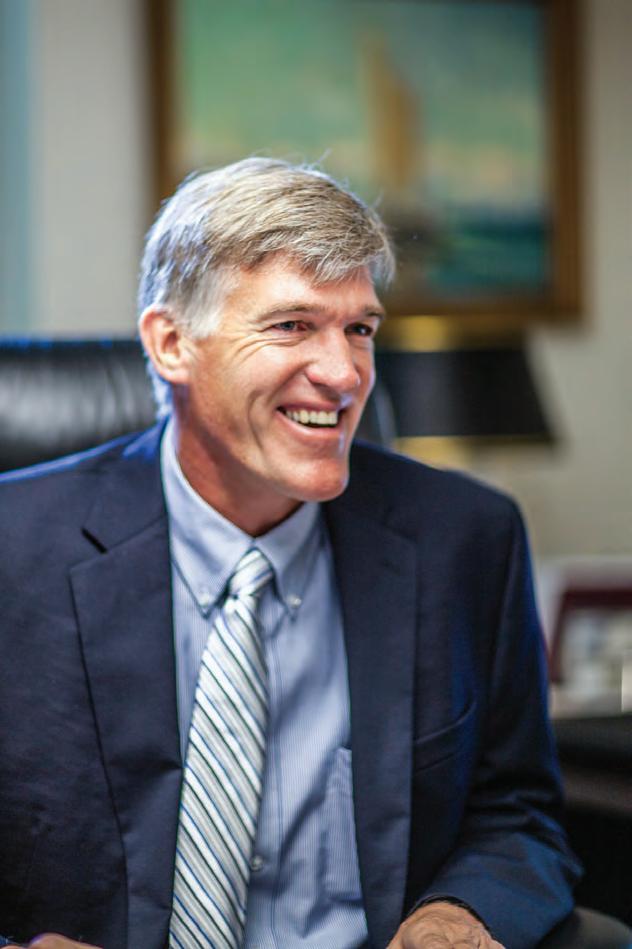
Fortunately, Keith wasn’t dissuaded. He remained at the Academy for the next decade, helping the institution regain its financial footing after the Great Recession. “My predecessor had already gotten the ball rolling—there were a number of layoffs and budget cuts in 2010—so the recovery was underway when I arrived,” he answers.
Keith came to Deerfield with great depth of experience, having managed budgets at Williams College for the last 25 years. He saw Deerfield as the perfect place to complete the last 10 years of his career. “I was looking for more responsibility and an opportunity to try something new, so when a headhunter knocked on my door and told me about the position at Deerfield, I jumped. The spirit and sense of community at the Academy really drew me.”
During his decade at Deerfield, Keith focused on ways to enhance revenue and build back after the 2008 recession. One initiative included expansion of the Academy’s summer programs. “We had a tradition of offering summer programs for athletics, so we decided to expand into academic programs as well and began offering an educational program for gifted middle school students. It was a terrific way to get the Academy’s name out there and to generate revenue for the school year-round.”
Keith was also at Deerfield for an extraordinarily successful, five-year capital campaign that raised $242 million and ended a year early. “It was incredibly rewarding to witness the way in which the entire Deerfield community rallied to support the institution and help us reach our goals,” he recalls.
But Keith says that what most excited him throughout his tenure at the Academy was his interactions with students. “I loved supporting initiatives that got the kids excited and made Deerfield a more enjoyable place to go to school,” he says.
Nowadays, the kids that Keith is focusing on are his own children and grandchildren. “I’ve been spending a lot more time with my grandkids, which I love.” And with his wife recently retired as well, the calendar is quickly filling with travel plans. Already in the rearview mirror: a journey to the Galapagos Islands and scuba diving in Honduras. Next up: wandering the backroads of Maine, New Hampshire and Vermont in a new Airstream camper.
While Keith is grateful for the increased leisure time that retirement affords, happy memories of his years at Deerfield linger. “I think of all the people I worked with over the years who care so deeply about the school and one another,” he explains. “The sense of community attracted me initially and sustained me through good times and bad. I’m grateful to have worked with so many individuals who were so focused on what was best for the institution.” //
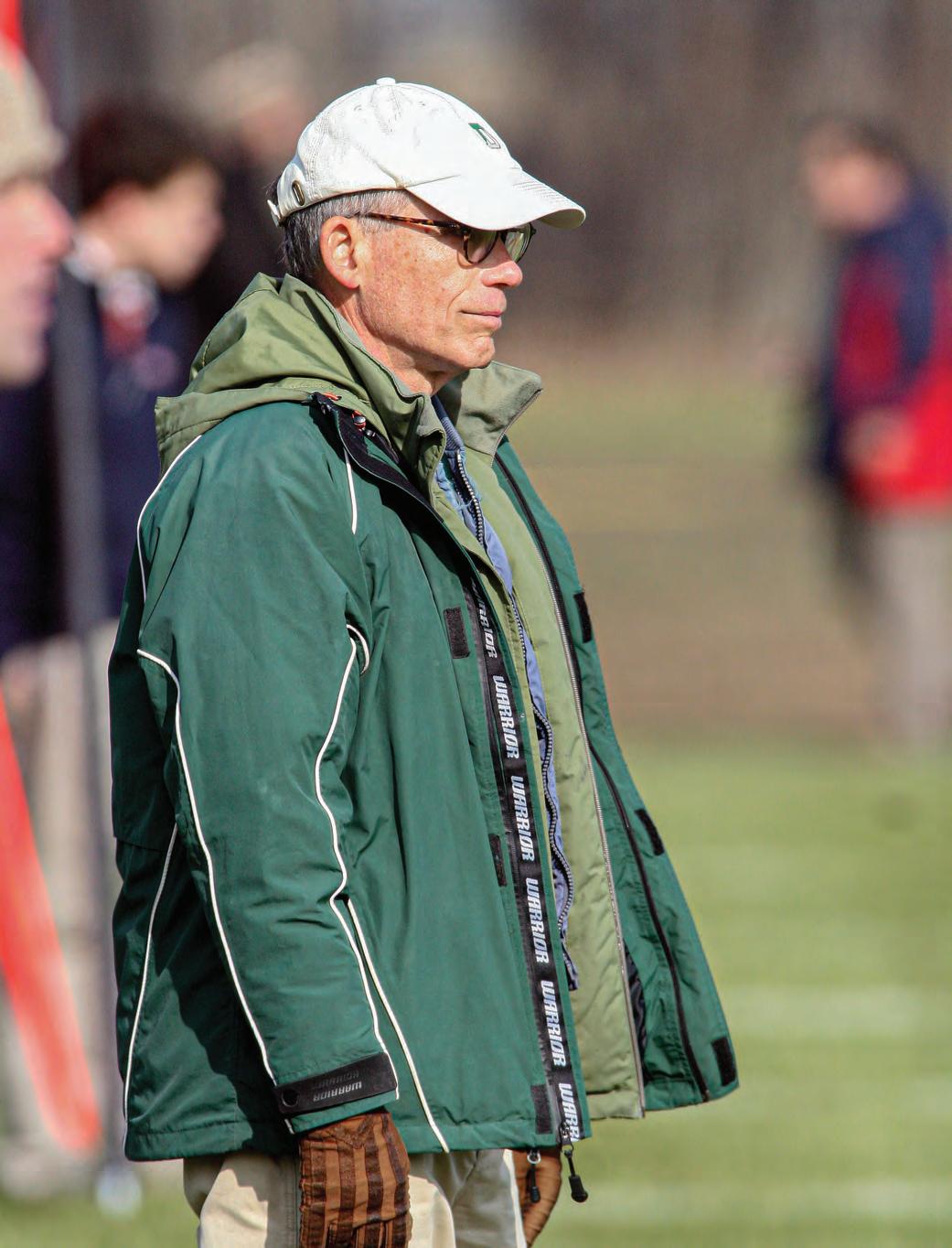
Wayne Marge’s affection for mathematics is evident. Yet in many respects, no one is more surprised than he that he spent the lion’s share of his career—including 21 years at Deerfield—teaching this subject. Wayne entered college planning to major in biology and chemistry, took brief detours into English and philosophy, and ultimately decided to pursue a bachelor’s in fine arts from Haverford. After teaching art for a brief time, he headed west to pursue an MFA in sculpture. Once he had obtained that degree, Wayne returned to his home state of Rhode Island, began working as a laborer on the railroad, and started to think about next steps.
“I had always loved math, so I started taking college courses at the University of Connecticut, completed my undergraduate degree at Connecticut College, and started graduate school in the field,” he recalls. Plans to pursue a career as a math professor changed, however, when he discovered that many college students were jaded. But younger students were still excited about learning. “A friend was teaching at Hotchkiss, and when I visited her on campus, I liked what I saw. I loved the idea of teaching, and it seemed like a position at an independent school would be the perfect fit.” Stints at The Hill School and Hotchkiss, followed by more than two decades at Deerfield before retirement in 2021, only confirmed Wayne’s intuition. “Throughout my career, I loved being in the classroom and working with students,” he enthuses.
And Wayne was intent on sharing that joy. “Throughout my years of teaching, my goal was to make math a joyous experience at some level for every student,” he observes. “I tried to convince kids that they needed to find enjoyment in whatever they were doing or that life would be drudgery.”
Wayne also embraced the other responsibilities of boarding school life with equal zeal. “I enjoyed the athletics—I coached two or three sports every year— and I found joy in my residential duties. Living in a dorm with junior and senior boys was interesting—they’re not always terribly emotive,” he says with a chuckle. “The job was a ton of work but also a lot of fun.”
To succeed in the boarding school environment, Wayne insists one must make peace with the time commitment that’s required. The job is all-consuming. “Not everyone is built for this type of work,” he concedes, “but for those that are, it’s a wonderful life.”
When asked to summarize his memories of Deerfield, Wayne doesn’t hesitate. “I think of the wonderful students and families I had the privilege of meeting over the years,” he observes. “The students were extraordinary, and I felt fortunate to be their teacher. I felt lucky when I was teaching,” he concludes in a rush of enthusiasm. “I loved what I was doing, where I was doing it, and with whom I was doing it.”
These days, Wayne feels lucky to be focused on family and friends. After retiring, he moved back to Rhode Island to be closer to his siblings. “I live a couple of miles from two of my brothers, so I see them frequently, and I have another brother in North Carolina that I hope to visit soon,” he says. He also enjoys hearing from former students and encourages any who would like to stay in touch to reach out to him at Wayne Marge, 1275 Curtis Corner Rd., Wakefield, RI 02879. Phone: (413) 522-5404; email wsm314@icloud.com. //
I TRIED TO CONVINCE KIDS THAT THEY NEEDED TO FIND ENJOYMENT IN WHATEVER THEY WERE DOING OR THAT LIFE W OULD BE DRUDGERY.
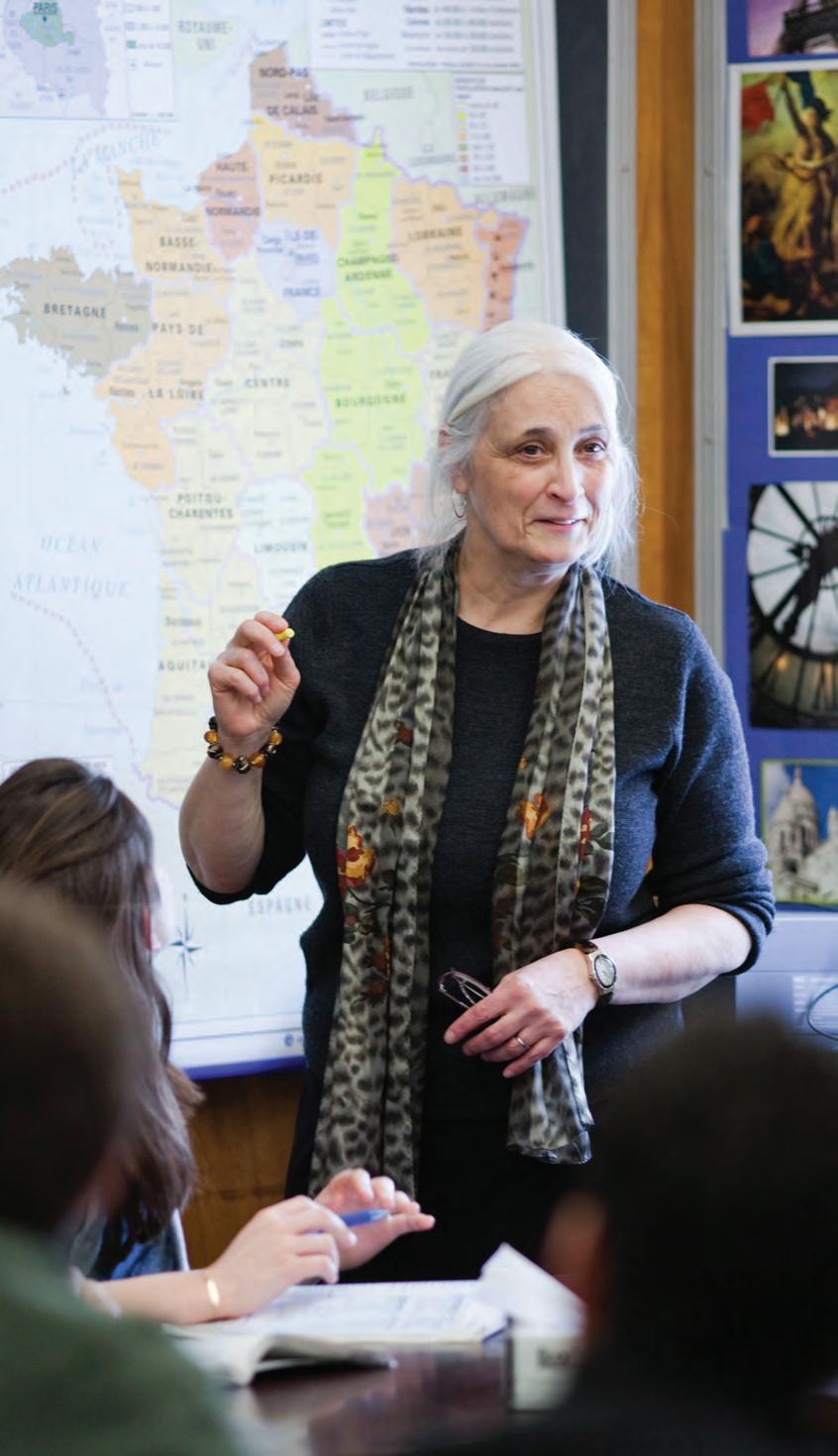
’21
Thank you. Good evening, Dr. Austin, faculty, and the Class of 2021, and bonne soirée à mes élèves de français.
It has been my good fortune in our time together at Deerfield to engage with a great number of you in a variety of roles and capacity. For many of you, I have demystified the French subjunctives. For two of you, I have partnered in running a pandemic dorm with rowdy good humor, and you know who you are.
For the furthest traveled of you, I have verified your vacation lodgings and sampled your Alliance dishes. But I wish to speak with all of you on this occasion simply as a happy person.
I have been happy in my life with life itself, with the experiences and opportunities that have surrounded me and filled me with excitement, delight, and certain amounts of wisdom and profound inner contentment.
This is not to say that there haven’t been events and circumstances that have intruded on my happiness and frightened or saddened me on occasions and, at times, for extended periods. You need only to look at your own young life and apply its ups and downs to the similar circumstances that challenge yourself.
The thing I would most like to share with you is the value of not allowing difficulties and uncertainties to defeat you in spirit but instead to continue seeking and finding constant delight in the people around you and in things, both small and large, as you make your way through the frequently unpredictable circumstances of your lives.
My own beginnings in what has now been an extensive life, a polite way to saying old age, were in my native country of France, growing up in the great City of Paris, where my understanding of the world revolved around all things French—food, traditions, attitudes, and a growing excitement of reading the classics of French literature.
I felt myself steadily becoming a permanent part of my surroundings as much as one of the very stone of its ancient buildings. And from my own educational experience, I began to develop a strong sense of becoming a teacher myself.
My stepfather, a talented sculptor in wood who had graduated from the renowned School of l’Ecole des Arts et Métiers, encouraged me to learn a specialized skill. But an unforeseen series of family crises and dealt my future options a major setback. And suddenly, I was confronted with choices which did not appeal to me, nor promise to fulfill my deepest interest.
With new burdens weighing on my further education, I took a sudden and extraordinary leap of faith and answered an offer in a major French newspaper for a governess with a French family attached to the United Nations in New York City.
My only prior sense of America had come from TV and newsreels. And to find myself in the midst of the sights and sounds of New York was, to say the least, overwhelming. But the support of my French family led to opportunities I had not imagined.
Within a short period, I found myself enrolled in courses at Columbia University, attending a Chuck Berry concert at the old Fillmore East, and discovering such unknown things as ice cream sandwiches, cheeseburgers, and corn on the cob.
In spite of my still shaky English, and being at times awestruck by the whirlwind of experiences, I began almost imperceptibly to feel at home in this new country. A fate that was sealed when I met, and later married my favorite American.
After beginning a new family and my husband’s return to graduate school, the long standing passions of my own education began to resurface, as I took vicarious delight in my husband’s role as a dynamic teacher.
But it wasn’t until what was beginning to seem like a career of its own, as a fashion buyer and a human resources director for a national department store chain, that I quietly enrolled in courses toward a college degree at a local university in Tampa, FL.
When we took our oldest daughter on a visit to colleges, I fell in love with one beautiful campus after another. And when she enrolled in Mount Holyoke College in South Hadley, MA, a part of me went joyfully with her. Never would have I imagined that, in four short years, I would literally follow in her footsteps.
While I was accumulating college credits in Florida, a program at Mount Holyoke for non traditional age students, Frances Perkins scholars, came to my attention. And with
There is a classic of French literature that is taught widely in French classes around the world. Saint Exupery’s story of Le Petit Prince The Little Prince. Some of you may know it—who falls to Earth from a distant planet and marvels at our strange world.
In his many encounters, he comes upon a railroad yard where a railman directs the trains onto the right tracks toward their destinations. The railman explains to the little prince that the adults on the train, seldom appreciate the journey they are taking.
the encouragement of my husband and both daughters, I applied and was accepted at this venerable institution of women’s education.
In the summer of 1996, we relocated to Amherst, MA. And that fall, at the age of 44, I realized my childhood dream. Each morning, driving over the Holyoke ranch to South Hadley, I experienced such delirious excitement that my husband and younger daughter began jokingly to worry that I might wreck the car.
Upon graduating from Mount Holyoke, I took advantage of the proximity of another bastion of women’s education and took a master’s degree in teaching French and history from Smith College. Without a mountain ranch to cross, my daily commute to Northampton became simpler but just as giddy.
My final relocation here at Deerfield, as a French teacher, completed the destiny of a long and winding journey. One that remains to this day, a constant joy. Throughout its many stages, I never abandoned the belief that no matter the uncertainty of my situation there was much to be discovered, that would reveal itself and provide me with choices worth pursuing.
They fail to take note of the world outside the windows and prefers to sleep or hobo themselves in activities until they arrive at their destination. “It is only the children,” the railman says, “who press their noses against the windows as the trail, train rolls across the land.”
Most of you had just recently come out of childhood when you began your journey through Deerfield, and now you have finally reached that destination on which you set out four years ago or so.
It is my great hope that in your years at Deerfield you have not abandoned the childish qualities of wonder, imagination, adventure, and delight that once filled most of your waking hours in the earliest years of your still-young life.
In a few days from now, you will leave Deerfield. And all of you, in a few months’ time, will embark on new journeys, whose destination will place you firmly at the beginning of adult lives and careers.
As you and I climb up to the next train, different destinations for sure, I commend you to join with me, as I have done in my own way throughout my many experiences, to keep your noses pressed against the windows of life with as much childlike wonder as you may still retain within you.
Thank you, and God bless. //
IF WE RESIST COMPLACENCY, IF WE EDUCATE OUR HEARTS, WE CAN BE PART OF THE LIGHT IN THE WORLD.
When longtime mathematics teacher Nils Ahbel thinks back over his time at Deerfield, it’s the biennial faculty lip-synch musicals that stand out as a favored memory.
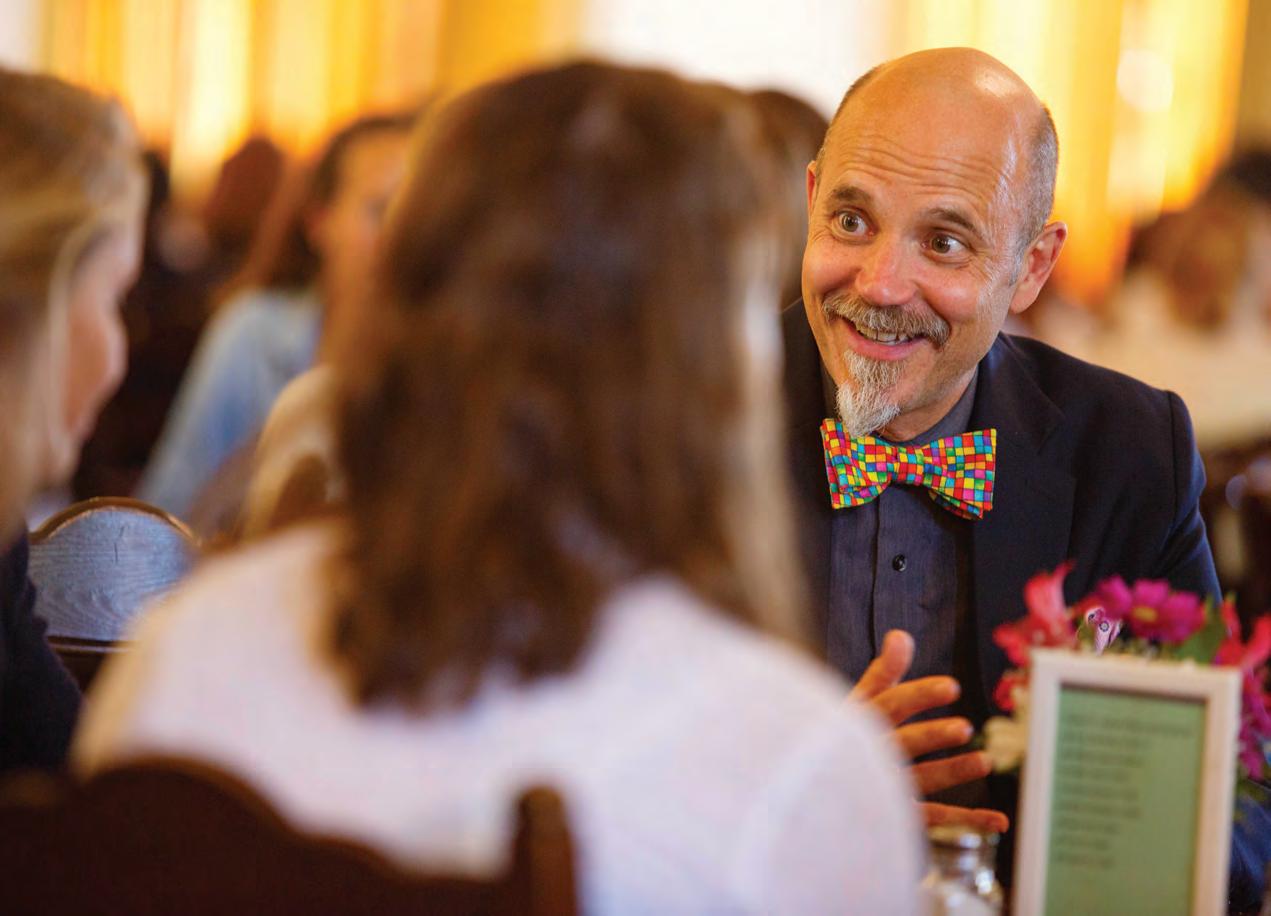
“I’d find a top-ten hit that was popular with the kids and spend about 40 hours prepping a 75-second rendition,” he recalls with a chuckle. Over the years, Nils performed everything from Will Smith, Flava Flav, and Soulja Boy to Bruno Mars and Justin Bieber.
“I would give the students one minute and fifteen seconds of the best performance I could possibly give.
I worked hard to make the kids laugh and, more importantly, bring something from an old guy that told them I valued their culture.”
This determination to engage his students and capture their imagination was a hallmark of Nils’ twenty-four years at the Academy. “As an educator, my goal was always to make math as relevant, useful, and inherently interesting as possible,” he says.
By Daniella VollingerThis goal went hand in hand with Nils’ determination to be a leader in his field.
“When I left the Kent School and came to Deerfield Academy in 1997, it was because
I wanted the opportunity to be a leader at one of the country’s top prep schools,” he says candidly. Over the next twenty-four years, Nils got his wish, seizing multiple opportunities to distinguish himself as an innovative educator . . . at Deerfield and in the wider world of academia.
Nils’ first job at the Academy was as Academic Technology Coordinator. “I started Deerfield’s laptop program in my first year,” he recalls proudly. In addition to providing faculty tech support, he also taught one math course. After five years, Nils was named chair of the Mathematics Department. He also served one year as interim academic dean and was later holder of The Class of 1952 Chair in Mathematics.
Throughout his illustrious career, Nils approached education with a signature style that emphasized innovative, forward-thinking ways of teaching his subject. “I was always thinking, ‘Where are we going to be in five years?’”
Take Precalculus and Statistics, a course Nils wrote and taught for many years. Rather than assigning dry questions to test their knowledge, Nils challenged students to apply sophisticated, challenging mathematics to real-world issues such as hydraulic fracking, global warming, and the dangers of alcohol.
“I divided the class into two groups, pro and con, and over the course of a week had them research the topic, make arguments for or against, support their position with a statistically based argument, and reply to the other side. Then everyone switched sides and repeated the exercise. It was a fantastic way to teach students that the math skills they were learning could be useful, relevant, and interesting.”
Nils quickly adds, however, that he takes issue with his designation as a teacher. “I worked to develop capacities in students, not teach them,” he insists. “In my mind, the purpose of education is to develop capacities for critical thinking, communication, problem-solving and collaboration, and even more importantly for curiosity, creativity, and empathy. What you teach must have ‘transfer,’ the ability to be used elsewhere.”
Nils certainly walked the walk. During his years at the Academy, he also actively shared his innovative pedagogy outside the classroom, authoring three textbooks and writing a free, full-year, online math course for students who completed, but struggled with, Algebra II. It proved enormously popular and continues to be used at Deerfield as well as 50 other schools nationwide.
Nils also served on numerous product development teams for Texas Instruments, served a ten-year stint as lead math teacher on the product development team for tablet PC software FluidMath, and spent countless hours teaching teachers about teaching teenagers.
“During my 33 years as a teacher, I spoke at about 250 conferences,” he says. “These presentations made me stronger in the classroom— I got some of my best ideas prepping for conferences and fielding tough questions from other educators.”
These days, however, the toughest question Nils faces is how to spend his free time. “My wife Lisa and I are foodies and spend a lot of time in the kitchen making kombucha, Dijon mustard, and other delicacies and baking lots of bread.” Summers find him in his garden or sailing his 14’ Sunfish. Plans for retiring to Florida are also in the works.
For the moment, however, Nils is content sticking close to home, near to friends and family. “I’ve travelled so much in my lifetime— I’ve been to six continents and lived in four countries—and I’ve carried the great name of Deerfield around the world. I’m proud of what I did to represent the Academy outside of the Academy.”
“I’m so happy being retired,” he concludes. “Teaching was my passion for many years, but I had a very fulfilling career and to be honest, I don’t miss it. I do, however, miss the Deerfield community —it’s wonderful, and I loved being a part of it.” //
I’VE BEEN TO SIX CONTINENTS AND LIVED IN FOUR COUNTRIES— AND I’VE CARRIED THE GREAT NAME OF DEERFIELD AROUND THE WORLD. I’M PROUD OF WHAT I DID TO REPRESENT THE ACADEMY OUTSIDE OF THE ACADEMY.
As he entered his senior year at Williams College, Spanish major Steve Taft had a path mapped out in his mind: earn a law degree and then pursue a life in politics. But in the midst of applying to law schools, something snapped. “I suddenly thought, ‘No, not now,’” he recalls. Instead, Steve pivoted and began applying for teaching positions in prep schools. The lifestyle was not a new concept, he hastens to add. “I was a faculty brat from Phillips Exeter; my dad taught there for years.”
Nevertheless, the decision proved to be propitious. Steve landed a job at Connecticut’s Pomfret School, where he taught for three years, entertained a brief foray into the D.C. political scene, completed a master’s degree in Spanish at the University of Virginia, and moved to Madrid to immerse himself in the language and culture. In 1984, a visiting friend brought a copy of the New York Times job section, which listed a job teaching Spanish at Deerfield. Steve responded and was hired. He remained at the Academy for the next 36 years, retiring in 2020.
Teaching was a joy from first day to last, Steve asserts. “The opportunity to introduce students to the delights of extending one’s world by meeting and interacting with other cultures was so rewarding.” But he also remained mindful that Spanish was not the most important thing happening in his students’ lives. “My main goal was to enable every kid to grow up to be the person they wanted to be,” he explains. “We’re all on our own path in life; my role was to help keep the kids on track.”
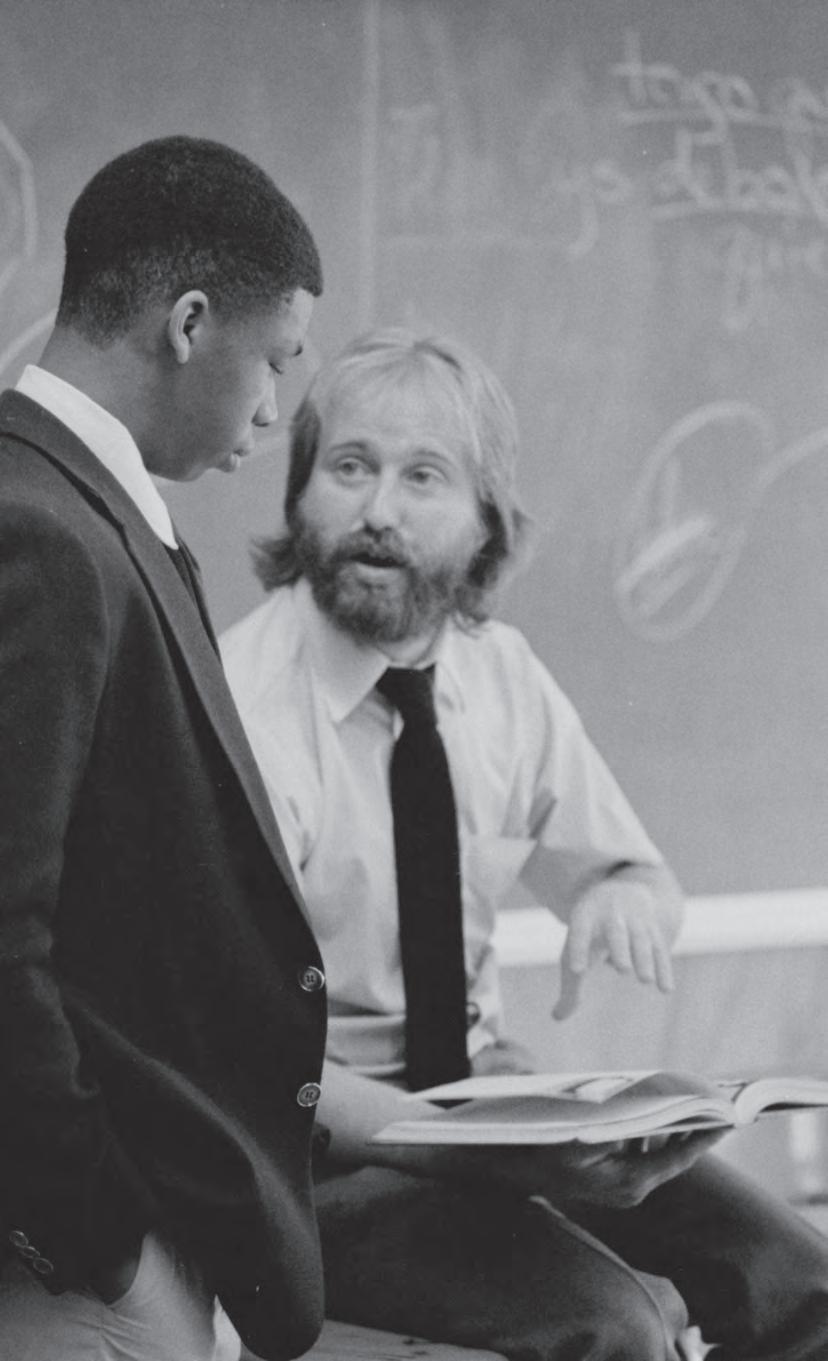
Life at Deerfield was good. “The prep school lifestyle appealed—it allowed me to integrate my life with my job. I could teach Spanish, coach, serve as a dorm parent, and raise my family, all in one place.”
Queried as to his favorite memories from over three decades at the Academy, Steve pauses for a beat. “There were so many good things,” he says finally. “It’s a toss up between the joy I found in working with the kids—whether in the classroom or on the sports field—and the satisfaction I derived from being an advocate for my fellow faculty members. I treasured my time working on faculty issues, and the kids—right to the very end—were beautiful, fresh, and fun. They can make anything interesting!”
Deerfield was an essential part of his life, indeed all his life, for 36 years, Steve observes. “It was an excellent spot to live and work, thanks to colleagues and students.” Caring administrators made a lasting impression, too. “I’m something of a gadfly, but I felt like administrative staff always listened and allowed me to speak my mind,” he says with a soft laugh.
In the end, however, it’s the particularity of the place that looms largest. He and wife Virginia recently settled into a new home a scant 16 miles from Deerfield, just over the Vermont border, and have no plans to venture further afield than Colorado to visit their two sons. Steve hikes the woods around his home, chops wood, and works on a little cabin on the property. Virginia commutes to St. Paul’s School in Concord, NH, where she continues to teach Spanish. Both remain grateful for the small-town New England lifestyle they enjoy.
“When I think of Deerfield, I think of green—the beautiful nature of the fields, the River, the Rock—and, of course, the people and the good I sought to do,” Steve concludes. “I like accomplishing good things for people, and that’s what the Academy aims to do as well.” //
WHEN I THINK OF DEERFIELD, I THINK OF GREEN—THE BEAUTIFUL NATURE OF THE FIELDS, THE RIVER, THE ROCK—AND OF COURSE THE PEOPLE AND THE GOOD I SOUGHT TO DO . . .I LIKE ACCOMPLISHING GOOD THINGS FOR PEOPLE AND THAT’S WHAT THE ACADEMY AIMS TO DO AS WELL.
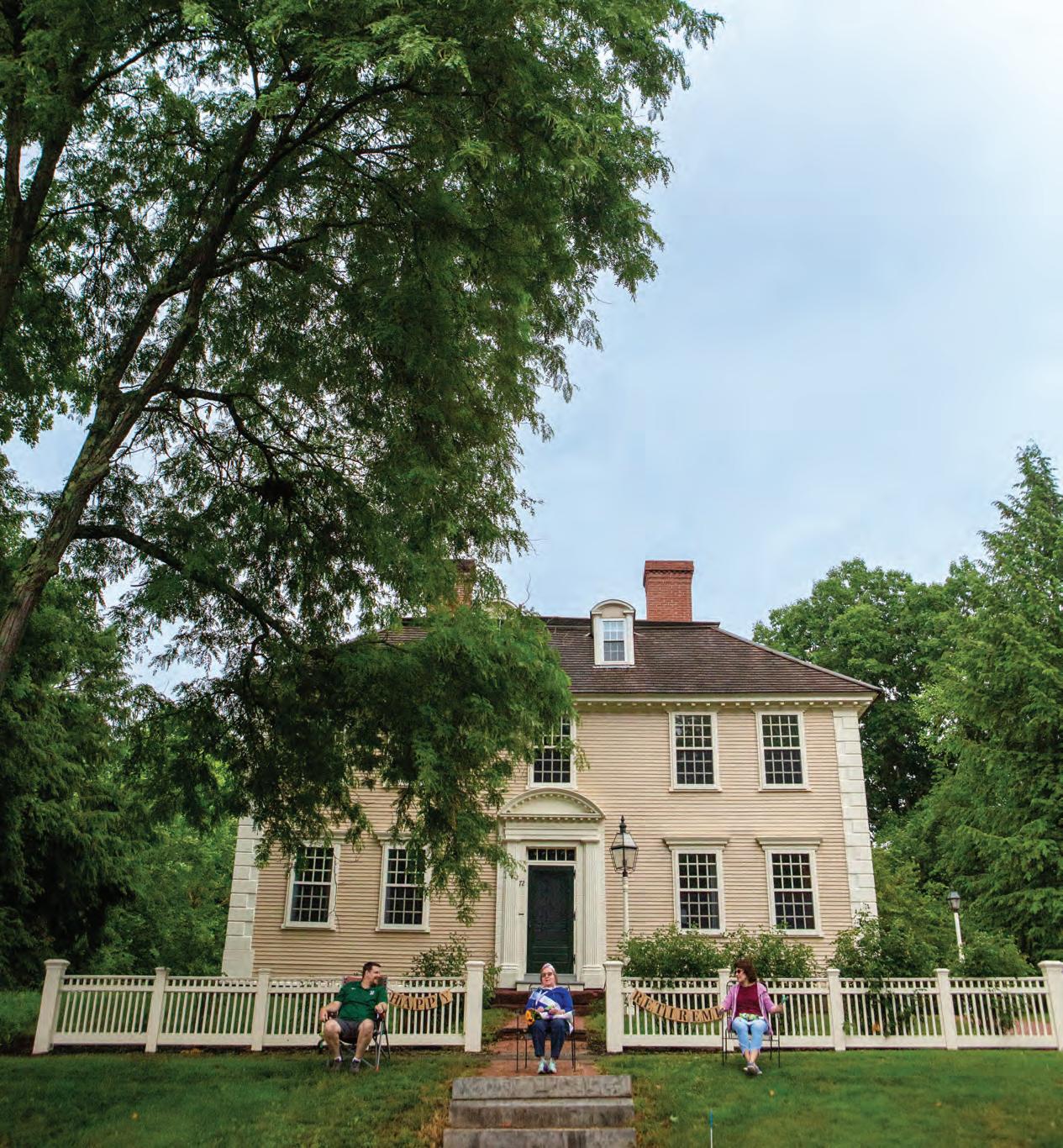
“
As a college student, Patricia Kelly majored in Chinese and envisioned a life in academia. But as so often happens, life intervened. “I was in graduate school in Hawaii when my father passed away,” she explains. “I came home to help my family and realized that I needed to find a job as well. My three brothers attended Deerfield, and my youngest brother, then a senior, told me about a job in the Academy library. That was in January of 1978.”
Patricia interviewed and was hired. For the next four decades, she was a steadfast presence in the Deerfield library, subsequently working under the aegis of five heads of school and six library directors. “I was hired as a cataloguer, then became a catalogue librarian, then a catalogue and systems librarian and finally assistant library director,” she notes.
Patricia views her impact on the library’s technology as among her most important achievements; during her tenure she was responsible for implementing three different technology systems, including the library’s first online system in 1991. “I brought technology into the library, and over the years a lot of changes rested on my shoulders,” she says proudly.
In many ways, no one was more surprised than she how things turned out. “When I started the job, I was a technophobe,” she confesses with a laugh. “I learned a lot on my own, and my oldest brother also coached me and helped me get over my fears. I came to love the work, particularly helping students conduct research . . . those were my favorite projects.” She fondly recalls helping one student who had hit the wall with an Asian history project. “The young man told me he just couldn’t do the research, and I told him he could. I met him at the library and sat with him there all night long. He did fine— he simply needed the space to work the problem through.”
DEERFIELD IS AN E XCEPTIONAL PLACE TO LEARN AND GROW AND BE YOUR BEST SELF...MY CO-WORKERS WERE GREAT—THEY ORGANIZED A PARADE FOR ME ON MY LAST DAY, COMPLETE WITH FIRETRUCKS AND POLICE. IT CAUGHT ME COMPLETELY BY SURPRISE. I FELT VERY SUPPORTED BY THE ADMINISTRATION. WHENEVER I NEEDED TRAINING, THEY GENEROUSLY MADE THAT POSSIBLE. THAT WAS ONE OF THE BEST THINGS ABOUT MY JOB—I WAS ALWAYS LEARNING SOMETHING NEW.”
The ability to work problems through is a skill that Patricia tried to impart to every student she encountered. “I loved doing reference work with students and helping them research. I viewed that as my tool for teaching them the importance of being resilient. In research, if you go down one path and hit a roadblock, you simply change directions. It isn’t a straight line, so you can’t be afraid to try something different. And that’s the way life is, too; you need to learn to be resourceful.”
Patricia knows this all too well. She retired on June 30, 2020, and just six days later found herself hospitalized, unable to walk. In February of 2021, she had back surgery. Thanks to supportive family and friends, she is now up and around again. “It was a challenging period, but I feel very blessed by all the people who helped me. I’ve always been the family caregiver, so it was hard to accept help, but I did, and I learned a lot in the process.”
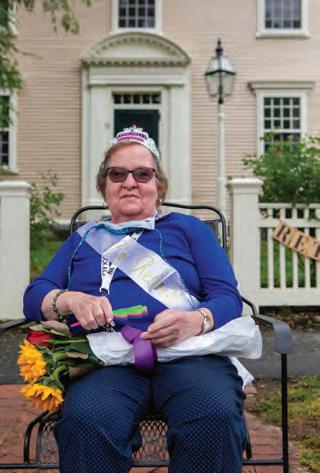
Now Patricia is focused on learning even more. She recently enrolled in the Genesis School for Contemplative Living. “I’m trying to get more disciplined in my life,” she confesses. She’s taken up photography as an online self-study with the Abbey of the Arts. “I’m hoping to gain fresh insights on the world.” But mostly she’s enjoying the freedom that comes with setting her own schedule. “The best part of retirement is reconnecting with neighbors and family. No more working nights and weekends; I plan to do more travel in the future.”
Although she enjoys her free time, Patricia also looks back on her time at the Academy with great affection. She enjoyed her student encounters and fondly recalls her service as the Toin International Exchange Student program liaison. “This program offered students an opportunity to study in Yokohama, Japan for a summer, and I participated as both a guest teacher and a chaperone.” A number of Deerfield students attended over the years, she says, and for some it was a life-altering experience that led to a future career. //
Anna-Marie McLemore ’04 was the busiest writer during the pandemic—publishing books with Feiwei & Friends. The Mirror Season hit shelves in March of 2021 and was longlisted for the National Book Award in Young People’s Literature.
Lakelore debuted March of 2022, was named a Junior Library Guild Selection, and was on the 2022 Horn Book Summer Reading List.
Her 2020 book releases are summarized below:
ANNA-MARIE MCLEMORE ’04 Feiwel and Friends New York / 2020
In 2020 they released Dark and Deepest Red, a story that begins in 1518 France, where an illness is causing women to dance until they die. Whispers of dark magic and witches are spreading as Lavinia Blau plots to save herself and her family from peril. Fast forward 500 years to when Rosella Olivia finds herself cursed by a pair of beautiful red shoes. The enchanted shoes draw Rosella towards Emil, whose family took the blame for the mysterious sickness all those centuries ago. Can Emil learn enough about the history of this puzzle to save Rosella? Open this page-turner to find out. //

ANNA-MARIE MCLEMORE ’04 HarperTeen / 2020
In the fall of 2020, Anna-Marie co-authored Miss Meteor with Tehlor Kay Mejia. Yet another YA hit, this story weaves a lost friendship back together after Lita decides to enter the Miss Meteor beauty pageant. Lita might not look like the past winners of this pageant, but it’s about more than beauty. Miss Meteor values a person’s whole self. Lita’s ex-best friend decides to help her try and achieve what no one thought was possible. //
This thought-provoking book delves into the connection between art and science, as the two disciplines attempt to understand and interpret the world around us. Palmedo, a former physicist who now writes about art, reveals how the two defining enterprises of humankind—art and science—are rooted in certain common instincts, which we might call aesthetic: an appreciation of symmetry, balance, and rhythm; the drive to simplify and abstract natural forms, and to represent them symbolically. //

LESLIE YERANSIAN DOLSAK ’96 6000 Sunsets / 2021
This Gold Moonbeam Award-winning book by Leslie Yeransian Dolsak is a testimonial to all that mothers do. Lovely colors and cozy illustrations by Ekaterina Filyakova match the warm tone of the story. This one would make a great gift for the new mom in your life. //

JAMES HARBERSON ’91 Markosia Enterprises Ltd / 2021
James Harberson’s collection of grim, satanic short stories will leave readers with chills. Stories include dark and demented characters such as healthcare workers who inventively strive to cause a car accident, and other diabolical beings. These are truly stories for those who enjoy dark tales and imaginative characters. //


LIZ PARKER ’03
Lake Union Publishing / 2021
Liz Parker’s debut novel is a dramatic yet funny tale of a destination wedding in Bermuda. As told through multiple points of view, the story of Tiny McAllister and her fiancé, Caroline’s wedding is brimming with humor and the melodrama that often accompanies a wedding. While Tiny’s family is present at the wedding, they are not there to play a supporting role. She is left wondering if she is making the right decision in marrying Caroline. The weather makes things worse as a storm rolls in, leaving the characters shaken. Will they make it to the altar, or does this story have an unhappy ending? Read it to find out! //
THE TEARS OF A MAN FLOW INWARD: GROWING UP IN THE CIVIL WAR IN BURUNDI BY PACIFIQUE IRANKUNDA
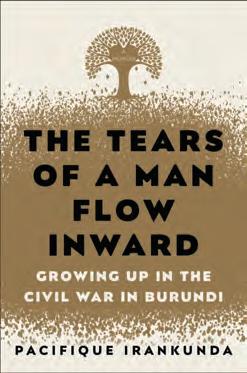
PACIFIQUE IRANKUNDA ‘09
Random House, 2002
This moving memoir dives into the devastating ways that civil war profoundly changes culture. Paci’s prose eloquently tells how the unrest destroyed his home and country. The memories shared in the book are not only his but those of his family members as they recall the rich culture and traditions of the Burundi people. While the losses are many, Paci and his family possess a love of country and the ability to persevere, making this book an interesting and uplifting read. //
DAVID J MATHER ’64
Peace Corps Worldwide / 2020
David J. Mather’s fourth installment in his Crescent Beach thriller series promises the same excitement and antics delivered in previous volumes. If you enjoy exploring Floridian swamps full of colorful characters, Gator Bait should be next up on your winter reading list. //



In the fall of 2021 Deerfield theater students presented Rumors, one of Neil Simon’s most celebrated comedies. The play focused on four couples who gather to celebrate an anniversary. Chaos, and much hilarity, ensued as the evening disintegrated into an outrageous and topsy-turvy romp. The students were funny, engaging, and the show was hit!
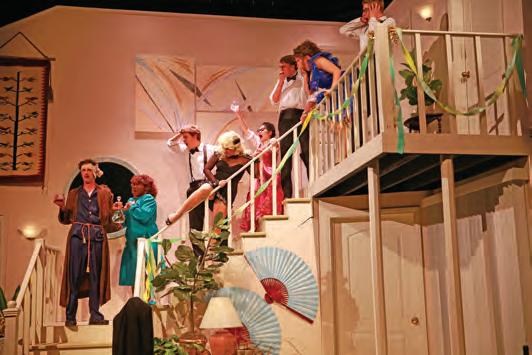
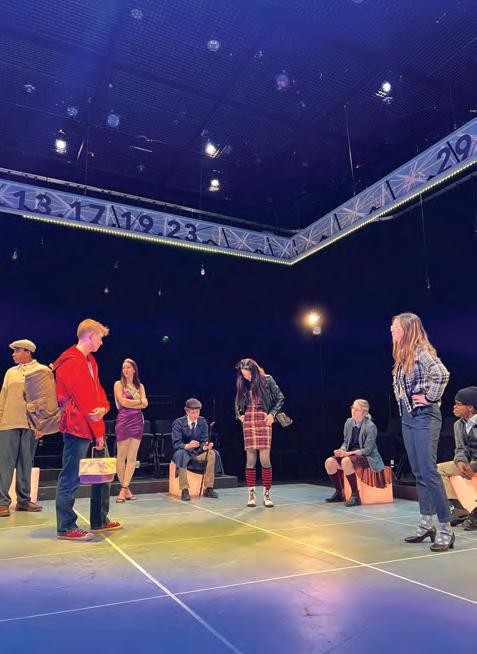


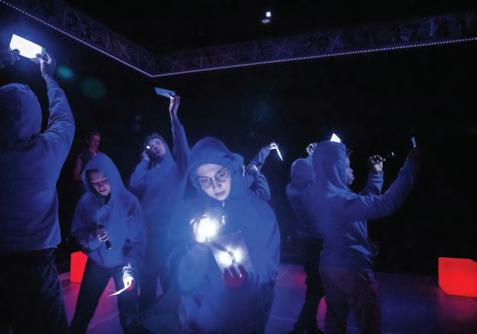
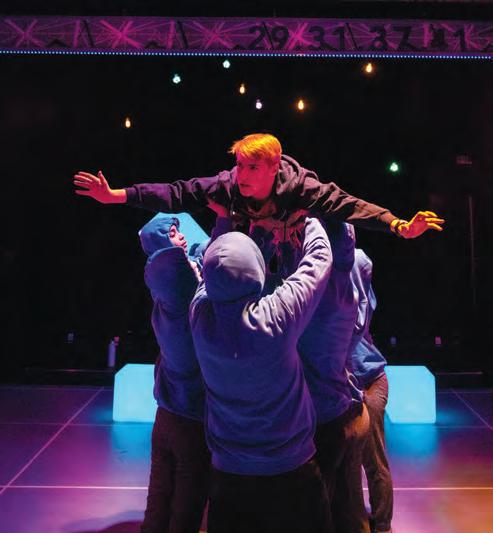
“This show is like no other I have had the privilege to work on. It is an episodic, and at times abstract play, covering many locations in almost sixty scenes. The play’s structure encouraged us to look at different ways we could use actors to create a variety of things from a simple light switch, to waves gently lapping the shore. It is a fast moving, and visceral piece that demanded we think outside the box in terms of staging, and I have loved every moment of figuring out how to create numerous environments with just actors on stage—no scenery, and very few props to help.”
—Theater Director Catriona Hynds
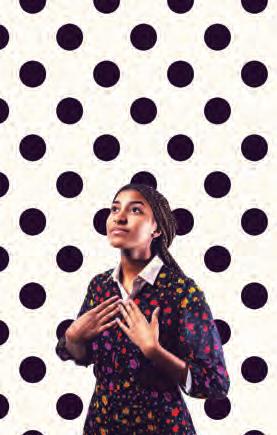

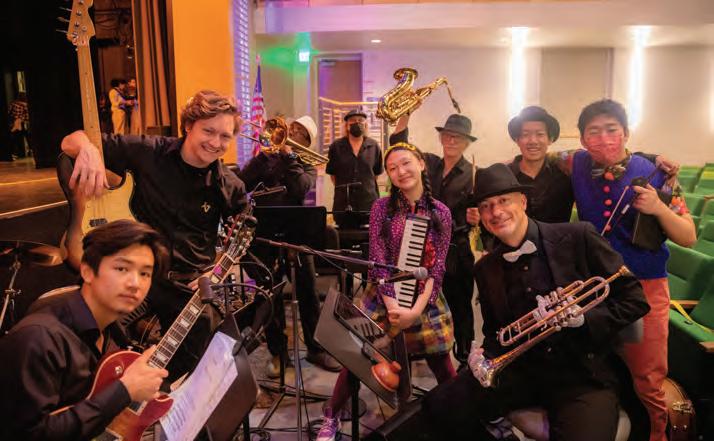
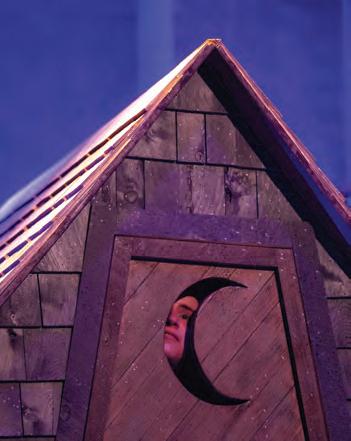
Deerfield’s spring musical production of Twelfth Night was a hit and the best kind of grand finale to end the school year. The show was a rousing, contemporary musical adaptation of Shakespeare’s classic romantic comedy about mistaken identity and self-discovery. Featuring an original jazz-funk score by Shaina Taub, this soulful shake-up of the classic play was a collaboration of the Deerfield Academy theater, vocal, dance, and orchestra programs.
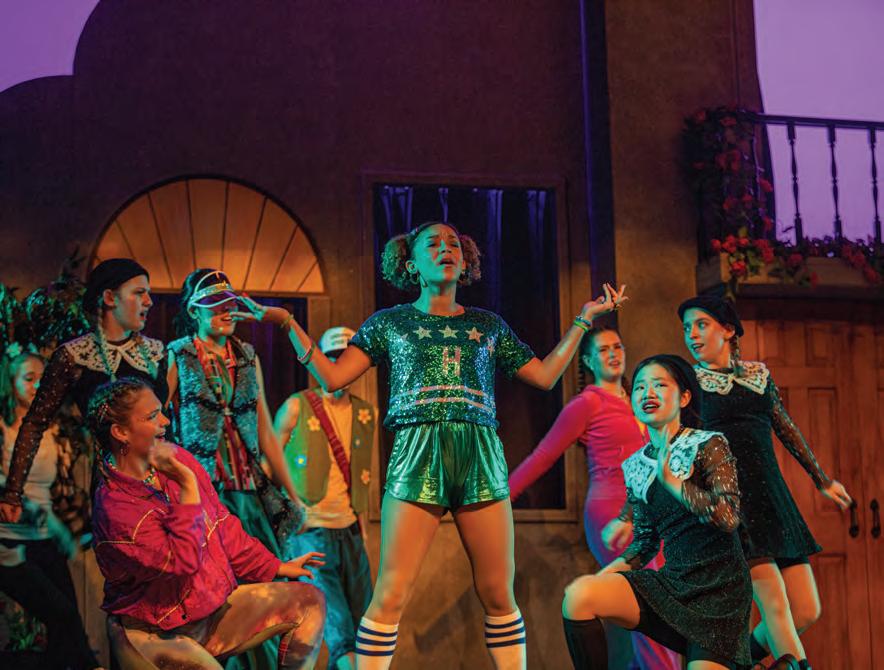
At press time, the Fall 2022 play, Radium Girls, had just wrapped. Visit Biggreen.photos for shots from the performances.

After a disjointed (but successful) year of competition in 2020 - 21 due to the pandemic, Deerfield teams came roaring back in 2021 - 22! Here, we salute the girls and boys who set records and won championships over the past two years. Visit Deerfield.edu/athletics for the current year’s schedules, scores, and more.
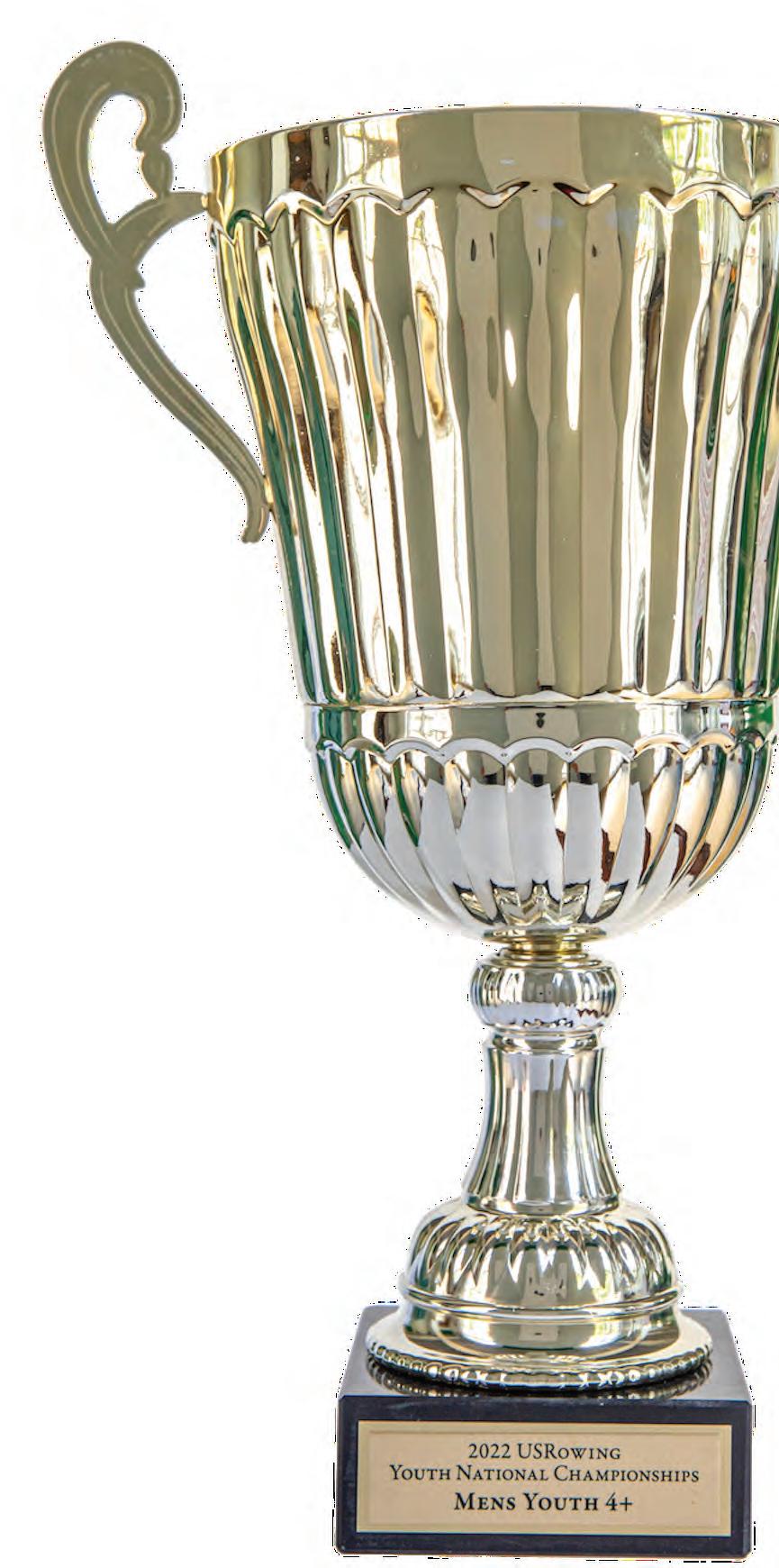
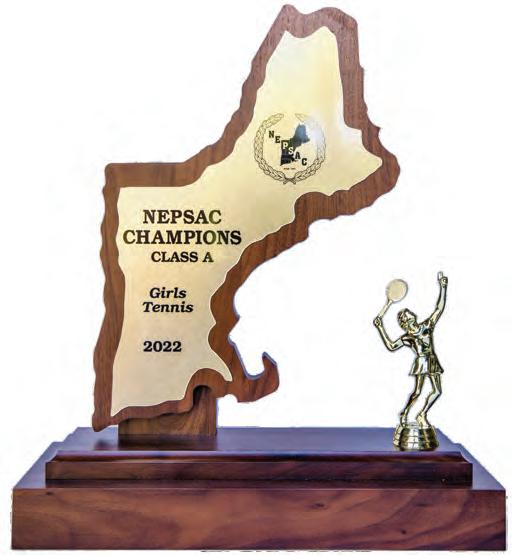
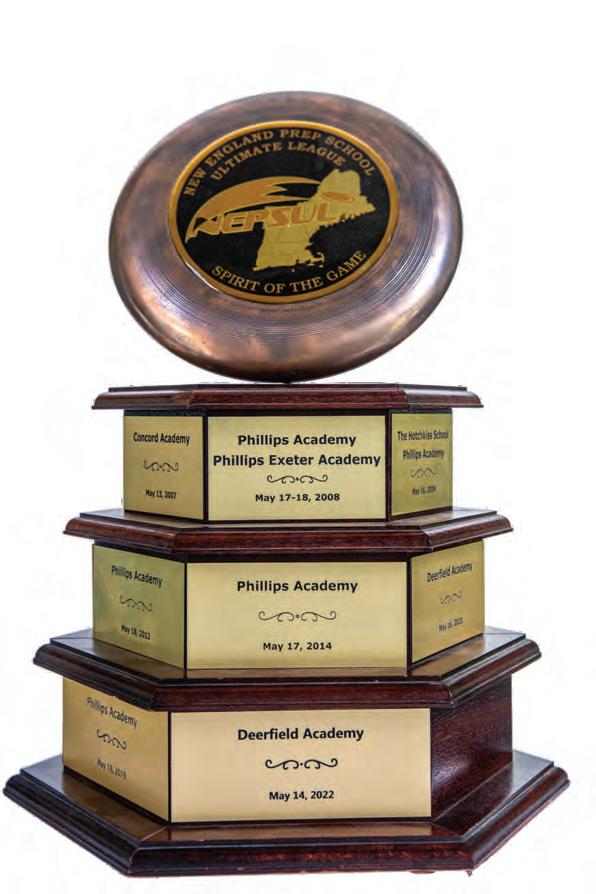
On Sunday, June 12, the Big Green boys and girls rowing teams completed their quests at the 2022 US Rowing Youth National Championship held at Nathan Benderson Park in Sarasota, FL. The boys boat crossed the finish line in first place of the men’s youth 4+ in the Final A to be crowned National Champions. In the women’s youth 4+ Final A, the Deerfield girls crew team rowed to a fifth place national rank.
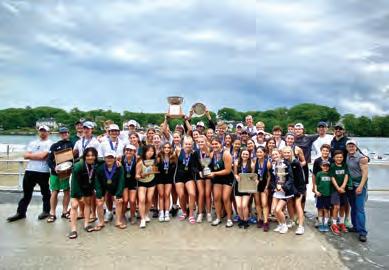
In a thrilling finish, the boys boat surged ahead in the final meters of the race to over take second-place finisher Greenwich for the victory with a winning time of 6:24.415.
In the closely contested women’s youth 4+ final race, the Big Green crew crossed the finish line with a time of 7:21.252 to claim the title of the fifth fastest boat in the country in their division.
On Sunday, May 22, the girls varsity tennis team captured the Class A New England Preparatory Championship for the first time in program history!

2021 Silipo Bowl Champions! Deerfield beat Brunswick 35-28 to claim their second straight NEPSAC Mike Silipo Bowl trophy. It was an exciting, back and forth game for the entire 48 minutes. The victory secured back-to-back NEPSAC Class A Mike Silipo Bowl Champions for the Big Green with a 9-1 overall record this season. In 2019, the Big Green defeated Milton Academy (26-23) to capture the Mike Silipo Bowl Champions trophy and posted an 8-2 season record. It was a great day for football and an even better ending for the 2021 Deerfield Football Team!
Deerfield volleyball set a number of program records last year: most wins in the regular season (16); most wins overall (19); first time advancing to the league finals; and first time as New England Class A champions.
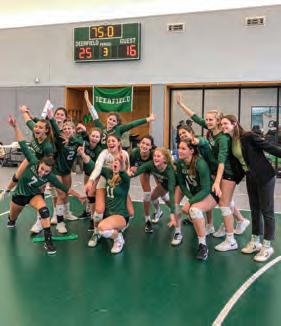
Deerfield ski team competed in the New England Class A Alpine Ski Championships at Shawnee Peak, ME. The championship included a slalom and giant slalom competition races. At the conclusion of the races, the Big Green boys team finished in second place and girls team finished in eight place overall. In the boys slalom race, Tait Kline ’22 finished in third place, Alexander Grosse’22 earned a fourth place finish and Johnny Monty ’24 raced to a seventh place finish. The girls slalom race included finishes from Jing Wang ’24 in 17th place and Josephine Cramer ’24 in 21st. In the girls giant slalom, Jing Wang finished in 25th place and Maddy Slater ’22 was in the 25th spot. The top-10 Deerfield finishers in the boys giant slalom race included Alexander Grosse in sixth place.! //
On Saturday, May 21, 2022 the boys track and field team captured the New England Division I Track & Field championship, hosted at St. Paul’s. The team scored a high of 130 points for the win, the highest in the league since 2010.
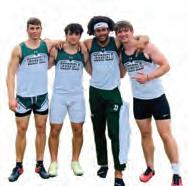
Elic Ayomanor ’22 won MVP of the meet and set new league (and school) records of 10.76 seconds in the 100 Meter and 21.66 seconds in the 200 Meters, while the 4×100 Meter Relay team including; Nick Peltekian, Alex Haight, Christian Reavis and Elic lowered their school record from 42.64 to 42.36 seconds. Wedner Cadet ’22 won the high jump competition. Elic added to his meet accomplishments by winning the long jump competition. In the shot put event, Joe Metzger ’22 captured the title. Teammate Chigozie Oge-Evans finished in third in the event shot put and also captured the silver medal in the discus throw. Nick Peltekian ’22 earned a fourth place finish in the 100 meter. Alex Haight ’22 finished with a time 22.62 seconds in the 200 meter to earn fourth place finish overall and earned the silver medal in the 400 meter. Quinn Hampson ’22 captured fifth place in the 800 meter and the silver medal in the 1500 meter with a time of 4:04.00. In the hurdles, Barack Mwesigwa ’24 earned a fourth place finish in the 300 meter hurdles between teammate Chandler Dicks ’23, who earned a bronze place finish in the event. Chandler earned the silver medal in the high jump, as well. Furthermore, Chandler earned the bronze in the long jump. The 4×400 meter relay team of Wedner Cadet, Quinn Hampson, Christian Reavis, and Alex Haight finished in fourth place. Stone Anderson ’23 threw the javelin 141-08 to capture a fifth place finish.
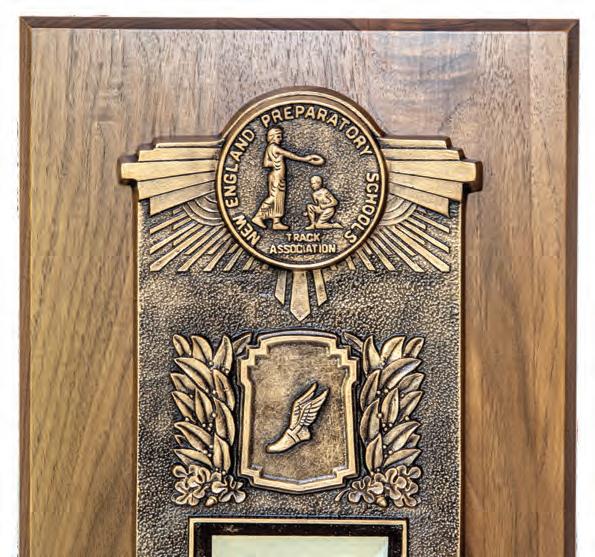
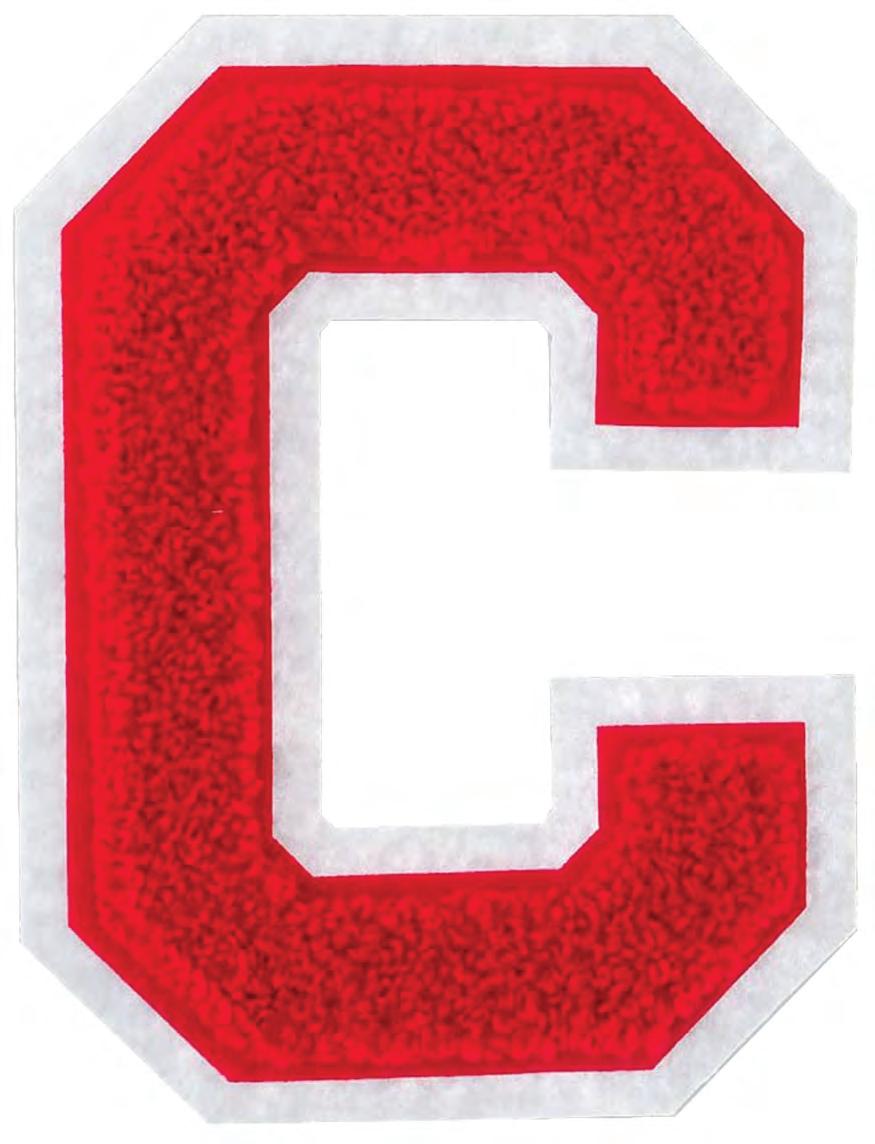
On a beautiful Sunday mOrning at the end Of may, juSt Over 200 SeniOrS walked acrOSS the Stage, under the big tent, tO cOllect their deerfield diplOmaS— their futureS aS bright aS the Sun.
This fall, the Class of 2022 headed off to nearly 100 different colleges/universities; however, their college process was unlike any that had come before them. Covid’s impact over the past two and a half years has been felt across the world on micro and macro levels—the college admissions process also proved unprotected from Covid’s force. Many of these seniors were unable to visit colleges in person, they had to navigate through ever-changing test-optional policies and changes in NCAA recruiting methods, and were often limited in their extracurricular pursuits. Not to mention (which I will!) dizzyingly dropping admit rates.
In the spring of 2020, Covid’s impact on our school’s daily life, and the college process began to unfold very quickly. Students left for Spring Break not knowing they wouldn’t be back to complete the year in person. Deerfield finished that Spring Term teaching remotely with pass/fail grades. College Advising moved our spring college fair online, hosting small groups of colleges in separate Zoom meetings over several weeks. The College Board and the ACT canceled test administrations, and college admission offices began to immediately rethink how they would be making their application decisions. Throughout this unprecedented time, we were in constant contact with our college admissions colleagues. We received assurances that they understood the challenges the pandemic posed for students and families and that they stood ready to be flexible and understanding about the ways
Admit Rates from 2022 Examples of admit rates from this current cycle: School 2022 AcceptA nce R Ate hAR vAR d Unive RS ity
M ASSA ch US ett S i n S tit U te of t echnology
le Unive RS ity
B R own Unive RS ity
S h opkin S Unive RS ity
dU ke Unive RS ity
vA nde RB ilt Unive RS ity 6% d AR t M o U th c ollege
A M he RS t c ollege 7% c ol B y c ollege 7% c o R nell Unive RS ity 7% n o R the A S te R n Unive RS ity 7% n o R thwe S te R n Unive RS ity 7% SwAR th M o R e c ollege 7% B AR n AR d c ollege 8% Rice Unive RS ity 9% tU ft S Unive RS ity 9% Bowdoin c ollege 9% w illi AMS c ollege 9% tU l A ne Unive RS ity 10% eM o R y Unive RS ity 11 % Unive RS ity of So U the R n cA lifo R ni A 12% g eo R getown Unive RS ity 12% n ew y o R k Unive RS ity 12.2% Unive RS ity of n ot R e dAM e 13% w elle S ley c ollege 13% Bo S ton Unive RS ity 1 4%
that this extraordinary moment was changing normal business practices. We re-wrote our school profile reflecting and explaining our new schedule and grading changes, and re-wrote it again and again, navigating and adjusting as the pandemic required. Colleges were very supportive as Deerfield and high schools across the country put safety measures in place. For example, as Colgate University stated, “As many encounter disruptions in their learning environments, Colgate is committed to the evaluation of students’ academic achievement within the context of what their schools offer. We trust that our school partners have implemented policies in the best interest of their students, and we remain supportive and flexible to ensure that students are not negatively impacted by circumstances beyond their control.”
As the Class of 2022 began their junior year, Deerfield moved to a new academic schedule and implemented many Covid protocols to limit movement and “de-densify” campus. Colleges moved to solely offering virtual programming for their information sessions and tours. Positively, we saw colleges offer more touch points for students to learn about their institutions. Before Covid, it would have been rare while visiting a college to witness a faculty panel speaking about the merits of their school. But now, online offerings like this became more common. Between the Fall and Winter Terms of 2020-2021, Deerfield created a “D-Term”—two dedicated virtual weeks of learning in December. During D-Term, seniors concentrated on finishing up their college applications, editing their essays, and meeting with their college advisors over Zoom. The juniors began the self-exploration process, a critical part of the college process, by engaging in such activities as creating a resume, responding to short reflective essay prompts, and reviewing their student questionnaire with their college advisor.
Perhaps the biggest imprint on the college process due to Covid has been the changes to standardized testing policies. As colleges examined this new landscape—aware of how difficult, to nearly impossible, it was to even find, let alone take an ACT or SAT safely—most schools decided to offer test-optional policies for their applicants. How drastically college applicant pools changed was surprising, to say the least. First, only about half of all college applications included test scores. Second, the number of applications submitted skyrocketed. Historically, annual application increases of 10 percent would have felt quite significant, but now—particularly at the most selective institutions—increases of 25-35 percent seemed to become the norm, with a few institutions hitting increases of 65 percent or more (Colgate—103 percent, MIT 66 percent, Macalester 42 percent, Univ of Georgia 39 percent, Boston College 36 percent). With the persistence of these test-optional policies, admit rates have continued to fall across
From experience, I would estimate that since 2018, the number of colleges with admit rates below 10 percent has tripled. This massive jump in application numbers has also affected how schools manage their early decision (ED) applications. The trend has been moving toward colleges filling more and more of their first-year class with ED applications. In comparison to a few years ago, ED percentages of 40 percent would have seemed high, now institutions such as Bates, Claremont McKenna, Middlebury, Swarthmore, and Northwestern are close to filling 60 percent, if not more, of their first-year class with ED apps. Perhaps the most unanticipated case we observed this last cycle was at Tulane. After over-enrolling in 2020-2021, this year they received 42,000 applications for approximately 1,800 spots. It was originally rumored that Tulane did not admit anyone in the regular application round—that their class would be entirely composed of early decision, early action, and waitlist admits! An article was recently published in Inside Higher Ed clarifying that Tulane admitted 106 students via regular decision, not zero . . . but pretty close. This focus on filling classes out in the early rounds (in particular, early decision) leads to exceptionally competitive regular decision rounds and highlights the importance of advising students on the risks and benefits of their early round choices.
With all the changes Covid required our college advisors and students to navigate, much of the application process remains the same. Students still need to research colleges and write essays. Colleges still need to recruit athletes and read applications. Over the last 30 years in my work in college admissions and college advising, what stands out for me is twofold. First off, as schools become increasingly more competitive, the guidance and support that parents, faculty, and college advisors provide become increasingly valuable. This is not the same admissions landscape it was when we applied to school 30 years ago, and it’s not the same as it was three years ago. Secondly, students who engage in the process, and not only in the result, are more likely to be happy with their final choice. Exploring passions and preferences, identifying goals, discovering more and more schools that are a good fit for students’ academic and extracurricular interests, and managing expectations are central to our college advising process. Yes, many of our students get into one of their “top choice” colleges, and still the more support we can give our young adults as they discover themselves, their reasons and goals for college, the more informed and well-rounded their college choice will be.
Many of you have heard me read this passage from our College Advising Handbook (right), and I will share it again with you here. With college admission policies being updated at a record pace and admit rates continually dropping, this is a good reminder about what the college process can be. //
applying tO cOllege iS a prOceSS Of diScOvery, Of pOndering whO yOu are and whO yOu want tO becOme, and Of cOntemplating what rOle yOu want tO play in the larger wOrld. the cOllege Search iS, in eSSence, an extended reSearch prOject, which will require StudentS tO lOOk within themSelveS fOr many Of the anSwerS. StudentS will learn tO identify and aSSeSS themSelveS, tO Set priOritieS, and tO make majOr deciSiOnS. hOw a Student navigateS thrOugh thiS prOceSS iS juSt aS impOrtant aS where they end up.
The idea for SCIFF came about when Lisa wanted to submit one of her films to her hometown festival and found that Santa Clarita—also known as Hollywood of the North—did not have a film festival.
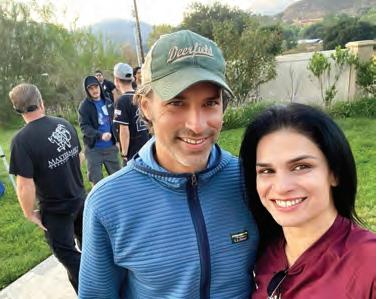


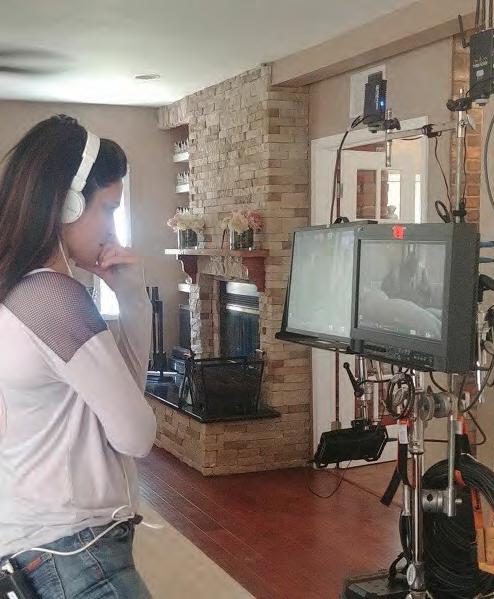
“Don’t fill her head with dreams she can’t reach,” Lisa DeSouza’s father cautioned her high-school counselor. Lisa was about to age out of the international school in Saudi Arabia where her family, European ex-pats, were posted for her father’s airline job. The concern was more financial than anything; the schools that her counselor dangled in front of Lisa seemed out of reach to Mr. DeSouza. Plus, her mother didn’t want to send her only child, a spirited and rebellious daughter, to a faraway and unfamiliar land. Despite those minor details, Lisa found herself plucked away from a home economics exercise in pie-baking and inserted into a line of well-dressed, polished students waiting to interview with a Deerfield Academy representative.
“Why do you think Deerfield is right for me?” Lisa quipped, clad in ripped jeans and high-top sneakers, hair disheveled and dusty with baking flour—her response to the question why she thought she might be right for Deerfield. And so, it was a surprise when her father hung up the phone and revealed that Lisa had not only been accepted to Deerfield but given a substantial scholarship. “There are moments in your life where you know you can’t go back. You know that your life has changed forever,” says Lisa, remembering how it hit her, while alone in her dorm room on her first day at Deerfield, that the life she knew had suddenly fallen away. “When I look back on my life, there are these defining pillars, and Deerfield was one.”
After graduating from Columbia University, Lisa enrolled at the American Academy of Dramatic Arts and The School for Film and Television. She found success in the creative world—acting, writing, and directing—and in the tech world. She’s gifted with strong leftand right-brain abilities, making her among those unicorn creatives who can also execute a business plan and manage a budget. But as unstoppable as she seems, there was a period when Lisa felt completely kneecapped by the death of her fiancé; there was a year when she couldn’t work and days when she could not get out of bed. How she got through that dark period, she doesn’t quite know, but she began by putting one foot in front of the other and starting anew. Part of the healing process led her to Santa Clarita, where she bought a ranch and some horses, figuring that a quiet life in the country would be the antidote. With early mornings tending to horses, and full days working with clients followed by back-to-back creative projects, it is anything but quiet.
Ask Lisa about SCIFF (Santa Clarita International Film Festival), and she lights up. Lisa, who works as a consultant in the tech industry by day, is truly a creative powerhouse. “I’m grateful for the day job, but my heart and soul are fed by the creativity that comes from writing and directing, and now this festival. That is what feeds my soul. That is my purpose— my magnum opus,” she declares, delving into the details of her current pursuits. The idea for SCIFF came about when Lisa wanted to submit one of her films to her hometown festival and found that Santa Clarita—also known as Hollywood of the North—did not have a film festival. Not dissuaded, Lisa searched for domain names, securing all suitable options for a film festival she would launch in 2021. The first year was a smashing success with over 1,300 attendees during a pandemic, and the second festival, to be held over December 8 - 11, 2022, is creating much buzz. Next year, Lisa’s goal is to also launch Left of Center, a non-profit incubator for unknown women filmmakers living in Santa Clarita. It will raise funds and partner these filmmakers with mentors in the industry, running them through their first project.
Lisa is a high-octane person tending to many fires and on a quest to live a life of meaning and purpose as she climbs what she refers to as her “second mountain”—life’s second act where having satisfied the drive of the ego in earlier years, one can put one’s energy into meaningful contributions outside of oneself. Any criticism that she may have abandoned a purely artistic life, muddying the creative waters with a tech career, is too single-minded and short-sighted for Lisa, who has been able to draw from her business experience and apply it to creative project execution. Her advice to aspiring creatives: “Never be afraid to take a circuitous route. Never be afraid to pivot, reinvent yourself, step out of your comfort zone, and learn as much as possible. Then see how you can use what you’ve learned and apply it to your passion. When a door opens, and it’s an opportunity, walk through it. What have you got to lose?” //
When a door opens, and it’s an opportunity, walk through it. What have you got to lose?”
Deerfield’s Medical Services team had set up Covid-19 symptom screening and testing stations in the Morsman Tennis Pavilion. A drop-off schedule had been carefully coordinated for students to move in dorm-by-dorm and floor-by-floor, so as to minimize contact. A quarantine period of ten days had been put in place for the entire campus, no matter a student’s point of origin. Faculty had been trained to teach online until quarantine was over. Dining services had devised a complex system to deliver 2,500 meals daily to all dormitories, accommodating over 200 student allergies and preferences. Facilities had created a plan to deal with an anticipated rise in trash due to all the individually wrapped meals.
Assistant Head of School for Student Life Amie Creagh remembers leaving Head of School Dr. John Austin’s office that September morning to check on the symptom screening stations. “I joked that I was headed to the bathroom to throw up, and John called after me, ‘leave the door open for me!’ It felt really high stakes. We had spent months preparing for this, and then we just had to cross our fingers and hope all that planning had worked out.”
That day was the culmination of a tremendous amount of work on the part of Dr. Austin’s leadership team and truly every Deerfield employee to ensure that students could return to school safely. It was an audacious plan, executed at the height of the Covid-19 pandemic with no vaccines in sight. Few other schools were bringing back the entire student body in the same week, and almost none had the entire faculty committed to teach in person. At that moment, no one was quite sure how it would all work out.

The decision to open in the fall for in-person learning dated back to March 2020, and a phone call between Dr. Austin and then Board President Brian Simmons. The two spoke daily, often as early as 5:00 am, especially during those disorienting days at the start of the pandemic. Dr. Austin had made the unprecedented decision to delay the start of Spring Term by two weeks. Now the campus was quiet; students were in lockdown in their homes, scattered across the country and around the world; and faculty were sequestered in their homes, teaching online over Zoom, a platform never before used—or even heard of—at Deerfield.
Dr. Austin and Simmons discussed the alarming rise in Covid cases in the US. They knew the two-week delay might stretch through the entire term—and even into the fall. Dr. Austin had officially been Head of School for only eight months, but he was clear on his mission: to lead an institution that had always been firmly student-centered. “I wanted to get kids back on campus, keep them on campus, and do it as safely as we could,” he says, even as he acknowledged that there might be pressure internally and externally to not reopen in the fall. So, when Simmons asked for his thoughts on the Fall Term, Austin replied: “I want to open the school,” and Simmons immediately responded, “Good, so do I.” From that point on, “there was never a phone call or a Board meeting where we weren’t working toward that goal,” he says.
For Deerfield’s staff and faculty, that seemingly straightforward directive to “open the school” was the starting gun on a logistically challenging, emotionally taxing, and physically exhausting race toward opening day—with no map. “It was daunting, but it was very clarifying,” says then Assistant Head of School for Academic Affairs Dr. Ivory Hills. “Once the Head of School gives you a clear mission, everything is dedicated toward trying to execute and make that happen.”
Right // Mr. Davis teaching Economics on his front lawn? Bingo. Classes were held outdoors while the weather was agreeable.
FOR DEERFIELD’S STAFF AND FACULTY, THAT SEEMINGLY STRAIGHTFORWARD DIRECTIVE TO “OPEN THE SCHOOL” WAS THE STARTING GUN ON A LOGISTICALLY CHALLENGING, EMOTIONALLY TAXING, AND PHYSICALLY EXHAUSTING RACE TOWARD OPENING DAY—WITH NO MAP.
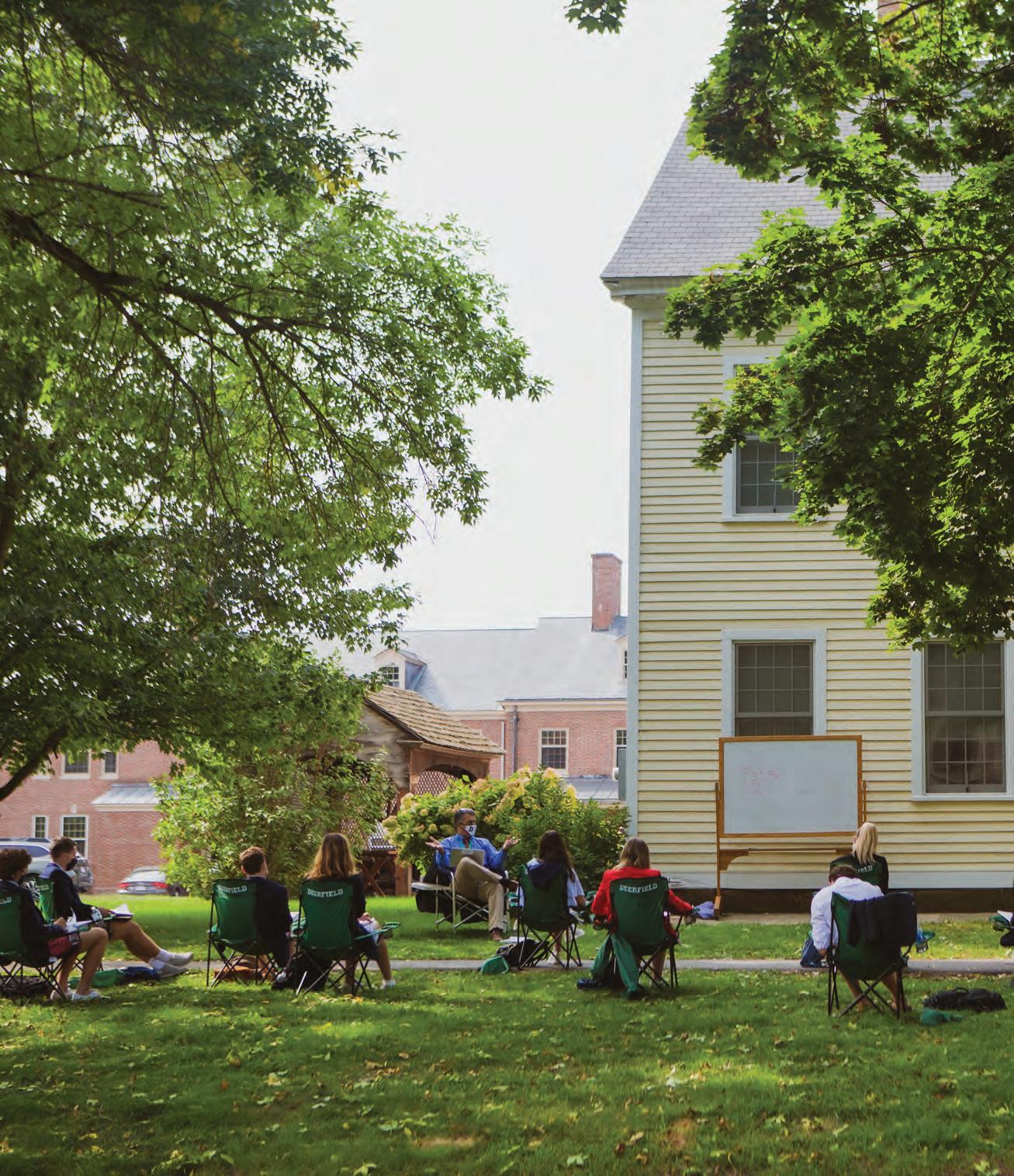
Number of HEPA filters placed around campus:
If Deerfield was going to reopen for in-person learning, identifying a system for testing became a number one priority. In those early days, however, tests for Covid-19 were nearly impossible to find.
Number of 6’ PVC pipes made to measure physical distancing:
By starting the search early and relying on the advice of Trustee Gregory Fleming, Deerfield partnered with Gingko Bioworks, a Boston biomedical testing company. Fleming also helped to facilitate contact with Pinnacle Health, a medical consulting group affiliated with Johns Hopkins, which gave the school access to the advice of leading infectious disease doctors. Trustee Joseph Dowling, who until 2021 led Brown University’s endowment, shared with Dr. Austin key information regarding the university’s approach to managing through Covid, and Dr. Austin himself found the final key consultant when he read an article in the New York Times that mentioned that the American Camps Association was working with a company called “EH&E” (Environmental Health and Engineering) to develop a playbook for opening camps that summer. He cold-called EH&E and arranged a meeting.
Over many, many hours, these advisors helped Dr. Austin and his leadership team parse the rapidly evolving information around Covid-19 and build a blueprint for reopening Deerfield that followed the science but also maximized the student experience.
As a result of the “war room” approach, EH&E reported that Deerfield was asking questions about Covid weeks before anyone else; that fact would make all the difference. Additionally, Dr. Austin and his leadership team knew they had the full support of the Board, and especially Trustees Alice Ruth and Leila Govi ’93 (currently Board president). “Alice spearheaded the financial planning,” says Simmons, “and she brought great insights to John and me from her role at Dartmouth. Leila oversaw analysis of the Academy’s endowment and all of the work to understand the investment outlook and liquidity available to implement our plan. If I had a war room on the Board, it was Alice, Leila, and Greg,” he adds.
Number of spaces on campus that do not meet standards* for COVID 19 air filtration and ventilation:

From the beginning, Simmons had advised Dr. Austin to create a “war room” to manage the pandemic. Initially, this team included the heads of key administrative departments on campus, such as Human Resources, Communications, Information Technology Services, Physical Plant, and, of course, Medical and Health Services. In the early days of the pandemic, the “Covid Task Force” met at least on a weekly basis. In later days, the team became more streamlined as Dr. Austin pulled together Creagh, Hills, Dean of Faculty John Taylor, and recently retired CFO and Associate Head of School for Operations Keith Finan. “Between them, they touched every person in the school,” Dr. Austin says. “The broader team really allowed us to shape a response; the smaller team freed others to execute that response while being forward-thinking and flexible.”
Number of MERV 13 air filters installed to enhance air filtration on campus:
The “Eight o’clock Crew,” as the core team began jokingly calling themselves during their daily morning meetings, made strategic decisions about a dizzying number of issues. They then would turn to Director of Educational Initiatives David Miller, who was named Assistant to the Head of School for Special Projects during the pandemic, to work with the consultants to figure out the details and create protocols. Miller’s main responsibility was translating EH&E’s scientific advice on Covid to every aspect of Deerfield’s program, including academics, residential life, and cocurriculars—everything from how far apart teachers needed to stand from students in the classroom to how families would be able to safely get their students to campus in the first place.
By mid-May, Deerfield had a solid blueprint for opening in the fall. One of Dr. Austin’s first directions to his staff had been to prioritize clear and frequent communication. “There was no such thing as overcommunication during the pandemic, and I honestly don’t know what we would have done if not for the ability to reach families, students, and alumni with video and by other digital means,” says Director of Communications Jessica “Jess” Day. “We were deliberate and careful with our messages, though,” she adds. Beginning with a video announcement by Dr. Austin when the decision was made to move to remote learning for the balance of the 2020 school year, to weekly virtual versions of School Meeting called “The Friday Common Room,” to detailed weekly newsletters for families, to Zoom “fireside chats” for alumni, “town halls” and forums for families, and all-employee meetings, to communicating that first detailed plan for bringing students back to campus, Day and the “Comm team” churned out an unprecedented amount of information at an equally unprecedented rate for multiple audiences.
“The goal was reassuring the community that the Academy was making informed and
thoughtful decisions,” adds Finan. Sharing with the community the announcement that the school would re-open in the fall of 2020, however, “ was pretty nerve wracking,” says Dr. Austin. “I had quite a few sleepless nights.”
He may have been nervous, but this wasn’t Dr. Austin’s first crisis. For the previous nine years, he had served as Head of School at King’s Academy in Jordan. King’s was a relatively young school, and during his time as Head, the Middle East suffered a series of cascading challenges: the Arab Spring
of the early 2010s; the Syrian civil war and ensuing refugee crisis; and the emergence of ISIS. “That experience was good preparation for me to think through a moment like the pandemic. They aren’t comparable in any way, but they require the same flexibility and mindset. You have to move more quickly, and you have to be comfortable with change and rethinking assumptions.”
John Austin and the Board’s early and firm commitment to open Deerfield in the fall provided clarity to staff, parents, and students, and it put the Academy out
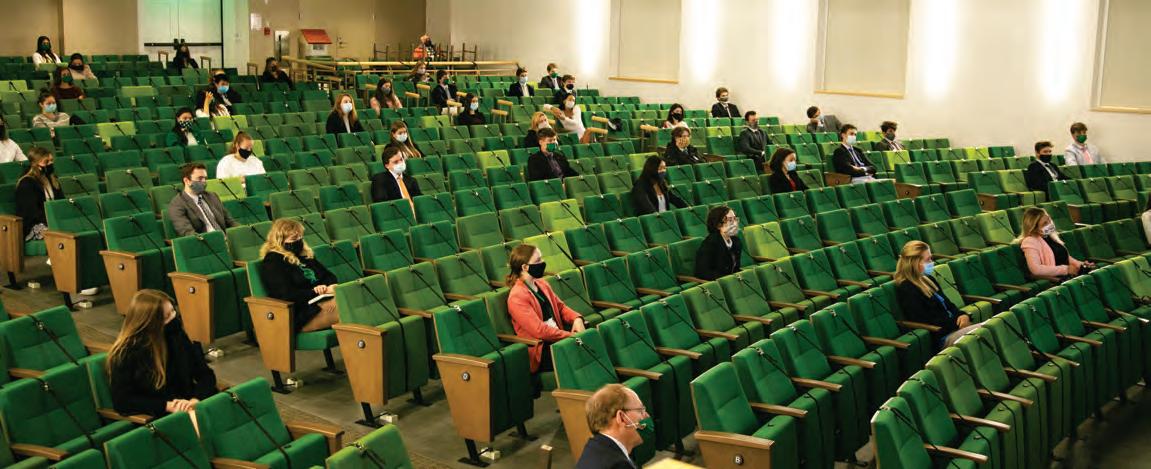
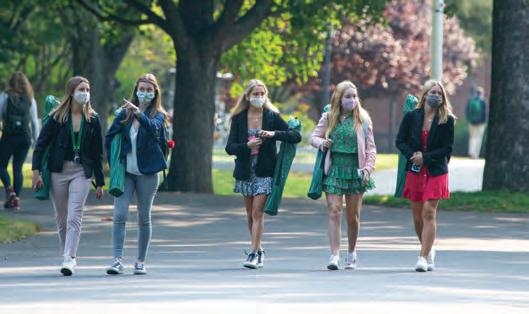
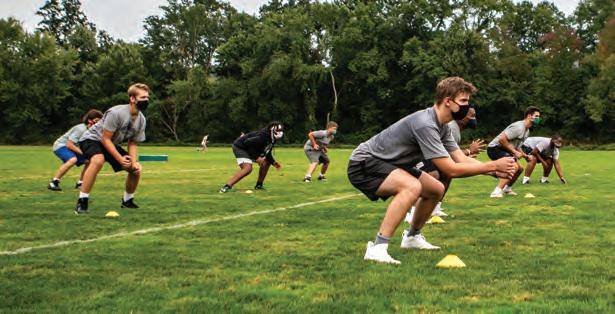
in front of its peers; Deerfield was first to share a concrete plan for reopening— a strategic and preemptive move made in part to put “a stake in the ground” when so much was in flux. Miller thinks that what set Deerfield apart was “starting with the premise of, ‘how are we going to live out our mission and keep the school open in the context of protecting community health?’

When you change the mindset from ‘can we do this?’ to ‘how can we do this?’ you just start moving forward a lot faster.”
And move fast they did.
Number of new classrooms created:
Number of day students who moved to campus:

Number of new dorm rooms created the summer of 2020:
If Deerfield was to hold in-person classes, the task fell to Dr. Ivory Hills to rethink the academic schedule to ensure that learning would be productive, but above all, safe. Starting in the spring of 2020, he and Dr. Austin consulted educators and organizations around the world, and eventually settled on an academic schedule where students would take two courses for each of Deerfield’s three terms. Instead of attending five or six 45-minute classes and having contact with 80-100 classmates each day, students would attend just two 90-minute classes and limit their number of classroom contacts to 20-25 students per day. And if the campus had to shut down again, students would at least have completed a few courses that year.
Which isn’t to say that Dr. Austin and Hills weren’t sensitive to the fact that they were changing the academic schedule for the second time that year, the first being when classes moved online in the spring. In order to support the faculty in teaching longer class periods and squeezing a year-long curriculum into one term, they provided multiple resources for professional development.
John Taylor also made an effort to sit down with every faculty member to address the emotional component of returning to in-person teaching. “We paid close attention to anyone who had a serious health concern or a family member they were worried about, getting a sense of what they felt comfortable doing and not doing,” he says. In the end, unlike some peer schools, Deerfield’s faculty overwhelmingly leaned into the decision to bring students back to
campus. “That’s the faculty culture and ethos of dedication [at Deerfield],” says Taylor, “so, when you have a huge challenge like Covid, everyone just jumps on board and rows in the same direction.”
The same must be said of Deerfield’s staff, especially during the summer of 2020. In order to create spaces for in-person teaching, Director of Operations Jeff Galli and his team had to remove every class-size table and every two-person desk from Deerfield’s classrooms, which are typically setup to promote connection and collaboration, and replace them with single desks to promote distancing. To accommodate more classes of fewer students, the Physical Plant team created nine new classrooms throughout campus and also set up Deerfield’s huge Commencement and Reunions tent—with flooring—and another six 40x40 tents so that faculty could hold classes outside. They adjusted the Academy’s mechanical systems to improve air exchange rates in every single room. In the older buildings that did not have mechanical ventilation systems, they installed HEPA filters.
The task fell to Director of Information Technology Services Kim Butz and her team to outfit classrooms with technology, including 80 robotic swivel cameras to be used when students or faculty had to attend class remotely, and rewrite the academic scheduling software to accommodate the new schedule.
Students could no longer live together in doubles or triples, so Galli and his team created 51 single dorm rooms, which they built and outfitted with furniture in existing common rooms throughout campus. Other smaller—but not insignificant— projects included installing hand sanitizing dispensers throughout campus, converting sinks to touchless faucets, and installing plexiglass dividers to protect staff who had to work in person, especially in the Dining Hall.
It was an incredible stroke of luck that the new D.S. Chen Health and Wellness Center had opened in the fall of 2019. Director of Medical Services Dr. Bryant “Bear” Benson knew, however, that the 16 beds in “the Chen” might not be enough to isolate students in the event of positive Covid cases. For Benson, a key decision was not to strive for “zero Covid.” “Early on we talked about ‘bubbling,’” he says, “but I said, it’s less about creating a bubble on campus than a colander. There will always be holes; we just have to be able to contain it.” The old health center had been
“EARLY ON WE TALKED ABOUT ‘BUBBLING...IT WAS LESS ABOUT CREATING A BUBBLE ON CAMPUS THAN A COLANDER. THERE WILL ALWAYS BE HOLES; WE JUST HAVE TO BE ABLE TO CONTAIN IT.”
—Director of Medical Services Dr. Bryant “Bear” Benson
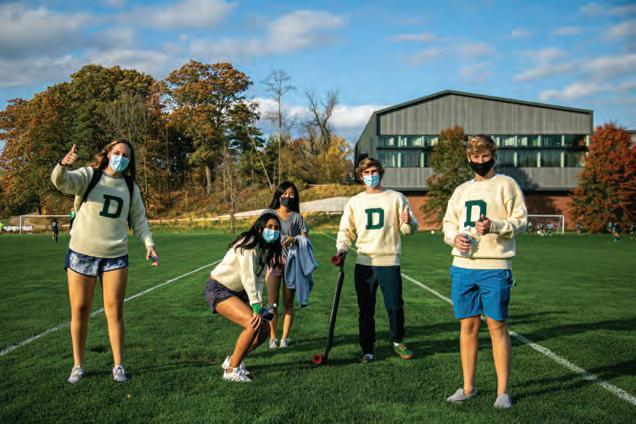
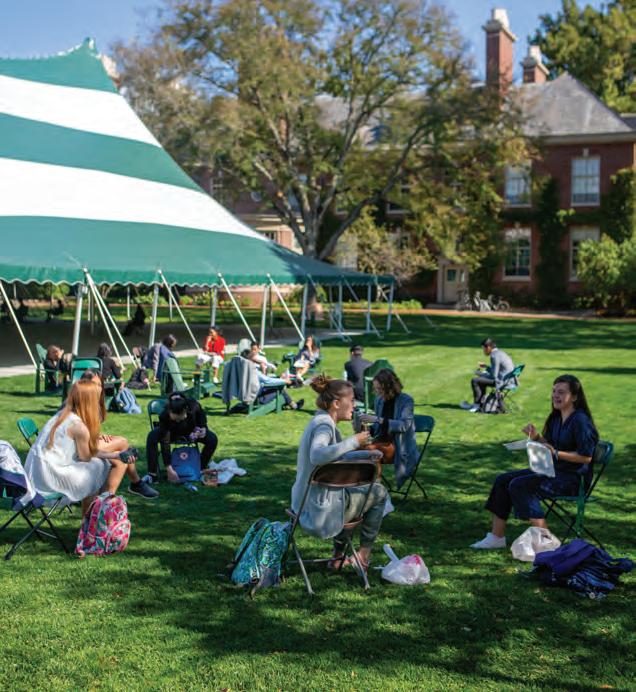
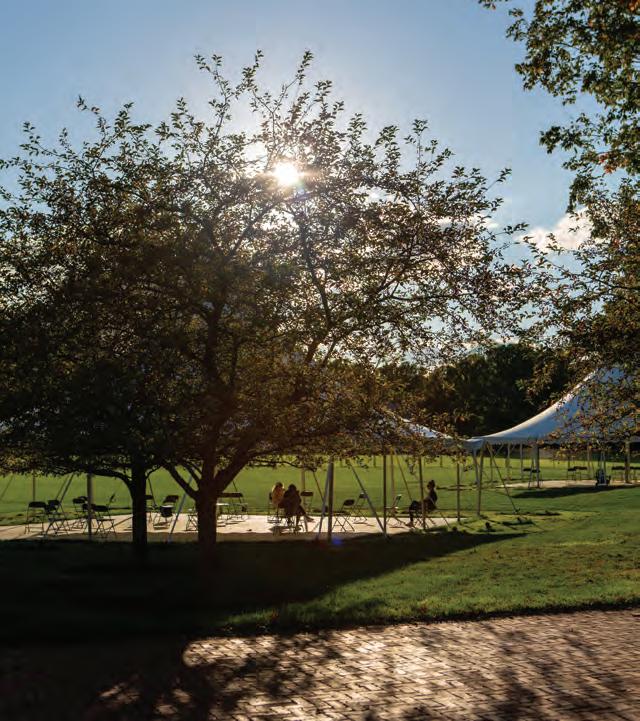
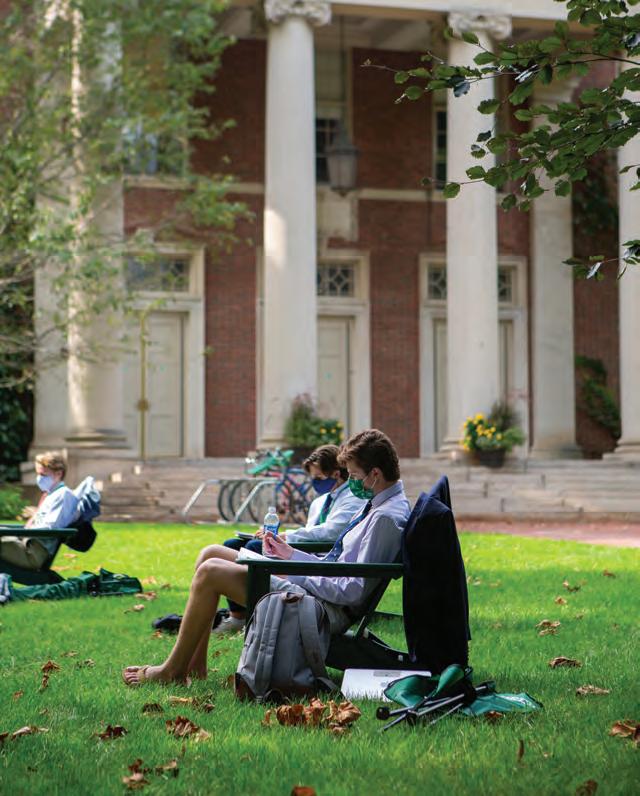
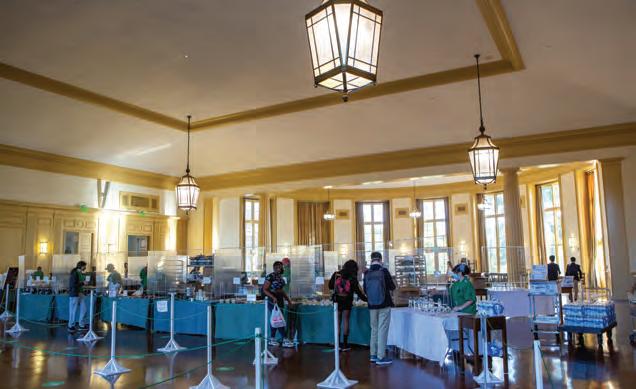
slated for demolition but, instead, Physical Plant quickly pivoted and oversaw a renovation to create 25 individual rooms for quarantining, new bathrooms, a testing center, and a ten-bed, seven-room isolation unit.
Strategic decisions like accepting that Covid-19 would eventually be on campus put Deerfield at an advantage, as did the hard work by staff over the summer. “One of the unsung heroes of Covid is Jeff Galli,” says John Taylor. “Jeff took care of an enormous amount of details.”
Galli admits that the construction blitz that summer was tough, but that everyone rose to the challenge. “They said they’d do whatever it took.”
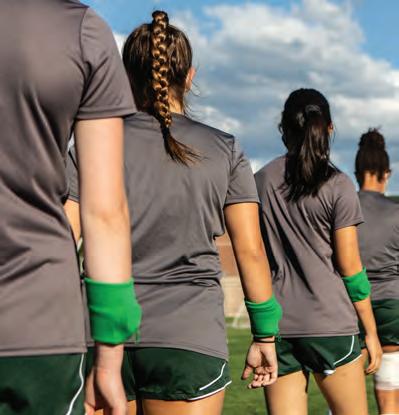

It may have been nerve-wracking, unprecedented, and strange, but the return to school in 2020 went off without a hitch, the ten-day quarantine period passed without incident, and students settled in for the 2020-21 school year—albeit a very different one.
Much about the student experience, the heart of Deerfield’s mission, had changed: masks and social distancing were mandated, the entire campus—students and employees —was tested for Covid twice a week, interscholastic sports had been canceled, students were not permitted off campus, and meals were “grab and go.” All over campus, signs reminded students of “The Four Ds of Covid Safety: De-densify, Distance, Disinfect, and Don your mask.” These were supported by a series of training videos and materials created by faculty member Heather Brown and the team in the Communications Office; everything was embedded on “Healthy Deerfield” webpages for easy access.
“Everything we were asking kids to do —physical distancing, not sharing things, staying apart from one another—was counter to their adolescent instincts,” says Amie Creagh. “We were asking them to rewire parts of their brains in order to maintain a healthy community.” And yet,
in spite of all this, faculty and staff dedication and the close relationships that Deerfield is noted for, remained intact.
Information Technology Services also put in additional measures to support health and safety. This included purchasing 1,200 “POM tracers:” small contact tracking devices that every member of the community wore, and writing software for a daily health screener that went out via text to the entire community. Neither was foolproof; students forgot to fill out the screener and, every week, approximately 25 POM tracers were lost— one ended up in a tree, several in the river, and one was dropped in a pot of soup.

“Everything we used had some holes,” explains Butz, “nothing was perfect, but if you layer enough programs and technology on, overall, you end up with a pretty good safety system.”
Living in a Deerfield dorm traditionally promotes connection between students and faculty. To maintain those relationships during Covid, the school created a system by which, once a good baseline of community health had been established, each hall became a “squad” that could hang out in one another’s rooms, be together without masks, and share meals.
And to help mitigate the stress of living through a pandemic, the Academy, as Simmons puts it, “really tried to pile logs on the fun fire.” Director of Student Activities Brain Barbato and his team came up with a wealth of Covid-safe activities, including an outdoor ice-skating rink and later, “Deerfield Beach” volleyball courts; outdoor pool noodle tag and scavenger hunts; ping pong tables and giant board games in the Athletics Complex; food trucks; outdoor movies on a 26-foot screen; and a winter carnival complete with a sledding hill. “Brian Barbato was a hero,” says Creagh. “There’s a level of youthful exuberance he taps into to bring fun when you think it can’t be found.” None of these activities could have happened without the Phys Plant crew, who, in addition to building and maintaining the outdoor ice rink, installed nearly 200 Adirondack chairs, a couple dozen fire pits, and hammocks throughout campus.
Over the summer, all the schools in the New England Preparatory Schools Athletics Council (NEPSAC) league had agreed to cancel interscholastic games and tournaments. In the absence of a normal sports season, Director of Athletics Bob Howe worked with EH&E to devise a program that would meet the needs of Deerfield’s athletes. Teams held daily practices, but navigated everchanging procedures. Howe also ran out-of-season practices for varsity athletes, giving college-bound ice hockey, lacrosse, and baseball players the opportunity to work out, create videos, and participate in the college recruiting process as normally as possible. Additionally, he devised the “Green and White Games,” weekend competitions among Deerfield athletes that were livestreamed to the community. Referees for those games (masked and tested, of course) were some of the first outsiders allowed on campus.
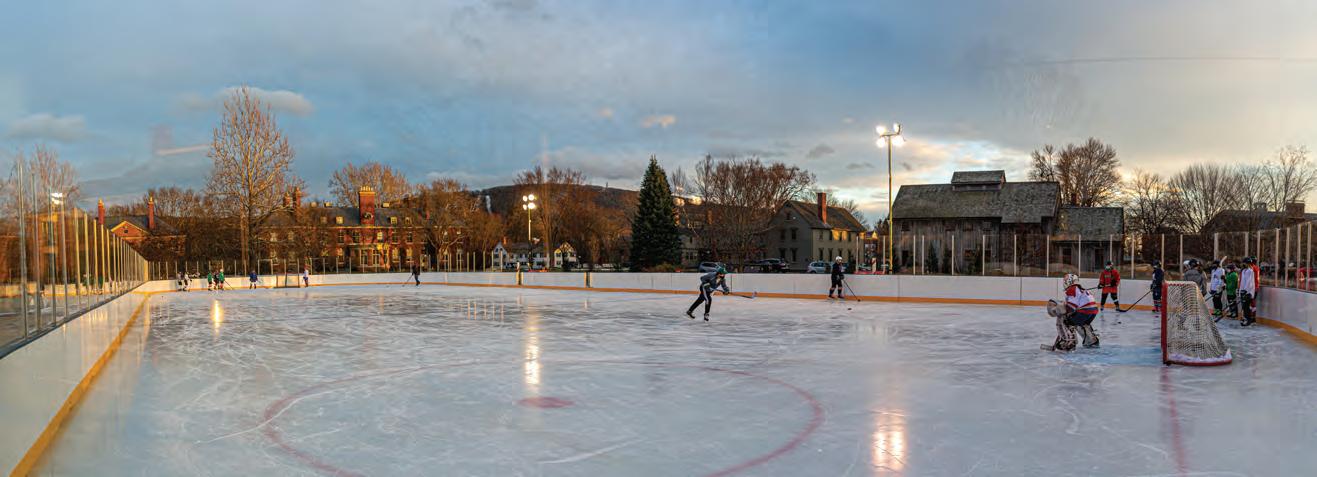

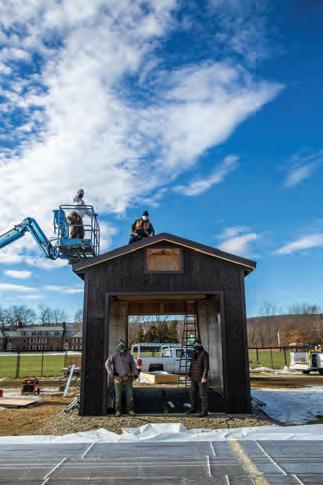

 BUILD IT /// Number of days given to Facilities to create three new dorms (Hitchcock conversion below), a dining pavilion (AKA: Hogwarts), an outdoor Zamboni garage and the accompanying outdoor skating/hockey rink—both “Covid Keepers.”
BUILD IT /// Number of days given to Facilities to create three new dorms (Hitchcock conversion below), a dining pavilion (AKA: Hogwarts), an outdoor Zamboni garage and the accompanying outdoor skating/hockey rink—both “Covid Keepers.”
In addition to minimizing potential exposure to Covid through the new academic schedule, reconfigured classrooms, plexiglass barriers, and other physical safety measures, Deerfield took tremendous steps to ensure faculty and staff health, safety, and well-being. It started with a promise that no employee would be laid off or furloughed during the pandemic. “At a time when we were watching every other employer—and even some schools— laying people off, cutting services, and so on,” says Director of Human Resources Sara Cahillane, “We were able to help keep people whole.”
Other measures that helped ease stress for employees as they navigated the return to in-person work was frequent communication from Dr. Austin; access to masks and other protective equipment; and, most importantly, the unlimited PCR testing program Deerfield put in place for the entire community, including employees’ immediate family members. Additionally, Cahillane, her Human Resources colleagues, and the team from the Academy’s daycare center created what came to be known as the “Turf School” in the Athletics Complex, where faculty could drop off their children for supervised online learning on days their elementary or middle schools were closed. Essentially opening a brand-new school, with all the associated State requirements, was a heavy, but essential, lift during a time already filled with “extra” work. And John Taylor hired ten young alumni as teaching and resident assistants to fill in for faculty or dorm parents if they tested positive, had to quarantine, or simply felt exhausted. “Through all of this,” says Cahillane, “it was really comforting to know Deerfield has, and will, take care of employees.”

Thanksgiving 2020 was approached with trepidation and relief, as the Academy closed for the entire month of December; albeit while providing extensive “D-Term” remote learning opportunities and connection for students, which was robustly facilitated by College Advising and the Academy’s Center for Service and Global Citizenship. Teachers may have been able to catch their breath, but not so Galli and the Phys Plant crew. Concerned about a predicted winter spike in cases, Dr. Austin had decided to tighten the Deerfield bubble—or, to use Dr. Benson’s metaphor, constrict the holes in the colander—by moving all day students onto campus. Jess Day, whose daughter Piper was then a senior, says she will always remember Dr. Austin’s announcement. She notes that there could have been a stigma around day students that year, since they
were commuting on and off campus and could potentially spread the virus. “Instead of telling them to stay home,” says Day, “John said, ‘come and live on campus,’ (at no extra cost to families). That was mind-blowing to me. It speaks to what kind of a leader he is—inclusive and hyper focused on our students, parents, and their well-being. It was always crystal clear: We are doing this for the kids.”
In just 46 days, Facilities converted their own office building, the Office of Advancement’s Ephraim Williams House, and Hitchcock House—the school store—into 21 dorm rooms for day students, including spaces for faculty residents. When the term resumed in January, 70 day students joined their boarding peers, and the majority stayed on campus for the remainder of the school year.

Even as he prepared to move day students to campus, Dr. Austin’s ongoing priority was to keep peeling back Covid restrictions so as to normalize the student experience. To do so, he and his team continued to rely on advice from the experts at EH&E and Pinnacle. “There’s not a decision that we made where I couldn’t give you a bibliography from the consultants,” says Miller. “Even when we moved exceptionally fast, we made data-informed, scienceinformed decisions.”
A key first step toward normalcy, Dr. Austin felt, was to bring back sit-down meals; so, over the winter break, Phys Plant and an outside consultant built a temporary dining pavilion in the quad outside the Dining Hall. Tongue firmly in cheek, it was soon nicknamed “Hogwarts” for its cavernous interior, and the Dining Hall itself was reconfigured to accommodate sociallydistanced sit-down meals. Director of Dining Services Mike McCarthy remembers spending four days with a tape measure, trying to work out the schematics for keeping everyone six feet apart while sitting at the tables.
Thanks to these tremendous efforts, Deerfield brought back sit-down lunches that winter. Students sat four to a table, food was in to-go containers, and no adults were assigned to tables, but they finally had the opportunity to sit with friends and meet new students from different grades over a shared meal.
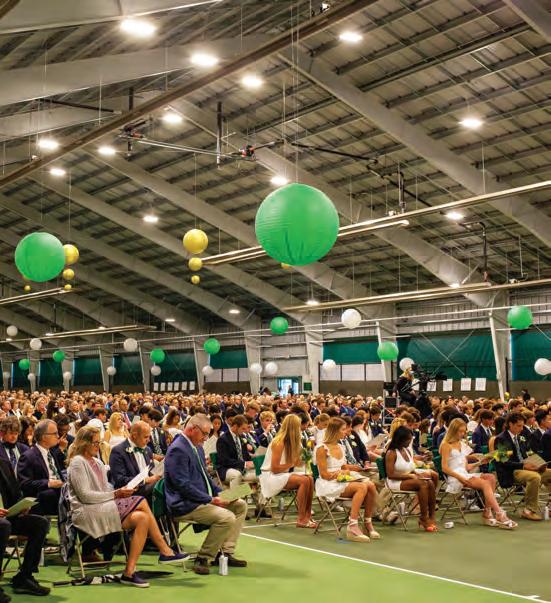
Slowly, Academy life inched back toward normal. In February, the first interscholastic basketball and ice hockey games were played. By the Spring Term, many faculty, staff, and older students were vaccinated, and, with advice from their consultants, the Academy was able to relax even more regulations. The interscholastic sports schedule returned to almost normal, and, in the third week of the spring, parents were allowed back on campus, to their and their students’ great delight. None of this would have happened if Deerfield’s leadership team had not been, as Howe puts it, “constantly looking for ways to push the envelope.”
FIRSTS FOR THE VISUAL AND PERFORMING ARTS /// the first Topics Tutorial mural, the first radio play, the first Artsapalooza and Arts Extravaganza, the first outdoor-indoor cabaret


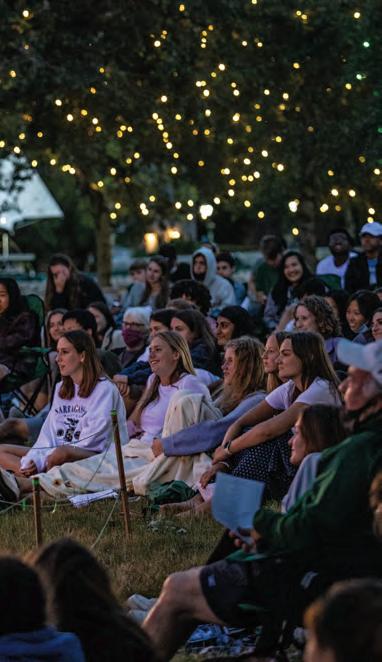
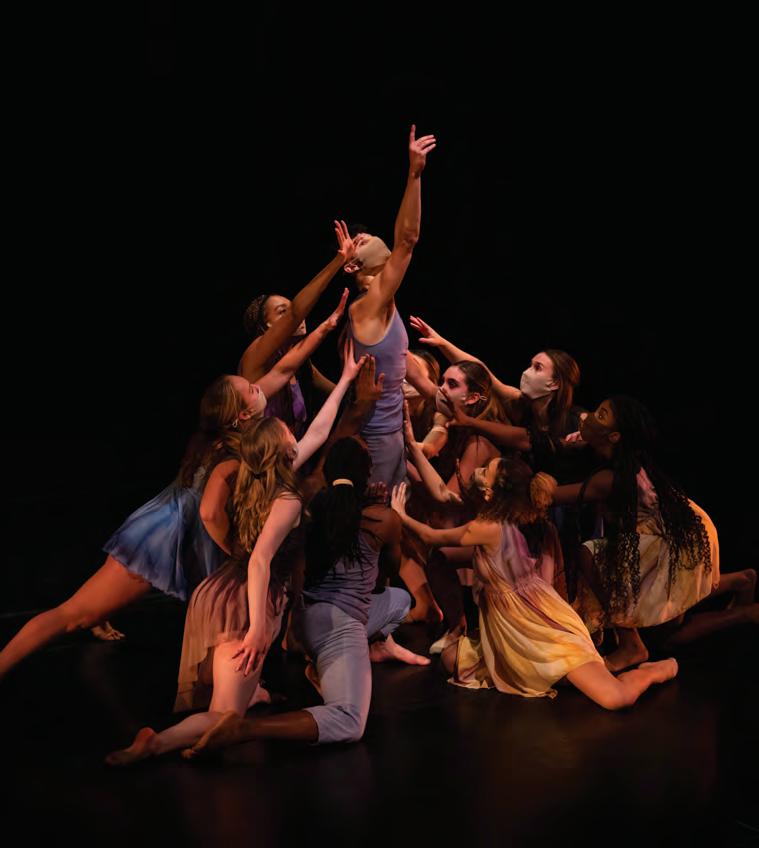

All these successes are not to say that Deerfield remained Covidfree; early on, Dr. Austin and his team realized that preventing positive cases was an impossible task, and so from the start, the goal was to manage cases as they arose. The first student tested positive three weeks after everyone was back on campus. Dr. Benson and his team, with the help of David Miller and a team of trained contact tracers, rushed to implement tracing, called parents in the middle of night, supervised disinfecting dorms, and ushered close contacts off campus early the next morning. “That first case was intense,” says Miller. “It felt so complex—the number of moving parts and pieces, close contacts, and parents involved.”
After debriefing, the team knew not to treat each positive case as an emergency; still, the logistics remained complicated, and Dr. Benson dreaded every time he had to tell a student they needed to isolate. There were also times during the year, such as after winter break when a clinical cluster of Covid occurred in a dorm, when Dr. Benson had enough students in quarantine or isolation that he was overseeing three medical facilities: the Chen Center, the old Health Center, and the Annex of the Deerfield Inn. “Our health care staff worked their tails off,” says Keith Finan. “They were constantly under siege, but they managed it exceptionally well.”
Deerfield administered nearly 50,000 Covid tests to the community between July of 2020 and June of 2021. Over the course of year, 26 students and 30 employees/on-campus household members tested positive for Covid-19. The Academy’s average positivity rate peaked at 0.40 percent, dramatically lower than the Massachusetts average of 3.6 percent or the national average of eight percent.
Low rates of Covid on campus, coupled with the decision in May by the State of Massachusetts to lift the rules on masking outdoors, meant that the Class of 2021 was able to graduate in-person at a mask-free event.
Returning full circle to the site where Covid testing began in September, the Facilities and Dining teams set up the Senior Dinner in the Tennis Pavilion. As soon as the dinner finished, the two departments, with help from faculty, worked overnight to set up 1,600 folding chairs for Commencement the next morning.
“It’s the little things like that that really add up,” says Galli of the extra effort made to pull off the celebration.
That morning, David Miller guided the traditional bagpiper down Albany Road to Commencement (after testing to confirm he was Covid-free, of course). “I started getting really emotional,” he says. “A year before, we were virtual, but at that moment we were almost back to normal. That was a beautiful thing. It was really powerful to have made it.”
Over the summer of 2021, the Academy looked forward to a more “normal” school year. For many departments, particularly Phys Plant, Dining, and ITS, this meant undoing most Covid-related construction and systems they had put in place. “That work was equally as hard,” says McCarthy. Swivel cameras were put in storage; the extra classrooms, dining pavilion, and day student dormitories were dismantled, and Ephraim Williams House, the Hitchcock Store and Physical Plant Offices were restored; familiar tables were brought back to the Dining Hall and classrooms; the grab-and-go system of serving meals was dismantled, self-serve machines were turned back on, and the Greer Store prepared to reopen to full capacity.

Dr. Hills spent the summer taking stock of the academic schedule. The new schedule had been a huge benefit to community health, in that fewer classes per day meant that everyone was exposed to fewer contacts. In addition, students had less homework at night and more time for deeper learning and reflection. Hills had thought these changes might reduce stress and, indeed, they were popular among students and faculty alike. “Also, we found that students were getting more sleep!” he says.
Working closely with Dr. Austin and his Academic Affairs Office colleagues, Dr. Hills created an updated model for the 2021-22 school year; built on Deerfield’s commitment to academic excellence and mastery, the 2021-22 schedule was framed around four guiding questions: What’s best for our students? For their health and well-being? For their learning? How can we meet the demands of our mission? This updated schedule reinstated year-long courses (to facilitate language study and other subjects) but kept the fewer classes per day (now three 90-minute classes instead of two) from the previous year, and introduced daily Community Time—essentially a 45-minute block of “free time” that empowered students to manage their mid-morning activity—everything from studying to grabbing a snack in the Louis Cafe. “The benefits to Deerfield’s academic programs that arose because of Covid will remain forever. That was a huge success,” notes Brian Simmons.
In many ways, 2021-22 was a “normal” year. Apart from some gateway testing upon arrival and after the winter break, weekly testing and masking ended. Sit-down meals, School Meetings, and all cocurriculars resumed. These welcome changes were made possible in large part by Dr. Austin’s decision to make vaccination mandatory for the entire Deerfield community. In the Chen Center, Dr. Benson and his team were back to seeing sports injuries and colds. Things felt “routine with a Covid overlay,” as he describes it.
Throughout the previous year, Amie Creagh had worried that Deerfield’s culture might get lost amidst so many pandemic restrictions. “How do you keep the throughline when there is such a crevasse in the middle?” she wondered. Her answer came at Convocation, when Student Body President Hugo Nutting called upon the Class of 2022 to bring along the younger classes in preserving Deerfield’s traditions but to do so with kindness and magnanimity. In response, “The senior class really stepped up,” Creagh says, going so far as giving gentle “etiquette reminders” during announcements at sit-down lunch.
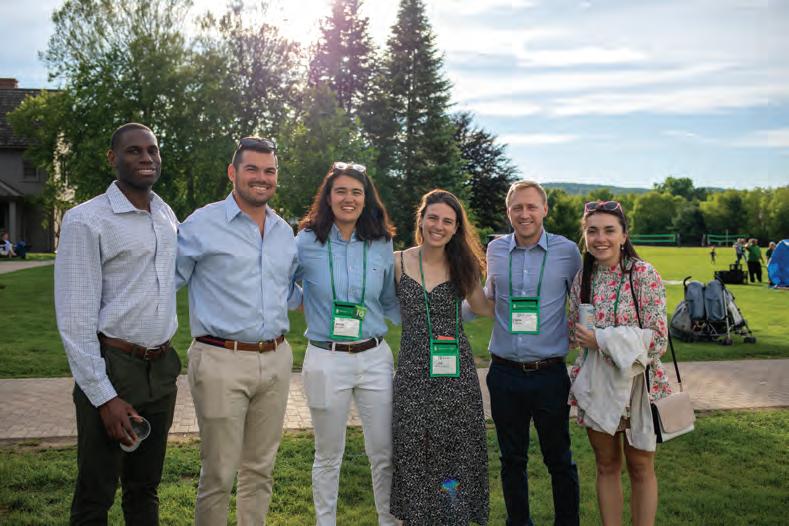
Number of alumni who attended a Reunion in June of 2022:
Number of parent and guardian visits to campus Spring 2021:
Number of applicants to Deerfield in March of 2022:

OUR LOYAL ALUMNI AND PARENTS REALLY STEPPED FORWARD IN THE CRISIS AND RESPONDED IN INCREDIBLE WAYS.
The 2021-22 year had its Covid bumps. On the return from winter break, the Omicron variant tore through campus.
Between January and mid-February, 330 students tested positive, with 40 positive cases in one day alone. Few students had serious illness, but “it was crazy,” says Dr. Benson, referring to all the contact tracing, emails to parents, and documentation that needed to be done. Deerfield parents really stepped up during this time, traveling to school to fetch their children—and sometimes their children’s friends—if they
— Director of Human Resources (and parent of two Deerfield students) Sara Cahillane

had tested positive. Dr. Benson even recalls a group of friends fighting over an international student who needed a place to isolate.
Positive cases slowed to a trickle during Spring Term, with a slight bump right after the prom (“Promicron,” jokes Benson). Happily, all students were cleared to join in the Commencement ceremonies. At that point, Deerfield had survived two years of pandemic.

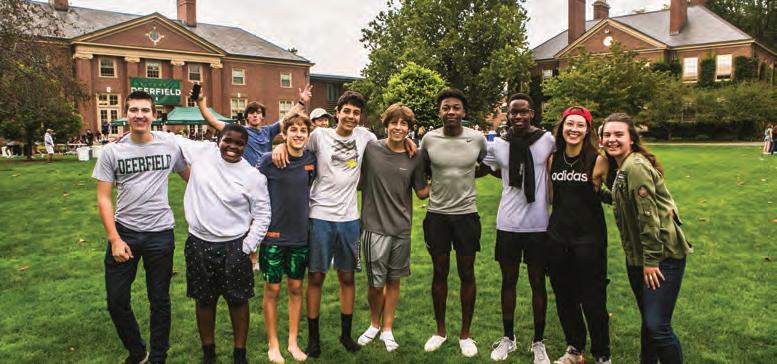
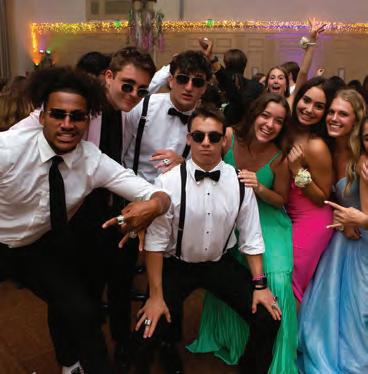
By some measures, however, it was more than survival: the Academy had thrived. Take, for example, college admissions. After moving to test-optional admissions during the pandemic, many colleges and universities saw an increase in applications, while a rise in deferments and “grey shirting” of athletes meant fewer available spots for applicants. Despite the steep competition for college admissions in 2021 and 2022, Deerfield students had, as Dean of College Advising Mark Spencer puts it, “the same awesome outcomes.”
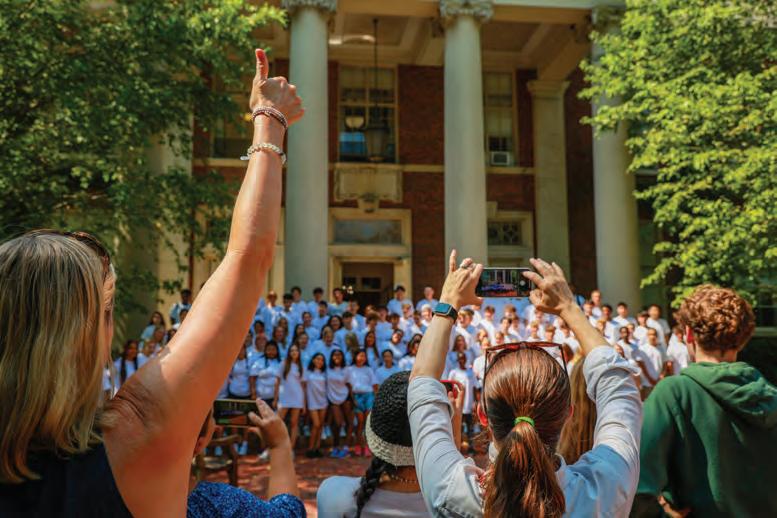
KNOWING THAT SHE WOULD BE SAFE AND KNOWING THAT SHE WAS ABLE TO HAVE FACE-TO-FACE INTERACTION WITH HER TEACHERS AND HER FRIENDS WAS AMAZING. THE NUMBER ONE GOAL AT DEERFIELD IS TO DO RIGHT BY OUR STUDENTS; THAT MAKES ME
When the school moved to remote learning in 2020, Dean of Admission Chip Davis was concerned that he’d see a big drop in applicants. “Deerfield has always struck me as a place that truly shines in person,” he says. His Admission team pivoted quickly to digital, working with the Communications Office to beef up Deerfield’s social media presence, building out engaging virtual presentations, and conducting interviews over Zoom. As a result of these efforts, as well as what Davis calls a “flight to quality” by many families, the past two years saw the largest applicant pools in Academy history.
Records were also broken by the Office of Advancement, which finished the highest two years on record in Academy fundraising. This included gifts earmarked for the new Simmons Dormitory and supplemental financial aid for families during the pandemic. “Our loyal alumni and parents really stepped forward in the crisis and responded in incredible ways,” says Chief Advancement Officer Ann Romberger. After also “pivoting to digital” during 2020-21, Advancement held two Reunion weekends this past June for three cycles of Reunion classes—44 classes in total —bringing 1,550 people back to campus to celebrate.
Deerfield emerged from the pandemic, as Amie Creagh puts it, “resilient, strong, and connected.” There have been bright spots and records broken. There have also been “Covid keepers,” innovations and systems put in place during the pandemic that will remain, such as the new academic schedule and outdoor advisor/advisee “walk and talks”; the enhanced air exchange systems; the ice rink, food trucks, and other Covid-friendly student activities; and the use of Zoom by Admission to reach more international families and by college advisors to check in with rising seniors over the summer.
Then there are the intangible Covid keepers. Kim Butz believes a big takeaway for Deerfield’s staff has been flexibility: “For an institution deeply entrenched in tradition and history, Covid forced us to look at everything we did and see if there was a better way to do it. I think in the long run we will be bolder and more creative going forward.”
Much of the credit for the Academy’s strong position can be attributed to Dr. Austin, who as a new head of school led Deerfield through the crisis. “What made his leadership so compelling,” says Taylor, “is that he was always looking six months ahead, doing it with a team of people, and getting as much information as possible from people who knew their stuff. And then he was fearless in terms of communication and implementation.”
If you ask Dr. Austin about this, he immediately emphasizes the fact that the everything, beginning in March of 2020, was a team effort from the Board level on down. “The level of dedication among all Deerfield employees was off the charts,” he says.
“It’s important for all of us to remember and celebrate this fact.”

Because the Academy was on strong financial footing, and because families and alumni increased their support during the pandemic, Deerfield was able to spend roughly $12 million to deliver that strong experience for students and keep the community as safe as possible. For Keith Finan, drawing down on the endowment made complete sense during this time: “If we wanted Deerfield students during the Covid period to have a similar experience as past students and hopefully future students, then we needed to spend money—for air filters, a dining pavilion, etcetera.” It was sometimes “a scary proposition” to ask the Board to spend this kind of money, but Finan feels fortunate that Deerfield’s trustees “were engaged and very supportive in spending the resources necessary.”
As Board President, Simmons is humbled that Deerfield was in the financial position to afford the opportunities most other schools were not able to pursue. “That’s thanks to generations of support and generosity from parents and alumni,” he says.
Sara Cahillane likely speaks for all Deerfield parents when she says she is grateful that her daughter was able to attend school in person throughout the pandemic. “Knowing that she would be safe and knowing that she was able to have face-to-face interaction with her teachers and her friends was amazing. The number one goal at Deerfield is to do right by our students; that makes me feel good and proud.”
At the heart of Deerfield’s pandemic response was, as David Miller succinctly puts it, “our people.” Jeff Galli has worked at Deerfield for sixteen years, but he says those two years during the pandemic were his best time on campus. “Everyone pulled together,” he says. Mike McCarthy, thinking back to those September 2020 days when his Dining Services team started work at 4:00 am and knocked off after 11:00 pm, agrees: “I sometimes look at the old menus and production sheets and delivery schedules we made during Covid and think, ‘I can’t believe we did it.’ But that’s Deerfield. From Facilities to Dining to ITS to the administrative team to the leadership team, when we put our heads together, we can do almost anything.”
Very few schools opened to all students for in-person learning in September 2020, and Deerfield would not have been able to do so if it were not for 100 percent of the faculty being willing to teach face-toface and work in the dorms. “Even the people who were nervous— because of course there were people who were anxious—showed up and did their jobs,” says Taylor. “The faculty’s level of dedication and commitment was phenomenal,” agrees Dr. Hills. “When you go to someone and say, ‘I need you to do this’ and they look you in the eye and say, ‘No problem; I’ve got you,’ that’s because our faculty has a practice of excellence-seeking on behalf of students. Without equivocation, I am so proud of my colleagues.”
“I’m proud to say I was part of Deerfield during that time,” echoes Simmons, “No one is glad there was pandemic, of course, but Covid really highlighted the values for which Deerfield stands.” //




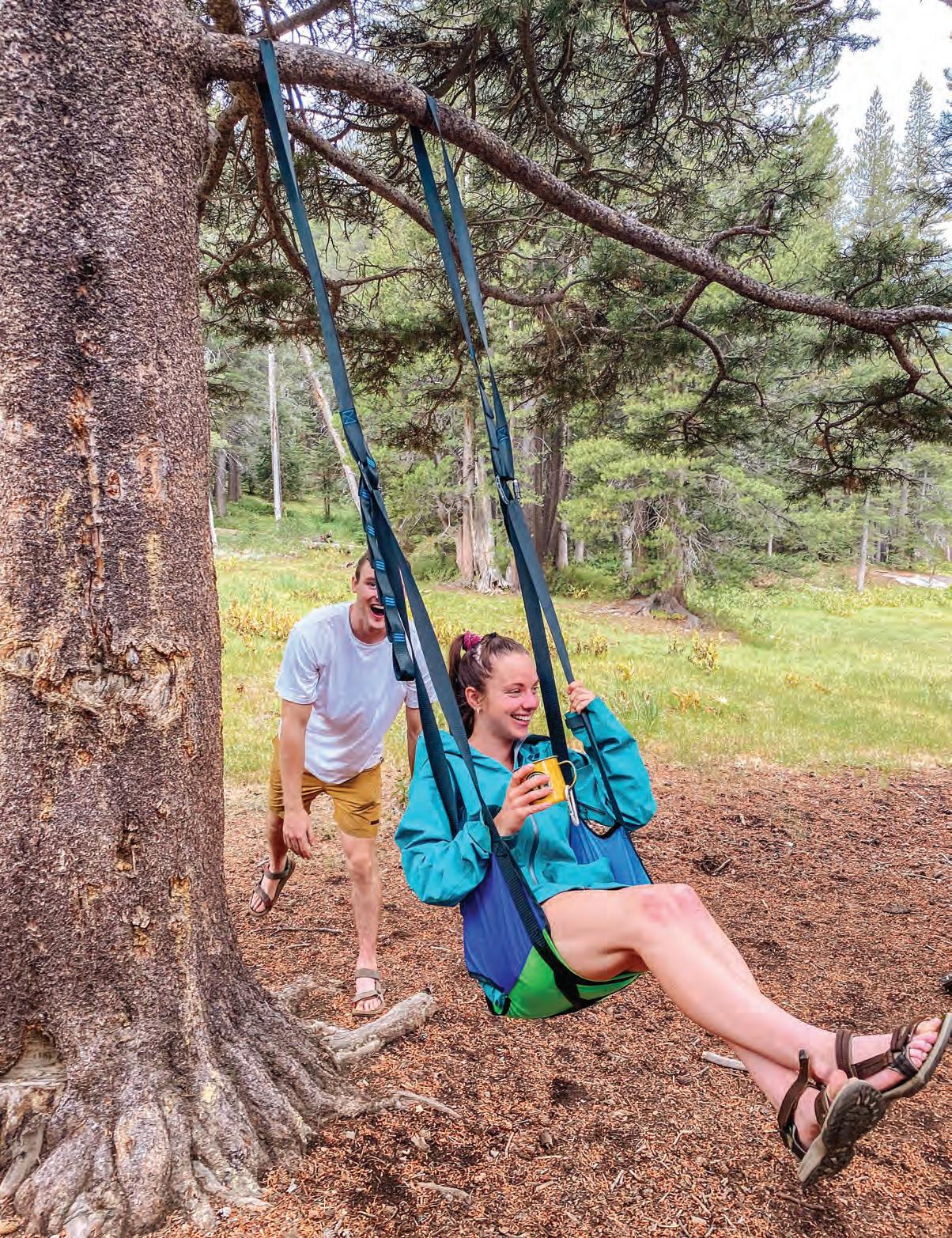
As with many entrepreneurs, Angela Cabral and David Lackner started their business, Pocket Swing, to solve a problem. Angie and David, who have been a couple since their Deerfield days, are newly engaged. They are both avid hikers and also share an entrepreneurial bent. During college—she graduated from Northeastern University in 2020 with a degree in Cellular Molecular Biology, and he from Tufts University with a degree in Electrical Engineering in 2019—they ran a pickle-making business together.
Both Angie and David are originally from the East Coast. She is the daughter of longtime Deerfield math teacher Sheryl Koyama and reveled in her childhood on Deerfield’s campus. David came to Deerfield from Great Falls, VA, in his junior year, attracted by the school’s hockey program and academic opportunities. At Deerfield, they forged a fast friendship before dating.
For the last several years, the two have lived in the Bay Area, where she worked as a biotech scientist and he as an electrical engineer. In late May 2022, the couple moved to Irvine, CA, where Angie will pursue a PhD at U.C. Irvine and David has found employment as a flight software engineer for a satellite company.
Having spent several years in California, which Angie calls, “America’s biggest backyard,”the couple has taken advantage of numerous hiking and camping opportunities. During their expeditions, they encountered a recurring issue. Angie explains, “Oftentimes, we’d arrive at a campsite very tired and well before the sun went down. We would literally be sitting on a rock, uncomfortable and bored.”
The couple didn’t want to hike with camping chairs, as the extra weight would be significant. Angie says, “When you’re out for a hike, one of the biggest things is keeping your pack as light as possible.” The two began musing. What if, instead of camping chairs, they could have some kind of frameless seat? They envisioned something that could be stuffed into a cloth pack like a hammock. One evening, David and Angie took a camping chair, borrowed a roommate’s sewing machine and crafted a cloth swing that, with long straps, could hang over a tree branch or a metal bar. It worked, and Pocket Swing: The Packable Adventure Swing was born!
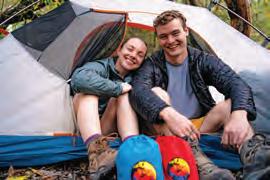
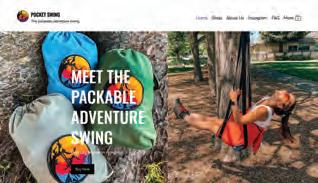
Since that moment of inspiration, the couple found a manufacturer based in St. Louis, MI, Well Made Workshop, to sew the swings. They formed an LLC and have a patent-pending. They have designed a website (pocketswing.com), and are building a presence on social media. Find them on Instagram at pocket_swing. A recent Kickstarter campaign was a big success, exceeding the monetary goal and attracting investors. Angie says, “We are so proud that people believe in our product without knowing us!”
The next hurdles—while they both adjust to a new community, as well as new academic and professional pursuits—are spreading the word and growing the business. “We’re looking at automated e-commerce and innovator competitions,” says David. The couple also wants to put their product into retail and online stores. “It would be great to partner with an REI or a Bass Pro Shop and sell through them,” says Angie.
Pocket Swings are versatile, and the founders envision multiple uses. “It’s a great chair to bring to the park or to a music festival or even in your backyard,” says Angie. As the Pocket Swing website says, “Clip the pocket swing onto anything from a tote bag to a multi-day pack and add a flavor of fun and relaxation to your adventure. Toss the straps up over a tree near the campsite, next to the swings in the park, or beside your next tailgate. The Pocket Swing is your key chill-out, good time, really-earned-this-beer, outdoor essential.”
Available in an array of colors, the swings come with two straps and two carabiners to safely operate the swing from any large tree branch. The colors are customizable, and Angie and David would like at some point to donate green and white swings for the Deerfield campus!
For now, the two are keeping busy, beginning to plan a wedding, adjusting to new roles, and setting up a new home in southern California. But together with their dog, Bandit, they are often hitting the trails and relaxing late in the day on their handy invention. As Angie says, “It lives in my car, and whenever we head out, I bring my Pocket Swing.” //
 / By Lynn Horowitch
/ By Lynn Horowitch
When it came time for Claire Collins ‘15 to pick a spring sport during her first year at Deerfield, she knew that most swimmers chose to row or play water polo. Claire had never tried either, but her first experience on the erg—where she “pulled some fast numbers” —led an observant faculty member to suggest that she might want to give rowing a chance. That turned out to be good advice, and Claire, who hails from McLean, VA, rowed all four years at the Academy.
An exceptional athlete, Claire was also a tri-varsity captain, leading girls rowing, swimming, and volleyball her senior year, but it was in a shell on the water where she most notably excelled; in 2014 and 2015, the girls team won the New England Rowing Championships and two Youth Nationals Championships. At Commencement, Claire was presented with the Sheldon Award and the Deerfield Cup.
Recruited to Princeton, Claire majored in economics and led the Tiger rowing program to unprecedented success; during her tenure, the Women’s Varsity Eight won four Ivy League Championships. While serving as co-captain in her senior year, Claire had a highlight moment at the Championships: Every varsity Princeton women’s boat won its race. She recalls, “We totally dominated, and it was so exciting to see, as not every boat was expected to win.” In 2019, her boat placed seventh at the NCAA Championships, and though rowing at the NCAA regatta meant Claire missed Princeton’s annual athletic awards banquet, her coach and the Athletic Director contrived a faux media interview and surprised her with the C. Otto von Kienbusch Award, given each year to the university’s top senior female athlete.
Claire notes that serving as a captain at Princeton provided life lessons. “I learned a lot,” she says. “You try to please, wrangle, and motivate everyone, but not everybody is going to like you.”
Additional lessons about finding balance and staying motivated have also served her well.
With only a week between Princeton graduation and starting as a member of the US Women’s National Team, Claire knows a lot about staying motivated. At centers based in Princeton and Chula Vista, CA, she trains year-round for roughly six or seven hours each day. “The National Team was a lot to adjust to. They are fitter, faster, stronger,” she comments. Her regimen includes warming up, rowing, stretching, erging, and lifting weights, all divided into two three-hour sessions six days a week. In addition, to supplement her USRowing salary and to gain skills for the future, Claire works part-time as a healthcare consultant with fellow Deerfield graduate Brigitte Anderson ’98 at Orange Vista LLC, a boutique market research consultancy focused on innovation in the healthcare, education, and social sectors based in Chicago.
Just as Claire was getting used to the pace of training, the Covid-19 pandemic hit, derailing her workout regimen and forcing all rowers to leave Chula Vista. At home with her family in the Washington, DC, metro area, Claire trained alone for about six months on her own erg. In good weather, she rowed singles at a club in DC, sending videos to
her coaches for feedback. Returning to Princeton in September 2020, she was eager to be among her peers, but became plagued by a broken rib—an unfortunate repetitive strain injury. Weeks of riding a bike and physical therapy followed, and she was able to put it behind her, noting, “It had happened before in college, so I knew how to approach the situation.”
Once healed, Claire returned to Chula Vista in the winter of 2021 —just in time to try out for the US Olympic team.
“The tryout was stressful. I thought about improving every day and tried not to think about the process. Then I looked up, and it happened!” Claire was officially on the team, an achievement that she says “was pretty surreal! It’s always been a dream.”
Before heading to Tokyo, Claire and her teammates each received two huge duffels of US Olympic team gear. “It was like Christmas, and pretty crazy!” she recalls. Then they traveled to Japan by way of Hawaii to acclimate to the heat and humidity that is typical of Tokyo summers.
At the Olympic Village, Claire enjoyed the energy and camaraderie among all the athletes. She says, “Most everyone has the attitude, ‘Wow, we’re here!’” She also notes that political and diplomatic issues took a back seat, as athletes traded pins with each other and struck up conversations with people from nations around the globe. “You know there are a ton of conflicts in the world, but we’re all here together to compete peacefully.”
Claire rowed in a Women’s Four that placed seventh. She relished the whole experience, and is only sorry that Covid-19 precautions prevented athletes from attending events outside of their sports, and required them to leave Tokyo within 48 hours after competing.
Fresh off a silver medal finish in June 2022 in Women’s Pair at the World Rowing Cup II in Poznan, Poland, Claire is preparing for the Henley Royal Regatta in the United Kingdom and World Rowing Championships in the Czech Republic. After those, Claire plans to continue as a professional rower. Noting that many rowers don’t peak until their late 20s, she would like to continue on her path at least through the 2024 Olympics in Paris, adding, “Hopefully, I’ll get a medal at the next one.” //

The seeds for Louis’ career were planted at Deerfield. He designed his first house for the culminating assignment in a design class taught by Yuji Kishimoto. CENTER>>
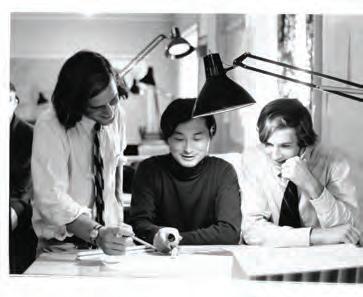




Louis Kaufman ’76 is in a good place. An accomplished architect, Louis moved from Sacramento, CA, to Ketchum, ID, in January 2022, when he joined de Reus Architects (deReusarchitects.com) as a Principal. He uses the word “idyllic” to describe both his new city and his new practice.
A lover of the outdoors, Louis, and his wife Christina, can find themselves atop a mountain after just a short 30-minute walk. They are in awe of the natural beauty of the region. “You really can’t believe it,“ says Louis of the flowers, trees, and greenery. “It’s like God decided to say, ‘Let’s really start designing stuff here.’”
He is equally enthusiastic about his new role and new employer. Having worked for many years at a firm that employed roughly a 1,000 people, de Reus has fewer than 20 employees and is “a delight.” Louis explains, “The DNA of this practice is private homes that come out of the hospitality sector—primarily resort work. They’re connected to ‘guest experience,’ and designed to allow residents to recharge.”
Currently, Louis is designing homes in Hawaii, Idaho, and Portugal, traveling to each site multiple times. He says all are in spectacular locations, noting that he designs on some of the most remarkable sites on the face of the earth: “They are oceanic, volcanic, primal.”
Louis sees his role as joining his clients on their journey and serving as a guide. He says, “It’s incredibly joyful to make homes that people get to experience.” It’s also very much a partnership; his clients are knowledgeable and even intently focused on architecture. “They are investing in remarkable pieces of land and engaging with those sites.” His challenge is to design a unique, functional, beautiful structure that is connected strongly to each location. “We’re not creating something that’s not there, but illuminating what is there.”
The seeds for Louis’ career were planted at Deerfield. He designed his first house for the culminating assignment in a design class taught by Yuji Kishimoto. Kishimoto had worked for renowned architect Louis Kahn and established his own firm in Boston but decided he wanted to be an educator. He taught at Deerfield for several years before serving as a professor at Clemson University for more than three decades.
In addition to an introduction to the challenges of designing a house, Deerfield also provided Louis with an understanding of how place shapes people. Having grown up in Manhattan Beach, CA, a “small surf town,” Louis was unfamiliar with the New England history and heritage that shaped life at Deerfield. “What I discovered and fell in love with was that sense of tradition, history, and location,” he says. “It helped me understand the power of a physical place in shaping identity, and it clarified for me how a place really can resonate with somebody.”
After Deerfield, Louis earned a BA in Design from UCLA in 1980 and then a Master of Architecture from Harvard University in 1984. He settled in Southern California and worked for several different firms, as well as on his own. And he gained valuable experience and new perspectives building homes overseas. One project in New Zealand “deepened my commitment and broadened my ability to understand and investigate a location, and then respect it and design something tailored to it,” he recalls. A two-year stint with a design firm in Amsterdam further enhanced his appreciation for history and place in shaping architecture.
While working out of an office in a 17th-century canal home, Louis gained an understanding of the different role that modern architecture plays in a European city versus in the United States.
“In Europe, after the World Wars, reconstruction was a driving force,” he notes.
“People wanted to leave the past behind and explore new paradigms. That deepened me as an architect.”
Back in his new corner of the United States, Louis is preparing to build a home in Ketchum for his family, including his two college-age children. He will, of course, imbue it with a strong sense of place, guided by the landscape of the Idaho Wood River Valley. In doing so, he will follow the mission and ethos outlined on the de Reus website: “We distill a project to its essence, exploring client aspirations, location, and culture to inspire meaningful and respectful architecture.” //

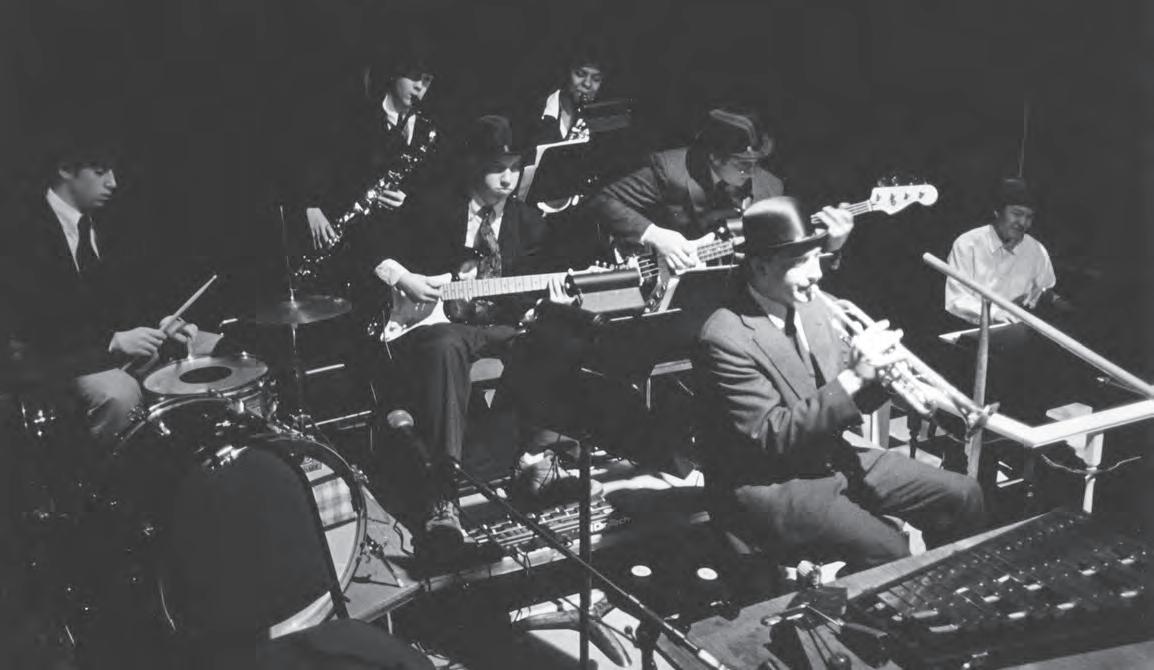

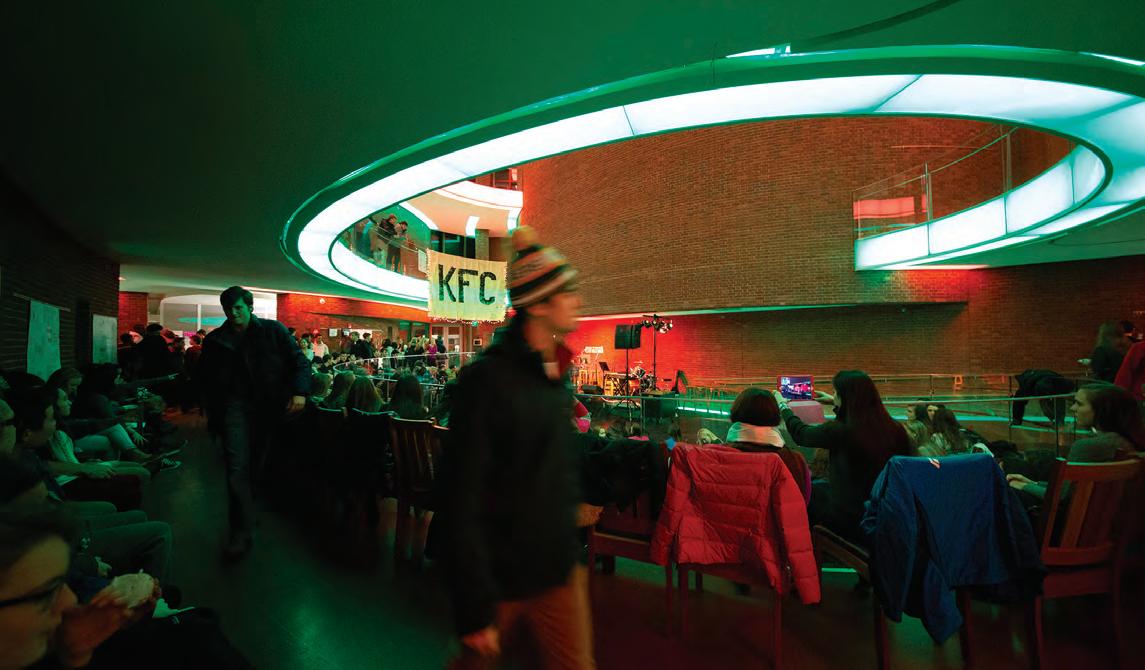
In Memoriam records from Nov. 1, 2019 - June 28, 2022. Please go to deerfield.edu/alumni/class-notes for the most up-to-date information on classmates, including obituaries.
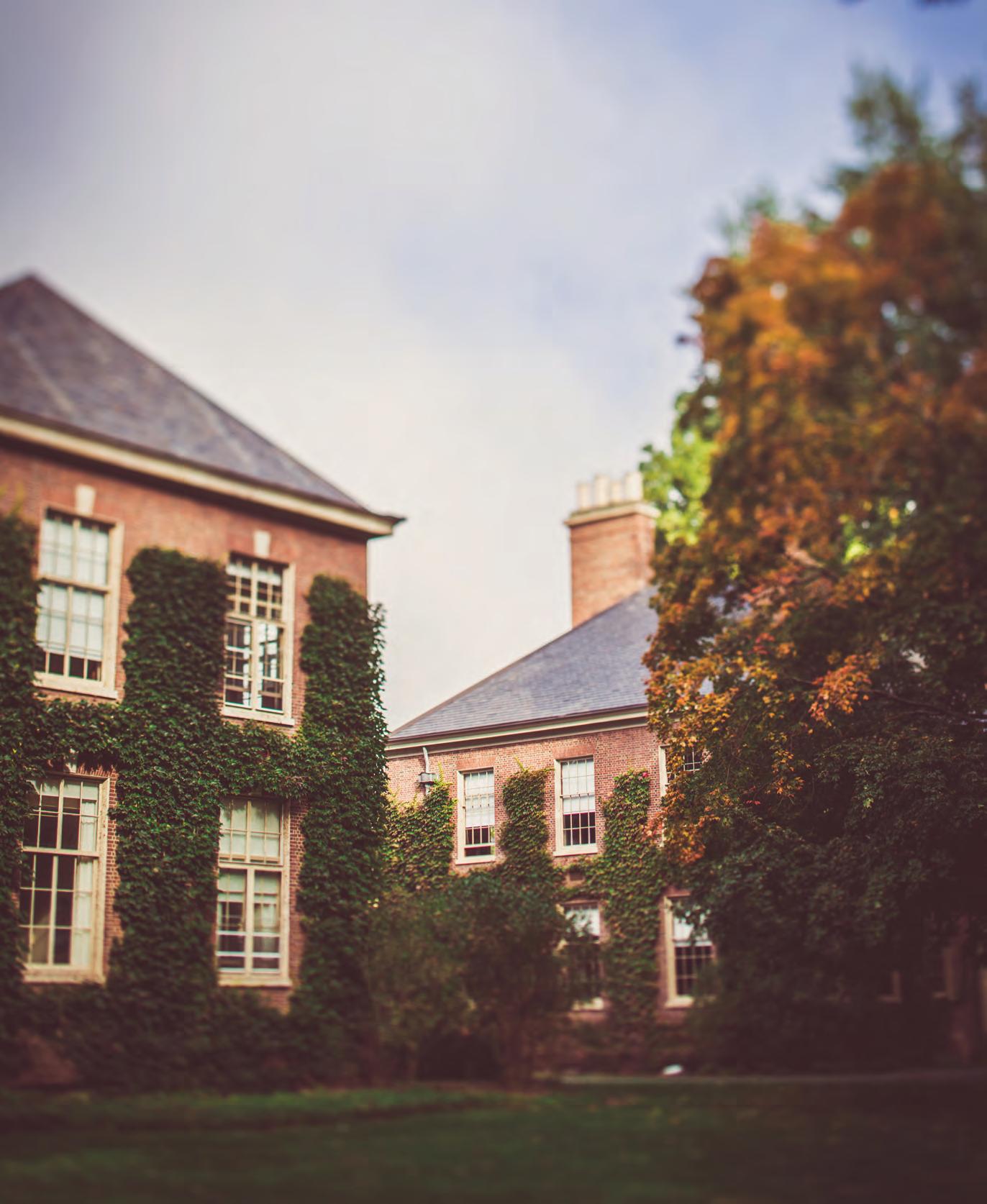
1936
Myron Dexter Hager Jr. * January 17, 2020
Winship A. Todd December 8, 2020
1937 George Chandler Clapp September 24, 2015
Thurston Holt January 1, 2020
1938 Richard Storer Ward December 1, 2019
1939 Allen Condon Boucher February 5, 2020
John H. Wrenn August 15, 2015
1940 Frank R. Ayer October 19, 2019
Frank Thatcher Bumpus December 18, 2020
Theodore Alvan Hyde January 10, 2021
Kennard P. Perry October 13, 2019
Alan L. Rossbach June 20, 2020
Victor Salvatore Jr. October 6, 2020
1941 William H. Ashley December 2, 2017
Kenneth F. Eldredge June 8, 2020
Alfred C. Haven Jr. October 7, 2020
Gillet Lefferts Jr. March 30, 2021
John H. Madden Jr. April 12, 2021
Samuel A. Melnik July 3, 2021
Arthur Lee Nims, III September 15, 2019
James Oliver Starkweather * October 22, 2021
1942 Frank Douglas Adams Jr. * June 25, 2021
Edward C. Beach March 11, 2021
Donald S. Page March 17, 2021
William M. Rohrer June 25, 2020
Samuel S. Wilson June 25, 2014
1943 Sam G. Adler Jr. May 6, 2022
Roberto Cuniberti December 23, 2019
William M. Jackson November 19, 2020
J. Stuart Lovejoy January 11, 2022
Worthington Mayo-Smith * June 5, 2020
John Clarence Pettengill December 5, 2019
Richard Grant Zimmerman * April 2, 2021
1944 Wallace Barnes * December 10, 2020
Joseph Becker Jr. April 16, 2011
Joseph Brackenridge Cary January 24, 2017
Edward S. Dewey August 21, 2019
David A. Eaton September 15, 2020
Edward Harrington Hollister III March 22, 2021
John Burnham Howe
January 20, 2020
Peter Sidney Larkin December 16, 2019
Edwin P. Maynard III March 19, 2021
Robert A. McKinley June 14, 2017
John B. Miner May 8, 2019
Ward Ford Schumann * January 9, 2021
David Sanders Thomson April 28, 2015
Robert L. Timmons August 9, 2020
James B. Van Dusen * January 13, 2022
1945 Cornell C. Angleman May 3, 2020
James Douglas Biggs Jr. * January 24, 2021
James T. Collingwood Sr. March 2, 2022
John C. Harned February 8, 2020
Leighton H. Laughlin August 21, 2020
Bayliss G. Lee II April 21, 2016
Milton Cass Lightner December 21, 2020
John T. Palmer August 31, 2020
Richard B. Palmer March 28, 2013
Henry Russell Platt III April 28, 2020
Edward J. Redmond Jr. March 19, 2022
Robert H. Shaw March 24, 2020
Burgess P. Standley March 12, 2020
Mollie Taylor December 2, 2021
Frank A. Vogt September 19, 2020
George F. Whiting
January 25, 2022
Charles Anthony Wimpfheimer August 2020
Charles H. Withers March 10, 2021
Edward J. Yazwinski August 16, 2021
1946 Clifford Edward Barbour Jr. February 5, 2020
John Parkman Butler
September 3, 2016
Edward Foster Conklin * December 4, 2018
Ralph Earle II
January 13, 2020
Robert Ferrey Fuller October 24, 2019
Robert B. Haynes September 17, 2019
Frederick G. Knight April 9, 2016
James B. Laughlin II February 28, 2021
Allen Martin Jr. January 25, 2020
Alan Parsons February 3, 2021
John Peter Scott May 26, 2020
William A. Stevenson April 28, 2020
John A. Wilson * August 20, 2020
1947 David George Barlow November 20, 2019
Robert B. Baxter September 28, 2021
Williston R. Benedict July 12, 2019
Raymond Hooper Close November 1, 2019
Paul F. Coon August 30, 2019
Edmund Machold Davis December 25, 2019
Alan C. Donaldson
June 9, 2021
H. Phelps Edwards, Jr. December 6, 2019
John M. Fraser October 19, 2016
William W. Hewitt, Jr. October 3, 2021
Llewellyn Merrick December 6, 2019
Michael R. Parker February 23, 2014
David A. Sennett July 7, 2006
Harold L. Smith Jr. February 17, 2015
Thomas C. Sweitzer January 19, 2021
Nathan Tufts Jr. December 1, 2021
1948 Hale Richardson Allen February 16, 2020
Marvin W. Bridges, Jr. September 11, 2021
Edward C. Chorley, III March 31, 2021
Carleton Clark Comins December 4, 2021
William N. Fisher April 19, 2014
Marshall P. Keating February 29, 2020
George E. Keeler II
April 28, 2020
William S. Keeler October 11, 2013
David A. Lee November 16, 2009
Oliver P. McComas Jr. August 24, 2020
Arthur L. Porter March 25, 2017
Cameron H. Repp December 12, 2021
Alexander J. Robertson Jr. January 29, 2022
Charles R. Snorf July 30, 2020
Dieter H. von Hennig September 9, 2020
1949 Carlos E. Allen April 30, 2020
Robert A. Barrett September 25, 2015
John F. Benjamin April 20, 2020
Gordon L. Brett September 14, 2014
James A. Britton Jr. May 3, 2021
Edward F. Danielski Jr. February 14, 2021
Edwin H. Grant Jr. * December 19, 2021
Harleston J. Hall Jr. May 23, 2020
Charles Lawrence Hildreth Jr. January 25, 2020
Francis A. L’Esperance Jr. February 1, 2022
Donald Francis Martin
June 9, 2009
Charles Wolcott Merriam III August 16, 2020
Dana E. Pearson February 15, 2022
Robert E. Stocki February 1, 2021
Thomas Dodge Twichell January 5, 2016
1950 Peter F. Andrews December 20, 2021
Gordon S. Bigelow March 16, 2022
John Edward Bingham * August 15, 2019
Thomas C. Blandy July 10, 2020
James E. Brewer II * March 28, 2020
William D. Falcon May 1, 2021
John C. Flynn January 18, 2022
Gerald V. Gabriel March 18, 2020
Edwin Bruce Haertl May 7, 2020
Donald M. Ham March 18, 2020
Horace Augustus Hildreth Jr. December 12, 2019
Norikazu Kabayama February 9, 2020
Peter T. Loizeaux
December 23, 2020
George C. Lunt II March 29, 2020
Alexander A. Mackimmie III
November 4, 2020
Andrew P. Miller July 2, 2021
Robert B. Rogers III July 16, 2020
1951 William S. Ames * January 16, 2022
Jan V. E. Austell
November 3, 2017
Howard G. Cushing Jr. July 5, 2020
George M. Dill January 24, 2022
Robert Yale Fox December 11, 2019
Emil David William Hauser Jr. July 24, 2017
Robert Lee Hildreth
November 25, 2016 Hugo Hoogenboom July 21, 2020
Peter Staub Meyer * January 3, 2021
Frank Edwards Punderson Jr. January 3, 2020
James A. Sanderson January 14, 2022
Ronald M. Scheckter June 4, 2021
James S. Schoff Jr. * February 6, 2022
David van Diest Skilling
September 15, 2021
Robert Sheldon Yates June 7, 2021
1952
John C. Calvin December 18, 2019
Charles Allen Foehl, III
January 9, 2021
James G. Gay January 29, 2022
Robert J. Harrington August 23, 2021
Thomas McDonald Higley * December 10, 2019
William B. Hubbell Jr. * September 12, 2020
William E. Lewis February 15, 2022
John W. Packard December 22, 2019
Alan R. Samuels * April 28, 2022
Peter A. Young July 12, 2021
1953
Whitney Wood Addington February 10, 2020
Frederick Newcombe Alyea September 22, 2015
Laurence G. Bodkin Jr. November 22, 2020
Wilfred J. Daily Jr. July 10, 2020
Renwick D. Dimond August 23, 2020
Stephen V. Flagg * January 8, 2022
Randolph C. Guggenheimer
July 3, 2020
Peter Kilby
August 2, 2018
Raymond David Lenoue * September 4, 2019
Peter E. McEachron December 7, 2016
Arthur D. Meritt
November 29, 2019
Nathan Mobley Jr. January 31, 2022
Francis Joseph Quinn Jr. January 31, 2020
Brian Rowe
June 9, 2020
David A. Shepard, Jr. July 14, 2021
David Carlisle Thompson * January 11, 2020
Kenneth E. Van Riper, Jr. August 20, 2020
Rodolfo E. Wachsman * January 9, 2021
1954
Nathaniel B. Atwater February 11, 2021
Arnold L. Bossi
March 11, 2017
Robert Lane Bowden October 14, 2020
William L. Bryant, II January 16, 2018
James Bower Fain July 1, 2021
William H. Harter * August 29, 2020
Charles K. Heath November 21, 2018
James M. Kennedy January 11, 2022
Joseph D. Lawrence *
March 23, 2020
John W. McNear July 30, 2021
Lewis Robbins Nichols March 28, 2020
Morgan H. Norval September 26, 2020
James F. Ott October 10, 2021
John S. Peale April 22, 2022
Francis D. Pervere March 27, 2020
Henry T. Reilly April 21, 2013
Linus Travers * November 8, 2020
Jean Claude van Itallie September 9, 2021
Kingsley Wood October 15, 2021
1955 James G. Atherton December 2020
John C. Bacon June 23, 2021
Lyman B. Brainerd Jr. December 19, 2021
Arthur B. Clark, III September 2014
David W. Clark Jr. *
September 28, 2020
Kevin J. Daly
November 29, 2021
Richard George Ellert
November 1, 2016
Peter T. Esty November 15, 2020
John W. Frymoyer August 2, 2021
John C. Gwinn
January 21, 2018
John A. Herdeg June 27, 2021
John T. Hubbell May 8, 2020
Donald Chase Jenkins December 16, 2019
William W. Jenkins, Jr. August 3, 2021
Francis J. Lawler November 14, 2021
Richard J. Smith December 28, 2017
Robert M. Stoddard October 6, 2021
1956
Theodore H. Ansbacher
January 31, 2022
William E. Arnold September 29, 2021
Thomas K. Creal III January 13, 2021
John R. Elliott May 8, 2015
Herbert G. Foster II June 1, 2021
Keith MacBain
September 13, 2020
David J. Pierson June 30, 2020
Seth D. Strickland
January 1, 2022
John P. Treadwell * February 3, 2021
James M. Wilson December 27, 2021
G. Brooks Wrightnour December 11, 2021
1957 Robert L.A. Adams * October 11, 2020
Thomas S. Adams June 13, 2020
William Knapp Boyle
No Date Found Robert P. Coughlin March 20, 2020
Edward Tuckerman Esty II August 23, 2019
Peter H. Gregg December 15, 1980
Richard Moulton Howland November 7, 2019
Edward Cregg Johnson June 28, 2011
Kirk L. Knight April 4, 2020
William Hall Lewis III November 13, 2020
David M. McHugh January 29, 2022
Daniel G. Miller * No Date Found
W. Allan Monkhouse Jr. April 20, 2016
Lloyd Warren Pomeroy April 10, 2021
Robert Douglas Stuart, III February 27, 2012
John T. Talbott November 30, 2021
James E. Thompson Jr. November 19, 2021
1958 Thomas H. Crary 2000
Rayburn Bissell Dobson January 17, 2020
Laurence Garceau March 26, 2019
Richard A, King February 8, 2022
Robert B. Marr February 1, 2022
Jonathan Philip Rice * March 19, 2020
Earle Wayland Boyd Taylor III August 23, 2019
1959 William W. Conde III May 18, 2022
William P. Macht March 15, 2022
Dennis Raymond Redding January 9, 2020
Glenn F. Rodgers December 24, 2020
Peter D. Simpson March 23, 2021
Geoffrey A. Thompson August 3, 2020
1960 Norman M. Carpenter
December 11, 2020
George J. Evans Jr. March 8, 2015
Paul L. Lufkin January 10, 2020
1961 Henry M. Bishop March 21, 2020
William E. Carter October 7, 2020
Oliver B. Cobb July 6, 2018
John E. Dees Jr. May 15, 2020
Peter W. Downey May 3, 2020
Robert Y. Justis Jr. May 3, 2021
Claude G. Liman September 5, 2020
Hedgman Dent Smith July 25, 2017
1962 Peter Joseph Levy February 15, 2021
Richard A. Low April 29, 2021
Josiah Marvel January 20, 2021
Peter K. Prutzman January 28, 2022
Richard P. Reising July 8, 2018
Eric P. Richards
January 14, 2022
1963 Cary Childs Boyden September 11, 2020
Robert E. Fisher May 18, 2017
Gilbert R. Suitor January 26, 2022
William Dyer Winslow February 26, 2020
1964 James Tuller Dill April 29, 2021
David S. Hagerman February 11, 2021
Jack Chia-Kai Pei February 2019
Michael D. Terry October 30, 2021
Peter Hayden Traill June 27, 2021
Stephen C. Williams * April 8, 2021
1965 James T. Gaffney * May 26, 2020
Dean H. Goossen * December 17, 2020
John P. Meyer December 11, 2019
Christopher P. Monkhouse January 12, 2021
Daniel B. Wilson February 25, 2017
1966 John A. Johnson * December 20, 2020
Stanley H. Rose III July 8, 2021
Martin Hirsh Sokolow Jr. * September 20, 2020
1967 Frederic William Chapin June 15, 2019
1968 Allen J. deCastro, III March 7, 2019
Timothy Bell Moyer February 2, 2020
John J. O’Connor, Jr. May 14, 2022
David M. Sisson November 15, 2021
1969 Michael E. Buerger December 25, 2021
Edward J. Cooke February 24, 2019
1970 David Stout Chick No Date Found James W. Fried No Date Found Daniel Hebard Sise Jr. January 24, 2018
Charles R. Williams June 7, 2020
1971 Vincent Michael Ilardi February 14, 2014
Paul C. Jablonski May 10, 2020
William M. Moody Jr. March 18, 2020
David L. Place * March 23, 2019
Willard E. Plumley, Jr. October 9, 2021
Christian Clinton Simonsen Sr. May 24, 2019
1972 James A. Babson April 2, 2022
Douglas M. Brown August 26, 2017
Charles N. Conover April 28, 2020
1973
Jonathan M. Just May 22, 2022
1974 Andrew S.D. Lindsay October 24, 2020
Leon Orr Jr. May 28, 2020
Rodrigo Trevino February 3, 2021
1975
Hugh Franklin Bennett * September 27, 2021
1977 David L. Bohrer June 6, 2021
John H. Chalfant January 30, 2022
Linus C. O’Donnell March 31, 2022
Michael H. Zimmerman June 27, 2020
1979 Steven B. DeMaranville October 31, 2020
James B. Frederick October 7, 2020
John Longmaid Offutt Jr. November 20, 2020
Jackson Wyman Smart III
June 8, 2021
1980
Stephen Dauler Alison No Date Found
Wilson P. Anthony June 3, 2020
1981 Andrew M. Blau August 10, 2021
1982 Andrew M. Bohman January 25, 2022
1984
Roberts Clay Milling, II October 9, 2021
1986
Garret Schenck Jr. January 27, 2020
1987 Graham Harden II June 12, 2021
1988 Rex D. Rust January 6, 2022
1989 Geoffrey Marx February 10, 2021
James D. Williams-Ness May 20, 2022
1990 William F. Hebert Jr. March 31, 2018
Philip Thurston Warren July 25, 2020
1992
Stephanie A. Pouliot March 6, 2022
1993 Stephanie Theresa Smith October 4, 2021
1996 Patrick J. Nolen October 11, 2020
1997 Jonathan D. Rohrs October 4, 2020
1999 Ryan Walsh Martel March 4, 2022
2000 Andrew Lohnes Rose August 8, 2019
2004 Michael John Walsh IV February 20, 2020
2010 Min Seo Kim July 2021
2012 Mary Barksdale Cherna December 16, 2020
2013 Ross Cochran Gordon June 4, 2021
2015 Lucas Maxwell Therrien February 1, 2020
2017

Aiden Francesco Day August 29, 2020
Dylan Kim Nagle August 4, 2021
The Charles Kennedy ’38 and Eulsum Kennedy Scholarship Fund was established to support Deerfield students “with a true passion for learning.” They have left an enduring legacy.
Charitable Gift Annuities:
Dr. Charles Kennedy always said that Deerfield instilled in him the independence, work ethic, and love of learning that served him well throughout his life. Charles and his wife Eulsum believed that access to formative, horizon-opening education should be available to all students, regardless of their families’ resources.
Over a period of many years, the couple chose to establish several charitable gift annuities as a way to give back to Deerfield, to receive a steady quarterly income during their retirement years in Maine, and to designate the residuum be used to aid future generations. After Charles’ death in 2015 and Eulsum’s in 2020, the Charles Kennedy ’38 and Eulsum Kennedy Scholarship Fund was established to support Deerfield students “with a true passion for learning.” They have left an enduring legacy.
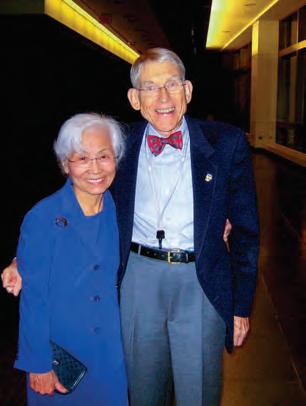
*$10,000 minimum for Charitable Gift Annuities
For more information on Charitable Gift Annuities and other Gift Planning options:
VISIT: deerfield.giftplans.org CALL: 413-774-1584
OR EMAIL: plannedgiving@deerfield.edu
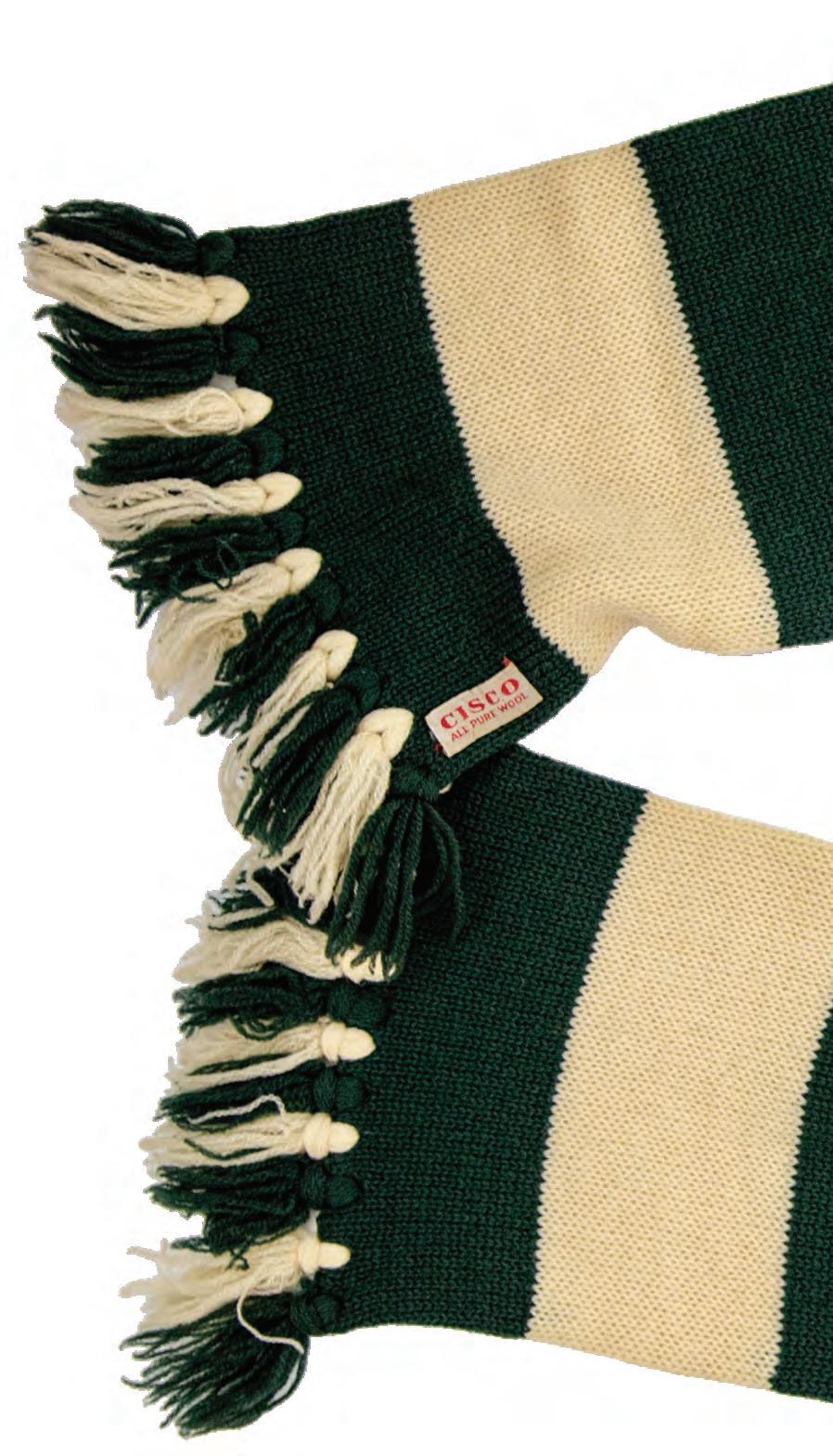
At the airport, returning to Chicago for the Christmas vacation of his sophomore year, Tip Reed ’57 felt a gentle tug on his shoulder. A girl, likely in college, wearing a green-and-white scarf, told Tip that she was meeting her boyfriend, who went to a rival boarding school and would not like to see her wearing a Deerfield scarf. Would he please give it a good home?
A few days later, Tip gave the wool scarf to Linda, a girl he liked. He knew she had been struggling at home. The gesture cheered Linda during a dark time. Tip never forgot their friendship and reconnected with her a decade later. Their families would often vacation together.
Late in life, Tip received a Christmas package from Linda. Imagine his surprise at unwrapping the very scarf he gave his dear friend fifty years ago!
Flattered, he understood that the scarf’s return was Linda’s way of thanking him, acknowledging how this simple and pure gift had so much meaning to her, becoming a cherished keepsake.
Not wanting it lost in some drawer or closet, Tip donated the revered scarf to the Academy Archives as a symbol of kindness and community for others to admire. //

